|
Meinem Lehrer und Freund Prof. Dr. Heinrich von Stietencron ist die gesamte Amarakośa-Übersetzung in Dankbarkeit gewidmet. |
Zitierweise | cite as: Amarasiṃha <6./8. Jhdt. n. Chr.>: Nāmaliṅgānuśāsana (Amarakośa) / übersetzt von Alois Payer <1944 - >. -- 2. Dvitīyaṃ kāṇḍam. -- 14. kṣatriyavargaḥ (Über Kṣatriyas). -- 2. Zweiter Abschnitt (Über Kriegsführung). -- 6. Vers 50c - 61 (Waffen). -- Fassung vom 2011-06-16. -- URL: http://www.payer.de/amarakosa6/amara2142f.htm
Erstmals hier publiziert: 2011-06-16
Überarbeitungen:
©opyright: Creative Commons Lizenz (Namensnennung, keine kommerzielle Nutzung, share alike)
Dieser Text ist Teil der Abteilung Sanskrit von Tüpfli's Global Village Library
|
Meinem Lehrer und Freund Prof. Dr. Heinrich von Stietencron ist die gesamte Amarakośa-Übersetzung in Dankbarkeit gewidmet. |
Falls Sie die diakritischen Zeichen nicht dargestellt bekommen, installieren Sie eine Schrift mit Diakritika wie z.B. Tahoma.
Die Devanāgarī-Zeichen sind in Unicode kodiert. Sie benötigen also eine Unicode-Devanāgarī-Schrift.
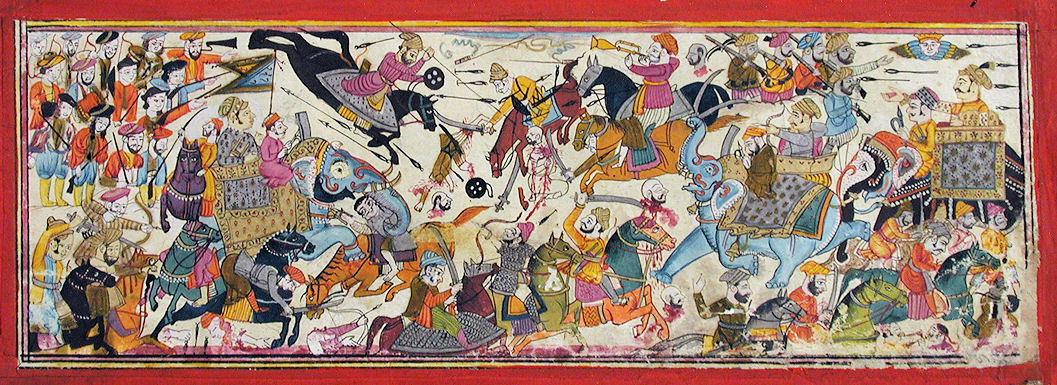
Abb.: Kampfszene, Bhāgavata-Purāṇa-Handschrift, Uttar Pradesh,
ca. 1780
[Bildquelle: Asian Curator at The San Diego Museum of Art. --
http://www.flickr.com/photos/asianartsandiego/4838434662/. -- Zugriff am
2011-04-10. --
Creative Commons Lizenz (Namensnennung, keine kommerzielle Nutzung,
keine Bearbeitung)]
|
50c./d. āyudhaṃ tu praharaṇaṃ śastram astram athāstriyau आयुधं तु प्रहरणं शस्त्रम् अस्त्रम् अथास्त्रियौ ॥५० ख॥ [Bezeichnungen für Waffe:]
|
Colebrooke (1807): "A weapon. Some restrict the last term to a missile weapon ; and the preceding term to a weapon retained in the hand."
आयुध - āyudha n.: Kampfgerät, Waffe
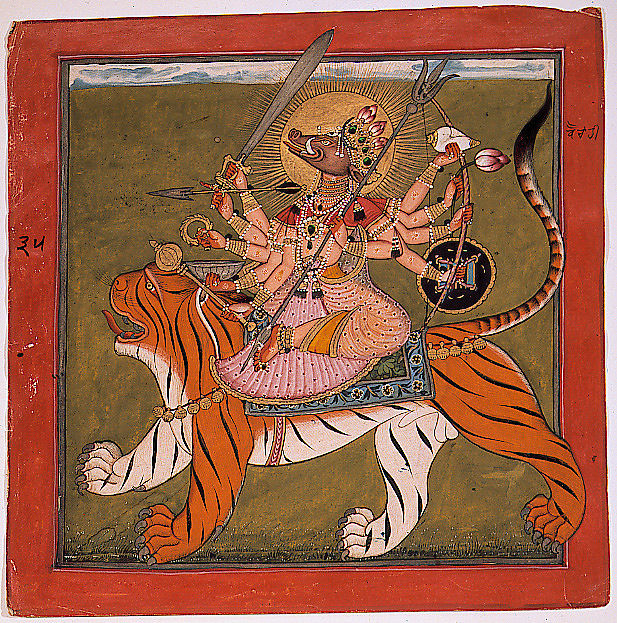
Abb.: आयुधानि । Varāhī mit den Waffen verschiedener Götter, Himachal Pradesh, 1660/70
[Bildquelle: Asian Curator at The San Diego Museum of Art. --
http://www.flickr.com/photos/asianartsandiego/4838446338/. -- Zugriff am
2011-04-14. --
Creative Commons Lizenz (Namensnennung, keine kommerzielle Nutzung,
keine Bearbeitung)]
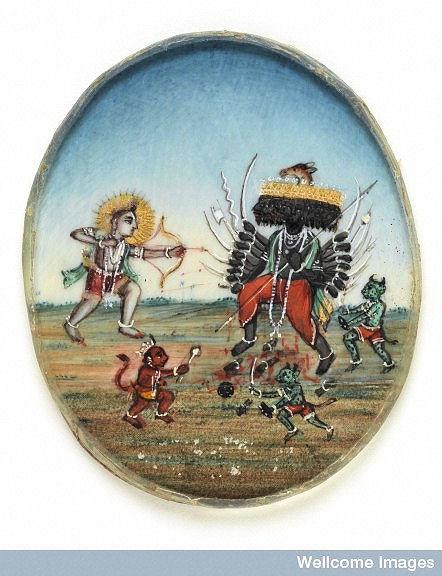
Abb.:
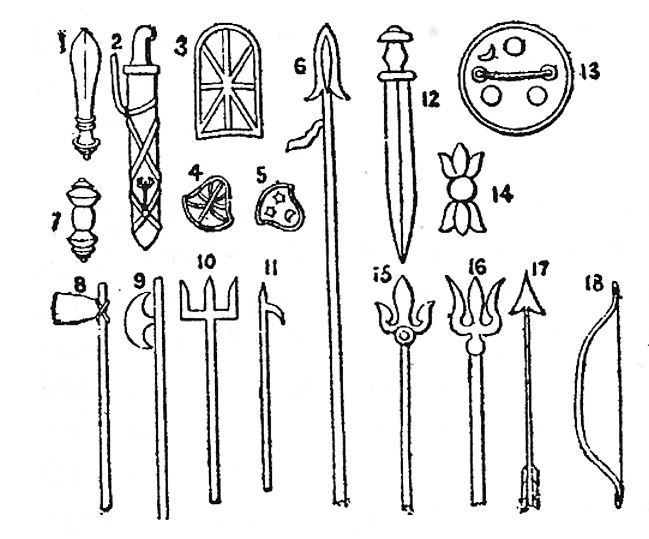
Abb.:
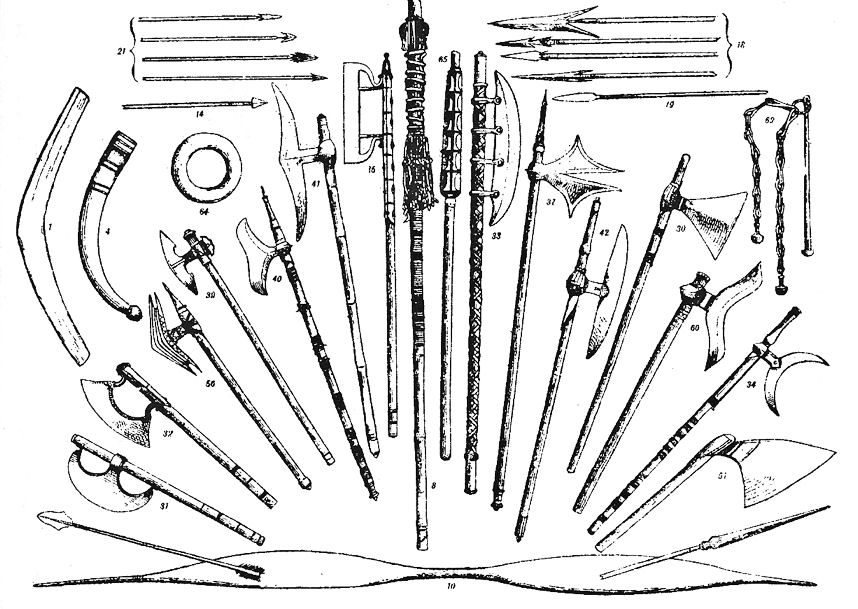
Abb.:
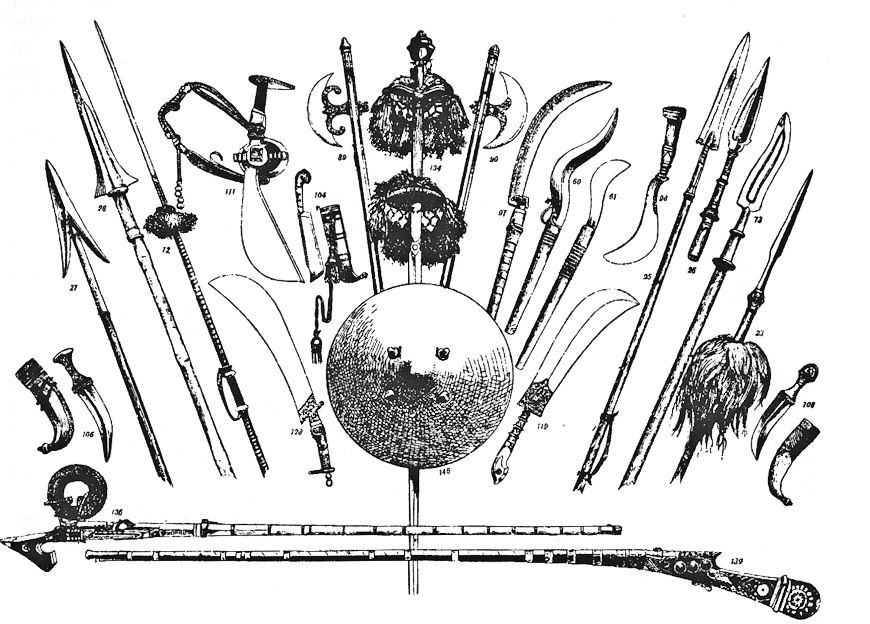
Abb.:
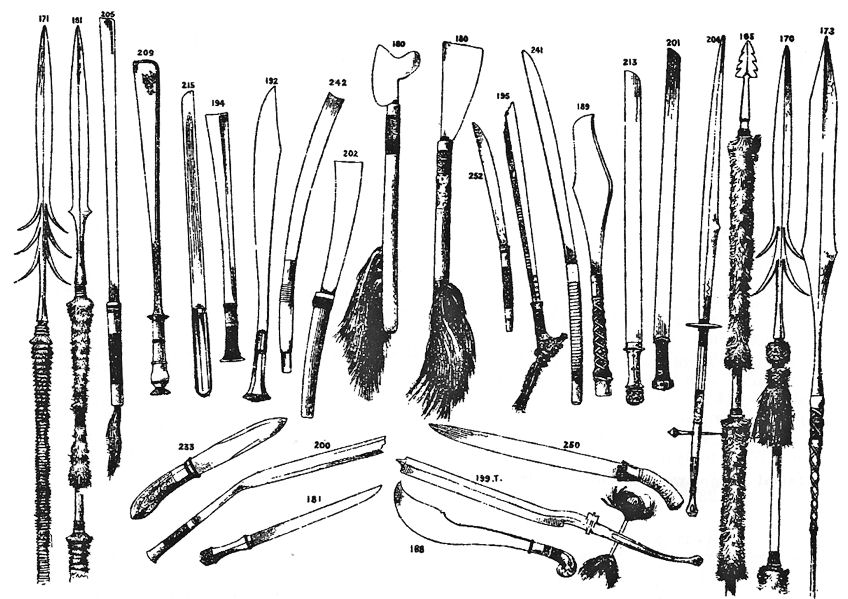
Abb.:
प्रहरण - praharaṇa n.: Angriff, Waffe
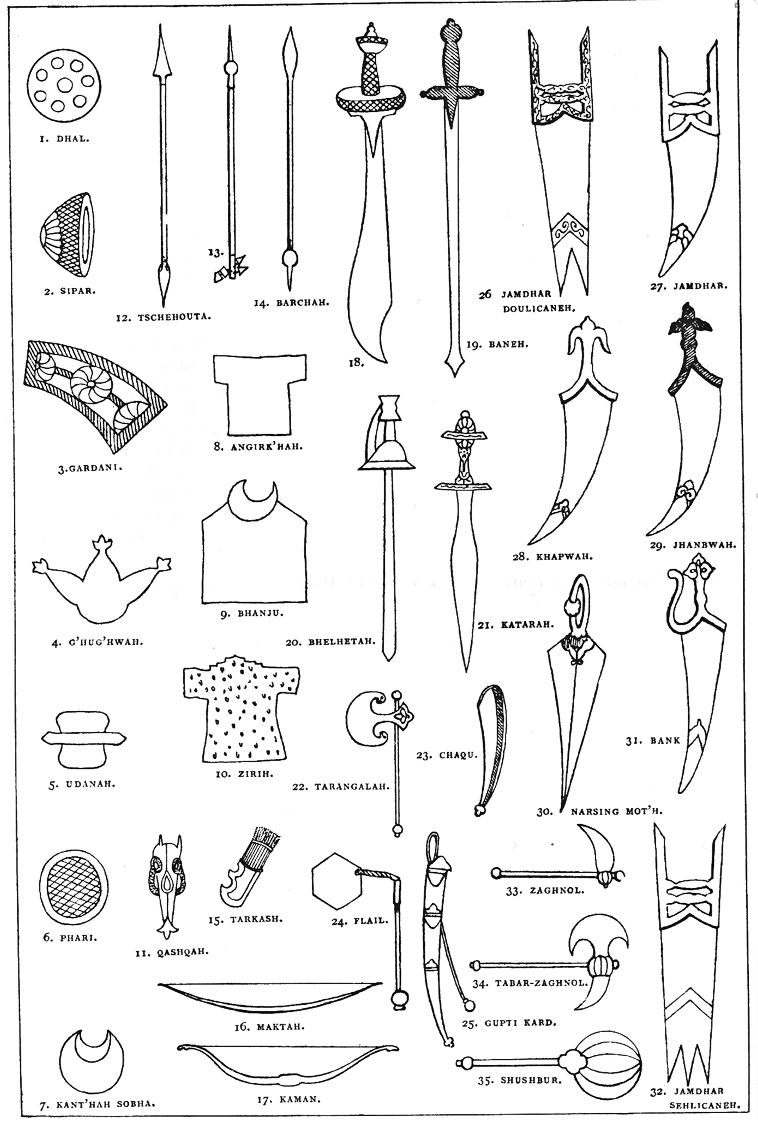
Abb.: प्रहरणानि । Waffen und Rüstungen aus der Zeit Akbars
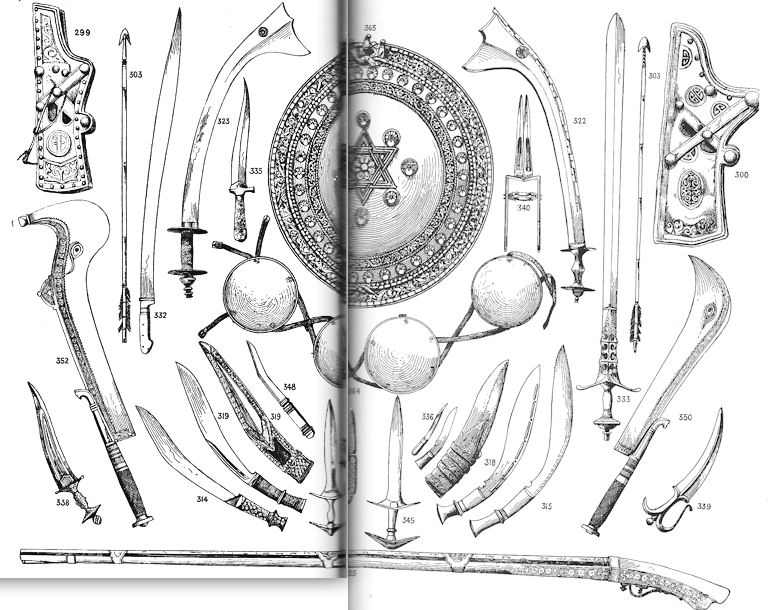
Abb.:
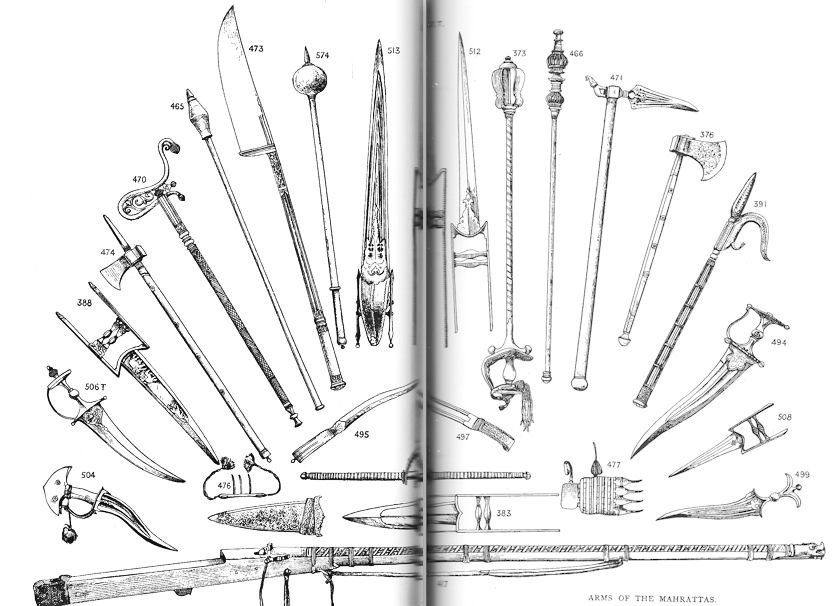
Abb.:
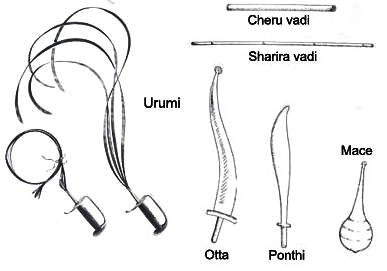
Abb.:
"Achtzehntes Kapitel (36. Gegenstand). Der Aufseher der Waffenkammer.
Der Aufseher der Waffenkammer (āyudhāgārādhyakṣa) soll die für den Kampf, das Verteidigungswerk der eigenen Burgen und den Angriff auf die festen Städte des Feindes nötigen Rädermaschinen, Waffen, Schutzmittel (āvaraṇa) und das Zubehör durch Grob- und Kunsthandwerker des betreffenden Faches anfertigen lassen, denen Umfang der Arbeit, Zeit und Lohn festgesetzt ist, sowie auch wie ihr Erzeugnis ausfallen muss.1
Und er soll sie (diese Erzeugnisse) an den für sie geeigneten Orten unterbringen.2 Er soll dafür sorgen, dass oft ihr Aufbewahrungsort geändert und ihnen Sonne und Lüftung gegeben wird.3 Was von Hitze, eindringender Feuchtigkeit oder Insekten und Würmern beschädigt wird, soll er anders unterbringen. Er soll Kenntnis von ihnen haben nach ihrer Gattung und ihrem Aussehen, ihren bezeichnenden Merkmalen und ihrer Menge, ihrer Herkunft, ihren Preisen und ihrer Aufbewahrungsstelle.
Sarvatobhadra (»Allglücklich, Allherrlich«),4 jāmadagnya,5 bahumukha (»Vielmund, Vielspeier«),6 viśvāsaghātin (»Töter der Ahnungslosen«),7 samghātī (»Zusammensetzung«),8 yānaka (»Wägelchen«),9 parjanyaka (»Regengöttchen, Regelchen«),10 bāhu (»Arm«),11 ūrdhvabāhu (»aufgereckter Arm«)12 und ardhabāhu (»Halbarm«)13 – dies sind die aufgestellten Kriegsgeräte.
Pañcālikā (»die Pañcalerin«),14 devadaṇḍa (»Götterknittel, Götterstrafe«),15 sūkarikā (»Mutterschweinchen«),16 musalayaṣṭi (»Mörserkolbenstange, Keulenstange«),17 hastivāraka (»Elefantenwehrer«),18 tālavṛnta (»Fächer«),19 mudgara (»Hammer«), gadā (»Keule«) spṛktalā (»Fühldiefläche«?),20 kuddāla (»Spaten«), āsphāṭima (etwa »Anklatsch«),21 udghāṭima (»Emporriss«),22 śataghnī (»Hunderttöterin«),23 triśūla (»Dreizack«) und cakra (Wurfscheibe) sind die beweglichen Kriegsgeräte.
Śakti (Lanze),24 prāsa (Wurfspeer),25 kunta (Holzspeer),26 hātaka,27 bhindipāla (Art Speer),28 śūla (Spieß),29 tomara (Wurfspieß),30 varahākarṇaA1 (»Eberohr«),31 kaṇaya,32 karpaṇa,33 und trāsikā (»Erschreckerin«)34 – das sind die Waffen mit messerartiger Spitze (hulamukha).35
Aus Weinpalmenholz, aus »Bogenrohr« (cāpa oder cāpaveṇu), aus Hartholz und aus Horn gemacht, sind die Bogen und heißen dann (nach der Reihenfolge des Materials) kārmuka, kodaṇḍa, druṇa und dhanus.36
Die Bogenschnüre sind aus mūrvā-Hanf (Sanseviera Roxburghiana), den Fasern des arka (Calotropis gigantea), Hanf, gavedhu (Coix barbata),37 Bambusrindenfasern und Tiersehnen.
Bambus (veṇu), śara (Art Rohr, Saccharum Sara, von dem der gewöhnlichste Name des Pfeiles stammt), śalākā (»Splitter, spitzes Holz«), daṇḍāsana (»Stab-Wurfgeschoß«) und nārāca (ganz aus Eisen wie die Kommentatoren gewöhnlich sagen) – das sind die Pfeile.
Ihre Spitzen sind da zum Durchschneiden, Durchreißen, Durchbohren und aus Eisen, Knochen oder Holz gemacht.
Nisṭṛṃśa (»Erbarmungslos«, nach dem Komm. Schwert mit krummer oder geschwungener Schneide), maṇḍalāgra (»Rundschneide«, also Krummsäbel) und Langschwert38 – das die Schwerter.
Die Schwertgriffe sind gemacht aus dem Horn des Rhinozeros oder dem des Büffels, aus dem Zahn des Elefanten, aus Holz und aus der Wurzel des Bambus.
Beil, Axt, paṭṭiśa, Schaufel, Spaten, Säge und kāṇḍacchedana39 sind rasiermesserartige Werkzeuge.
Mit einer Maschine, mit einer Schleuderstange40 und mit der Hand geschleuderte Steine und Mühlsteine sind (ebenfalls) Waffen.
Eisennetz (lohojāla), Eisennetzchen (lohajālikā), Eisenplattenkleid (lohapaṭṭa), Eisenpanzer, (lohakavaca), Fadenharnisch und Gefüge aus Haut, Huf und Horn von Delphinus gangeticus, Rhinozeros, dhenuka (nach Sham. Büffel, nach Gaṇ. Gayal), Elefant und Rind sind Schutzbekleidungen (vārmāṇi), (ebenso) Helm, Halsberge, Kürass (kūrpāsa), Panzerhemd, »Pfeilabwehrer« (vārabāṇa, »geht bis auf die Knöchel«), Panzerweste und Fingerhandschuhe.41
Schilde sind: Korbgeflecht (peṭī) Lederschild, »Elefantenohr (wegen seiner Form)«, tālamūla),42 »Blasebalg« (dhamanikā), »Torflügel« (kavāṭa), kiṭikā (Leichtschild, »Art Schild aus Rohr und Leder«), der »Unwiderstehliche« und der »Wolkenrandige«.43
Kriegszubehör (upakaraṇāni) sind auch: Gerät, das dazu dient, Elefanten, Schlachtwagen und Pferde zu schirren, sowie Sachen, die zu deren Schmuck, und solche, die zur Herrichtung ihrer Ausrüstung für die Schlacht dienen.
(Dazu komen:) Mittel, den Feind durch Gaukeltrug zu täuschen und ihn mit Geheimmitteln zu verderben,44 sowie die Arbeit der Fabriken.
Der Waffenherr (d.h. der Zeughausaufseher) muss auch Kenntnis haben von dem, was gewünscht wird, vom Ausfall der Unternehmungen,45 vom Gebrauch (der Kampfwerkzeuge), von Trug und Stempelwesen,46 sowie von Verlust und Verbrauch der Rohmaterialien.
Fußnoten
1 Vgl. 112, 16 f.; 114, 7, sowie karmaphala »Ergebnis der Arbeit« 115, 17.
2 Svabhūmi der eigene Ort, der für einen günstige Ort, bes. das günstige Gelände im Krieg ist bei Kauṭ. sehr häufig. Siehe z.B. 355, 6; 364, 1 ff.; 367, 3, 11, 19; 388, 15.
3 Parivartayati wird auch vom Untersuchen (»Umwenden«) gebraucht (41, 18), an jener Stelle aber von Kleidern und Schmucksachen. Ob nun sthānaparivartana auch »Untersuchung ihres Aufbewahrungsortes« heißen kann, was hier gut passen würde, weiß ich nicht. Gaṇ. und Jolly haben nach ātapa noch pravāta »Lüftung«.
4 »Hat die Größe eines Karrenrads ... Wirft, wenn umhergewirbelt, Steine nach allen Richtungen«. So Bhaṭṭ., von dem auch die Erklärungen der folgenden Kriegswerkzeuge stammen.
5 Jamadagni ist ein wegen seiner Bogenkunst und Kenntnis aller Waffen bekannter Heiliger der Vorzeit (ṛṣi), Vgl. Weib im altind. Epos 265; MBh. III, 114, 45. Es wäre also wohl die von Jamadagni stammende Waffe »eine große Pfeilschleudermaschine, die man an die Öffnungen der oberen Stockwerke stellt.«
6 »Ist ein Turm, der oben auf die Stadtmauer gestellt wird, mit Leder geschützt ist, drei oder vier Stockwerke hat und Standorte für Bogenschützen. Bogenbewehrte Männer stehen dort und schießen Pfeile nach allen Richtungen.« Bhaṭṭ. Nach ihm auch die folgenden Erklärungen.
7 »Ein wagerechter Balken (parigha), draußen vor der Stadtmauer, der durch eine mechanische Vorrichtung losgelassen wird und tötet.«
8 »Eine Zusammensetzung aus langen Hölzern, eine Feuermaschine, zu dem Zweck, Türme usw. beim Feinde anzuzünden«.
9 Oder yānika. Vielleicht ist saṃghātī- (bei Gaṇ. und Jolly saṃghāṭi-) yānaka ein Wort, so dass also diese Feuermaschine auf Rädern fortzubewegen wäre.
10 »Eine Wassermaschine, Feuer auszulöschen. Andere aber: eine 50 hasta lange Vorrichtung, die über die Stadtmauer hinausgestreckt ist und, wenn sie mittels einer Maschinerie losgelassen wird, tötet, was in der Nähe ist«.
11 »Zwei Pfosten, halb so groß wie der parjanyaka, einander gegenüberstehend; töten, durch eine mechanische Vorrichtung losgelassen.«
12 »Ein aufrecht stehender Pfosten von der Größe des parjanyaka; tötet, mittels einer Maschine losgelassen, alles was in seiner Nähe ist.« – Der »Halbarm« ist dann nur halb so lang.
13 »Ein aufrecht stehender Pfosten von der Größe des parjanyaka; tötet, mittels einer Maschine losgelassen, alles was in seiner Nähe ist.« – Der »Halbarm« ist dann nur halb so lang.
14 Die Pañcāla waren ein Kriegervolk im nördlichen Indien. Diese Waffe scheint von ihnen gekommen zu sein. Nach Bhaṭṭ. ein mit Spikernägeln besetztes Brett, das draußen vor der Stadtmauer ins Wasser gelegt wird, den Feind aufzuhalten.
15 »Ein großer Pfosten, der mit Keilen befestigt ist. Wird oben auf die Mauer gestellt« (und jedenfalls auf den Feind hinabgestürzt).
16 »Ein großer Sack, der aus genähtem Leder gemacht und innen mit Baumwolle, Wolle usw. angefüllt ist. Dient dazu, die Torbauten (gopura), die Türme, den, ›Götterweg‹ (devapatha) usw. zu decken und von außen kommende Steine abzuwehren«. Andere sagen, er sei aus Rohr gemacht und mit Leder überzogen, habe die Gestalt eines Schweins und sei dazu da, zu verhindern, dass der Feind an der Mauer einen Halt bekomme (oder: die Mauer einnehmen könne).
17 »Ein Spieß aus Khadiraholz.« Dies Holz ist sehr hart.
18 »Eine große Stange mit zwei oder drei Spitzen.«
19 »Eine fächerähnliche Scheibe.« Gaṇ. hat noch drughaṇa »Holzkeule«. Er sagt, der drughaṇa sei hammerförmig.
20 »Eine Stange, die mit Stacheln besetzt ist«.
21 Dasselbe wäre āsphālima. Bhaṭṭ. und Gaṇ. lesen āsphoṭima, Vgl. das im Epos häufige āsphoṭayati aufschlagen, klatschen (z.B. Rām. V, 42, 31 f.; MBh. III, 146, 81, cf. 61 f., 63; VII, 180. 4; X, 8, 149, cf. 157; XII, 261, 41) und āsphoṭa in den Wörterbüchern. Nach Bhaṭṭ. ist es eine mit Leder überzogene, mit einer Katapultenstange versehene Maschine, Erde und Steine zu schleudern.
22 C., Bhaṭṭ. und Gaṇ. haben dazu noch utpāṭima. »Utpāṭima ist dazu da, Pfosten und was sonst in die Erde eingegraben ist, herauszureißen, udghāṭima, Türme und Mauern einzureißen.« All diese Wörter auf ima aber sind ihrer Bildung nach passivisch (vgl. z.B. prāvartima 60, 15 f.; 117, 1 ff.). Danach wäre eher an das Abgeschossene selber zu denken, an »das, was man aufschlagen macht«, das »was aufgerissen wird« oder »aufbirst, in Stücke springt«. Wir sind leider auf Bhaṭṭ. angewiesen, obwohl er sicherlich nicht immer zuverlässig ist, ja öfters greifbar Verkehrtes sagt.
23 »Ein mit Keilen beschlagener großer Pfosten, oben auf die Mauer gestellt.« Etwas ähnlich Rāma zu Rām. I, 5, 11: »Eine aus einer Eisenlast gemachte, zur Verteidigung der Stadtmauer dienende, oben auf diese hingestellte Art Waffe«. Befestigt ist sie mit Stricken (Rām. VI, 60, 54). Als auf den Toren postiert und schwer zu handhaben finden wir sie MBh. XII, 69, 45. Geschleudert wird sie z.B. auch Rām. VII, 23, 49; 28, 14 und öfters im MBh. Sogar ein Einzelner schleudert sie da, so dass man mehrere Male an eine einfache Wurfwaffe denkt (z.B. MBh. VI, 113, 39 ff.). Oft hören wir, dass sie sacakrā, cakrayuktā, catuścakrā und dvicakrā sei, also mit Rädern versehen (z.B. VII, 199, 19; VII, 27, 32; 179, 36 ff.). An der letztgenannten Stelle ist sie dick, mit Eisenplatten beschlagen und zerschmettert vier Pferde auf einmal Einige weitere Stellen aus dem MBh. wären: I, 207, 34; V, 87, 30; VII, 97, 29; 114, 82; VIII, 14, 37; 27, 32; 59, 42; IX, 26, 31. Mir ist aber Hopkins, Ruling Caste nicht zur Hand, wo gewiss noch mehr zu holen wäre, als aus den paar Notizen, über die ich im Augenblick verfüge.A2
24 »Ist ganz aus Metall gemacht, 4 hasta lang, hat eine Spitze gleich dem Blatt des Karavīrabaumes und ist hinten (wo man sie anfasst), wie eine Kuhzitze.«
25 »Auch diese ganz aus Metall oder auch mit Holz innen drin, 24 aṅgula lang, mit 2 pīṭha (Rücken, Sham. handle) versehen.« Das gäbe nur anderthalb Fuß.
26 Nach einem von Gaṇ. mitgeteilten Śloka sind die besten kunta 7 hasta lang, die mittleren 6, die kleinsten 5. Ein hasta beträgt anderthalb Fuß. Bhaṭṭ. sagt, der kunta sei von Holz.
27 »Mit drei Spitzen, an Länge gleich dem kunta.«
28 »Gleich dem kunta, aber mit breiter Schneide.«
29 »Śūla ist eine Stange ohne festgesetzte Länge mit nur einer Spitze.« Tomara »eine Lanze mit pfeilförmiger Spitze, 4, 41/2 und 5 hasta lang«.
31 »Ist ein prāsa (Wurfspeer) mit eberohrförmiger Spitze.«
32 »Ganz aus Metall gemacht; hat an beiden Enden eine dreieckförmige Schneide und den Griff in der Mitte. Ist 20, 22 und 24 aṅgula lang.«
33 »Dies ist ein mit der Hand geworfener Pfeil, gleich einem tomara.« Ein von Gaṇ. mitgeteilter Śloka sagt, er wiege 7 karṣa, 2 pala und 9 karṣa, je nach seinen drei Arten. Er erscheint z.B. auch MBh. K VIII, 85, 12.
34 »Von der Größe eines prāsa und ganz aus Metall.«
35 Gaṇ. hat die von Sham. vorgeschlagene Lesart halamukhāni, also »mit pflugscharähnlicher Spitze«. Wir müssen eben im Gedächtnis behalten, dass die urtümliche Pflugschar nur eine Art Spitze ist (der Pflug ist ein »Holz mit eiserner Spitze« [kāṣṭham ayomukham] Manu X, 84; MBh. XII. 262, 46).A3
36 Gaṇ. hat denselben Text wie Sham. Wunderlich aber ist da zunächst, dass so eine gewöhnliche Bogenart wie śārṅga nicht erscheint, dagegen aber die allgemeine Bezeichnung dhanus als einzelne Bogenart. Sodann müsste nach dem sonst streng durchgeführten Schema der Gattungsname am Ende kommen. Der ist nun dhanūṃṣi. Endlich deutet das lange ā von druṇa auf einen Verlust; denn nur das Neutrum hat die Bedeutung Bogen. Folglich wird zu lesen sein: kārmukakodaṇḍadruṇacārṅgāni dhanūṃṣi: »Die Bogen sind gemacht aus Weinpalmenholz ... und heißen dann (nach der Reihenfolge des Materials): kārmuka, kodaṇḍa, druṇa und śārṅga.« Druṇa, von derselben Wurzel wie dāru, heißt also »das Hölzerne«. Dārava aus dāru gemacht, könnte auf Pinus deodara bezogen werden. Doch heißt es gewöhnlich allgemein: »von Holz«. Dass Hartholz dazu verwendet wird, ist selbstverständlich.
37 Hier hat auch Gaṇ. gavedhu. Aber auch an unserer Stelle wird Sida retusa, nicht Coix barbata, gemeint sein.
38 Asiyaṣṭi »Schwertgerte«, ein gewöhnlicher Ausdruck für Schwertklinge. Bhaṭṭ. sagt, diese Waffe sei breitklingig, dünn und lang.
39 »Stammzerschneider, Stammfäller,« Art große Axt nach dem Komm. Natürlicher schiene mir »Stammzerspalter«, (eiserner) Keil. Vom Beil (paraśu) heißt es bei Bhaṭṭ., es sei ganz aus Metall gefertigt, 24 aṅgula lang und habe ein halbmondförmiges Blatt. Paṭṭiśa (oder wie Sham., Jolly und Gaṇ. drucken, pattasa, was nur eine Dialektform sein wird) ist nach Bhaṭṭ. eine Art dreispitziges Beil. Seine andere Erklärung: »Metallstange mit Dreispitz an beiden Enden« ist wenigstens hier ein Unsinn. Das wäre ein sauberes Werkzeug für sterbliche Menschen. Die gleichnamige Waffe wird von Nīl. im MBh. (z.B. I, 19, 14 f.) als eine Art zweischneidiges, scharfes Schwert erklärt. Die drei Spitzen aber erscheinen auch sonst. Hier wäre am ehesten eine Art Karst, hackenartig unten, zinkig oben, zu vermuten, oder vielleicht eine zweischneidige Axt. Allem Anschein nach wurde dies Werkzeug zum Kampf und zur Arbeit gebraucht.
40 Goṣpaṇa bedeutet nach Sorabji »Katapult«. Bhaṭṭ. aber sagt: goṣpaṇākhyayaṣṭiviśeṣaḥ, und bei der Deutung von āsphoṭa 101, 18 heißt es bei ihm: sagoṣpaṇayaṣṭyupeta. Katapult scheint hier etwas ungeschickt, weil dieser ja eine Art yantra oder Maschine ist, was freilich auch von goṣpaṇayaṣṭi gilt. Eine katapultähnliche Vorrichtung haben wir auf jeden Fall.
41 Wörtlich wohl »Schlangenbäuchlein«. Der Vergleich der menschlichen Finger mit Schlangen ist aus dem Nalalied bekannt. Das »Eisennetz« bedeckt nach Bhaṭṭ. den ganzen Leib mit Einschluss des Kopfes, das »Eisennetzchen« lässt den Kopf frei, beim »Eisenplattenkleid« (oder »Eisenzeugkleid«) sind die Arme (und natürlich auch der Kopf) unbedeckt, während der »Eisenpanzer« Brust und Rücken schützt. Wahrscheinlich aber sollte statt »Eisen« »Metall« (loha unedles Metall) stehen. Es ist mit Gaṇ. zu lesen: lohajālajālikāpaṭṭakavacasūtrakaṃkata-. So allem Anschein nach auch Bhaṭṭ.
42 »Weinpalmenwurzel«? »Cymbelboden«? Bhaṭṭ. sagt: »Ein Schild aus Holz.«
43 Dasselbe wie der »Unwiderstehliche, aber die Ränder von Eisenstreifen umschlungen«. Was aber der Unwiderstehliche selber ist, erklärt auch Gaṇ. nicht näher. Jedenfalls ist es ein Schild aus Holz und besonders stark.
44 Als Beispiele des Gaukeltrugs (aindrajālika) erwähnt Bhaṭṭ.: ein kleines Heer als groß und ein Feuer vorzutäuschen. Genaueres gibt Kām. XVIII, 60–61: »Durch Gaukeltrug zeigen sie dem Feinde: Wolken, Finsternis, Regen, Feuer, Berge und Heere in der Ferne mit ihren Bannern, Verstümmelte, Zerfetzte, Blutüberströmte, um die Feinde in Angst zu setzen.« Im Verlauf des Werkes und besonders im vorletzten oder 14. Buch werden wir eine ganze Blütenlese der Mittel, die auf der Geheimlehre beruhen (aupaniṣadika), kennen lernen.
45 Also wohl: alle möglichen Unternehmungen, die ausgeführt werden. Oder: wie man Unternommenes zustande bringt? Gaṇ. zieht kārmāntānaṃ ca zum Schlussvers, so dass also in ihm durchweg von Dingen die Rede wäre, die mit den Fabriken zusammenhängen. Das lässt sich nicht halten.
46 Also alles, was auf Siegelung, Stempelung, Marken Bezug hat, hier wohl vor allem die Pässe (mudrā). Ich lese vyājamudriyaṃ oder -mudrikaṃ. Dies könnte auch heißen: »alles dessen, was mit falschen Stempeln und Pässen zusammenhängt«. Dass diese Dinge für einen Mann im Kriegsfach wichtig sind, liegt auf der Hand. Ob aber meine Besserung das Richtige trifft, steht auf einem anderen Blatt. Vyājim wird, abgesehen von der Ungehörigkeit der vyājī an unserer Stelle, dadurch ausgeschlossen, dess Kauṭ. nur die Form vyājī kennt. Uddeyam und unneyam (Bhaṭṭ. und Gaṇ.) = lābham scheint weder sprachlich annehmbar, noch fügt es sich in den Vers. Verswidrig ist auch vyājam ubhayam, wie C. zu verbessern wäre. Möglich schiene vyājamad dvayam (die trugvolle Zweiheit) oder vyājam adbhutam: »Trug und Wunderbares«. Beides entspräche dem aindrajālikam aupaniṣadikaṃ ca. Vgl. das adbhutotpādāna im 14. Buch (Kap. 2).
A1 Lies varāhakarṇa.
A2 Außer dem Epos, über dessen Waffen man bekanntlich viel bei Hopkins, Ruling Caste findet, bringt auch Agnipur. Kap. CCXLVff. eine reiche Sammlung, ganz zu schweigen von Śukran. IV, 7, 381ff., wo uns sogar Kanonen mit und ohne Granatkugeln vorgefahren werden!
A3 Nach Śukran. IV, 7, 429 ist der kunta 10 hasta lang und hat eine Pflugscharspitze."
[Quelle: Kauṭilya: Das altindische Buch vom Welt- und Staatsleben : das Arthaśāstra des Kauṭilya / [aus dem Sanskrit übersetzt und mit Einleitung und Anmerkungen versehen von] Johann Jakob Meyer [1870-1939]. -- Leipzig, 1926. -- Digitale Ausgabe in: Asiatische Philosophie. -- 1 CD-ROM. -- Berlin: Directmedia, 2003. -- (Digitale Bibliothek ; 94). -- S. 153 - 157.]
"The classification [of arms] adopted by the Hindus differs considerably in different works. The most common arrangement is a twofold one, including under one head all missiles (astra) and under another, all non-missiles (śastra).
The former is then subdivided into four orders, viz:—
1st, missiles cast by machines, yantramukta ;
2nd, ditto hurled with the hand, pāṇimukta ;
3rd, ditto hurled by force of spells, mantramukta ;
and 4th, arms that can be hurled and then retracted, muktasandhārita.
The second class included two orders.
In Wilson's Essay " On the Art of War as known to the Hindus," the classes and orders are reckoned together. This is based closely on the Agni Purāṇa which gives a fivefold division, thus:
missiles cast by machines, such as bows;
cast by the hand, such as javelins;
retractive missiles, such as the lasso and the boomerang;
non-missiles, such as spears, &c.;
natural weapons, as the fist."
[Quelle: Mitra, Rājendralāla <1824-1891>: Indo-Aryans: contributions towards the elucidation of their ancient and mediaeval history. -- London : Stanford, 1881. -- 2 Bde. : Ill. ; 23 cm. -- Bd. 1, S. 296]
"A typical sea of weapons is casually presented in the following passage (vii. 178.23 ff.): 'they rained upon each other with a stream of weapons—iron clubs, spits, swords, knives, darts, arrows, wheels, axes, iron balls, staves, cow-horns, mortars,' etc., with a last resort to trees torn up, and other native resources of half-demoniac beings such as here engaged. In this passage, under 'clubs,' we have four kinds mentioned, (gadā, parigha, pināka, musala); lances and darts are trebly named (prāsa, tomara, kampana); arrows are of three names (bhalla, śara, nārāca); and there remains the cow-horn and bhindipāla (the former doubtful), and the mortar (ulūkhala); with iron balls that are probably slung or dropped heated on the foe.
But perhaps the best example may be drawn from the opening of the battle-scenes, already referred to for many special kinds of arms. Here we read how the great mass of soldiers drew out in array, and what the arms were: of the common soldier first, and then specially of the knights (v. 155.1 ff.). 'Now the king drew out his forces and divided his eleven armies according to their highest work, their medium ability, and their worthlessness. Then they advanced, armed and provided with the chariot-planks,' with large quivers, with the 'leather protectors of the war-car,' 'with javelins,' and 'quivers for horse and elephant,' with the foot-soldiers' quivers, with metal spears, with heavier wooden-handled spears, with flags and banners, 'with heavy arrows,' with cords and nooses, 'with blankets, with hair-seizers ;' with jars of oil, molasses, or melted butter, sand, and snakes ; with lighted (?) powder of pitch, with bell-hung spears or swords, with 'water heated by iron balls,' and stones, with spits and spears, with 'missiles of wax melted,' and hammers, with trident or spiked staves, with ploughshares and darts (javelins) that are poisoned, with 'baskets with which to fling hot balls, and the box containing these balls resting in the baskets,' with hooked-lances, with wooden breast-plates, with weapons concealed in wood, with 'blocks of wood with iron spikes,' with tiger and leopard skins 'for man and war-car,' with dart and horn, with crooked javelins, with axes, spades, and oil of sesame and flax, and gilded nets. Such was the array of the Kurus, excluding the chariot-description following, where we also find javelins, bows, etc.
These weapons are all retained or discharged by the hand. No mention of the nivartana, or property of (discharging, prayoga, and) recovering missiles, would lead us to suspect a specially adept band of lassoists or boomerangists, though the exercise of this art gave rise to the nivartana superstition, and the latter is elsewhere in the Epic one of the forms of magic power gained by religious meditation. The nooses rarely come prominently into action. They were cast from the raised hand. The iron balls do not appear to be more than one of the beloved missiles mentioned as stone, sand, pitch, potted snakes, etc., etc.—crude and brutal roughness all.
The barbarians are not worse than the natives as to their arms, but are occasionally spoken of in an angry way as using un-Aryan methods. What could be more Aryan, however, than the arms poured out upon Arjuna by the barbarians in general (mlecchas) ? 'They cast upon him the eared reed arrows and iron arrows, the javelins, darts, spears, clubs, and bhindipālas' that the Aryans themselves used. But we learn that the Kirātas use poison (and appear to be blamed for it!); that the Kāmbojas are particularly 'hard to fight with'; that the barbarians generally are 'evil-minded'; that the Śakas are 'strong as Indra' (vii. 112.38 if.); that the barbarians generally use 'various weapons'; that the Kāmbojas, again, are 'cruel and bald'; that the Yavanas carry especially arrows and darts; and that the mountaineers, Parvatīyas, are proficient in throwing stones, an art the Kurus are asserted to be unfamiliar with."
[Quelle: Hopkins, Edward W. (Washburn) <1857 - 1932>: The social and military position of the ruling caste in ancient India; as represented by the Sanskrit epic; with an appendix on the status of woman. -- Reprint from the 13th volume of the Journal of the American Oriental Society (1888). -- New Haven, Conn. : Tuttle, 1889 -- S. 293ff.]
|
50c./d. āyudhaṃ tu praharaṇaṃ śastram astram
athāstriyau 51a./b. dhanuś-cāpau dhanva-śarāsana-kodaṇḍa-kārmukam 51c./d. iṣvāso 'py atha karṇasya kālapṛṣṭhaṃ śarāsanam
आयुधं तु प्रहरणं शस्त्रम् अस्त्रम् अथास्त्रियौ ॥५० ख॥ [Bezeichnungen für Bogen:]
|
Colebrooke (1807): "A bow."
Siehe auch Vers 37a/b.
1 kṛmuka-Holz: von mir nicht identifiziert.
धनुस् - dhanus m., n.: Bogen
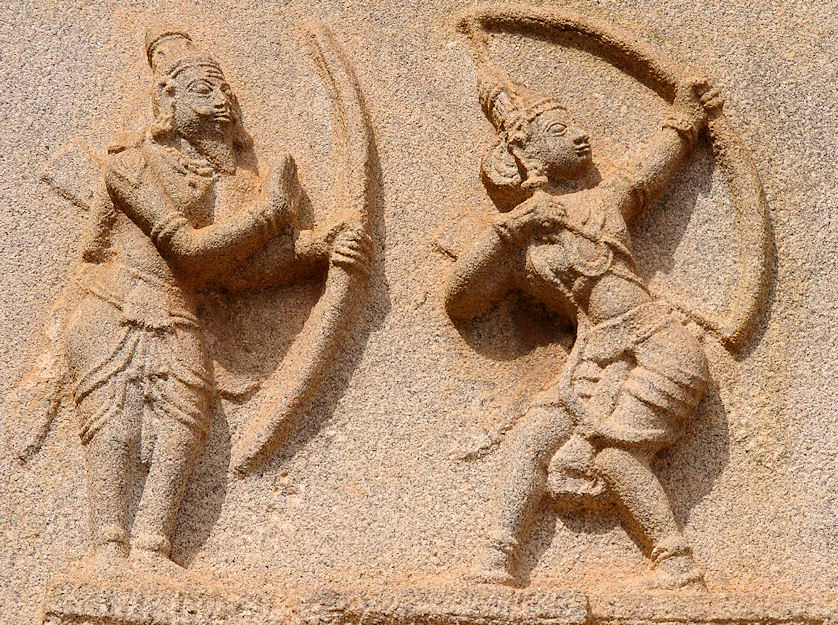
Abb.: धनुषी । Bogenschützen, Hampi - ಹಂಪೆ,
Karnataka
[Bildquelle: Andrea Kirkby. --
http://www.flickr.com/photos/andreakirkby/5427449429/. -- Zugriff am
2011-04-16. --
Creative Commons Lizenz (Namensnennung, keine kommerzielle Nutzung)]
चाप - cāpa m., n.: Bogen
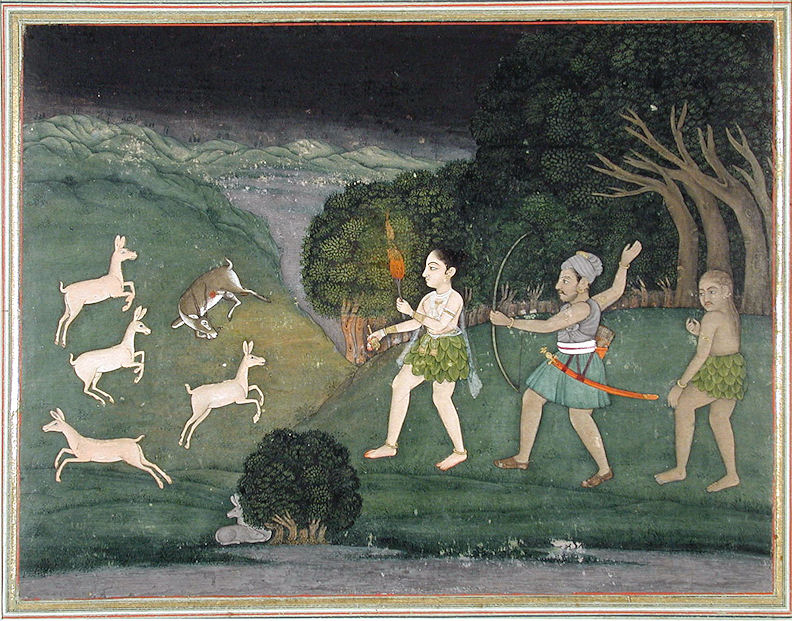
Abb.: चापः । Bhil (भील) Jäger, Uttar Pradesh, ca. 1770
[Bildquelle: Asian Curator at The San Diego Museum of Art. --
http://www.flickr.com/photos/asianartsandiego/4835704133/. -- Zugriff am
2011-04-15. --
Creative Commons Lizenz (Namensnennung, keine kommerzielle Nutzung,
keine Bearbeitung)]
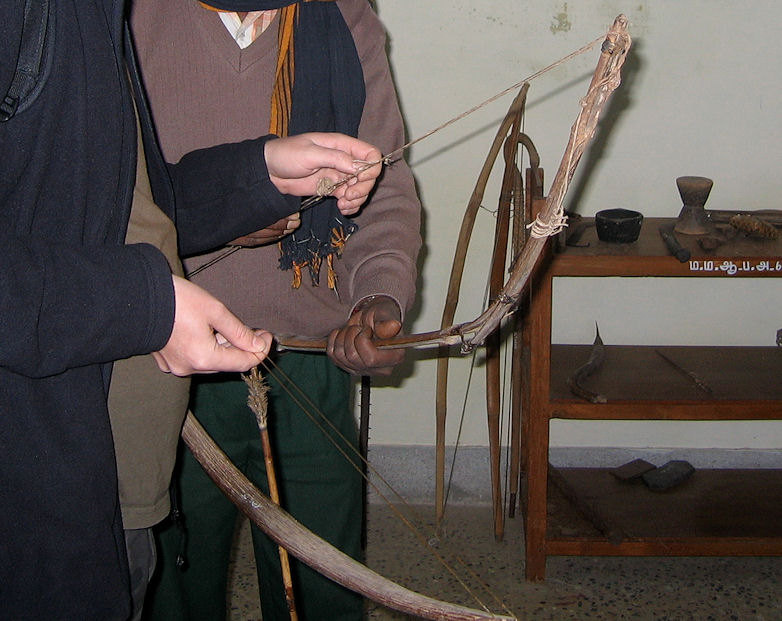
Abb.:
धन्व - dhanva n.: Bogen
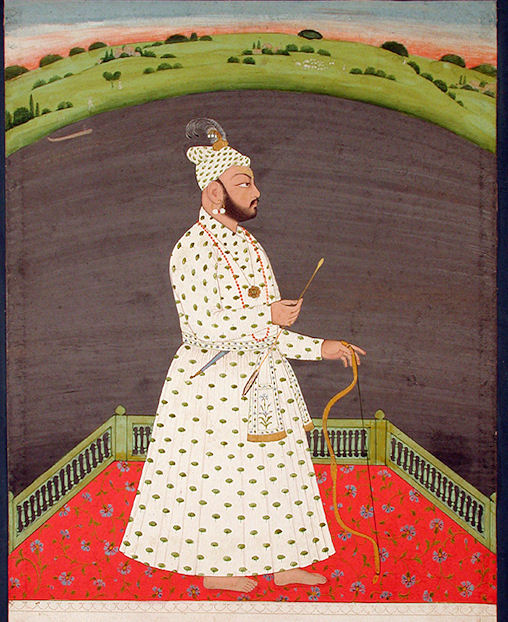
Abb.: धन्वम् । Bishan Singh mit Pfeil und Bogen, Himachal Pradesh, ca. 1780
[Bildquelle: Asian Curator at The San Diego Museum of Art. --
http://www.flickr.com/photos/asianartsandiego/4838494632/. -- Zugriff am
2011-04-15. --
Creative Commons Lizenz (Namensnennung, keine kommerzielle Nutzung,
keine Bearbeitung)]
शरासन - śarāsana n.: "Pfeilschleuderer", Bogen
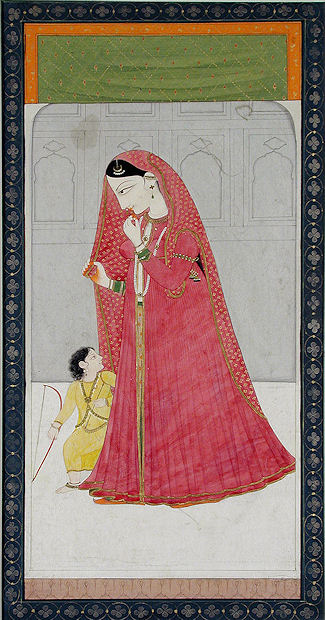
Abb.: शरासनम् । Kind mit Bogen, Himachal Pradesh, ca. 1820
[Bildquelle: Asian Curator at The San Diego Museum of Art. --
http://www.flickr.com/photos/asianartsandiego/4837872801/. -- Zugriff am
2011-04-15. --
Creative Commons Lizenz (Namensnennung, keine kommerzielle Nutzung,
keine Bearbeitung)]
कोदण्ड - kodaṇḍa n.: Bogen
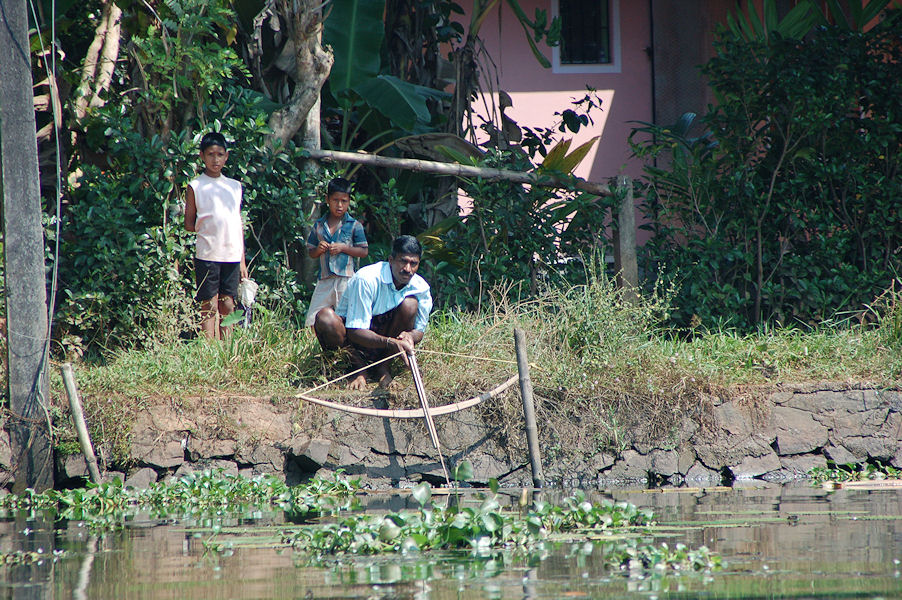
Abb.: कोदण्डम् । Pfeilfischen, Kerala
[Bildquelel: Matthew Stevens. --
http://www.flickr.com/photos/matthewstevens/5407096624/. -- Zugriff am
2011-06-14. --
Creative Commons Lizenz (Namensnennung, keine kommerzielle Nutzung,
keine Bearbeitung)]
कार्मुक - kārmuka n.: wirksam, aus kṛmuka-Holz, Bogen
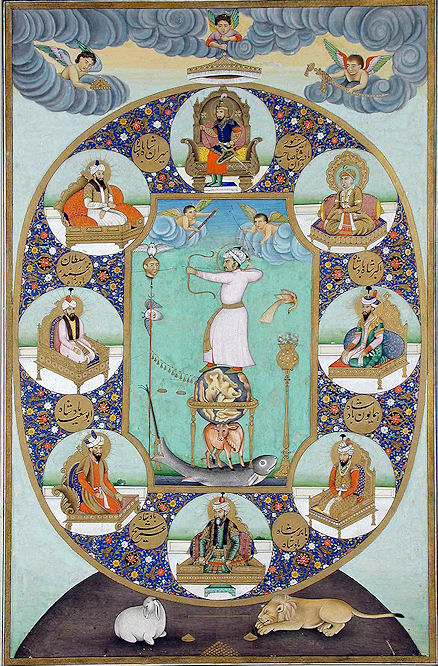
Abb.: कार्मुकम् । Nur-ud-din Salim Jahangir (نورالدین
سلیم جهانگیر) (1627 - 1569), Delhi, 19. Jhdt.
इष्वास - iṣvāsa m.: "Pfeilschleuderer", Bogen, Pfeilschütze
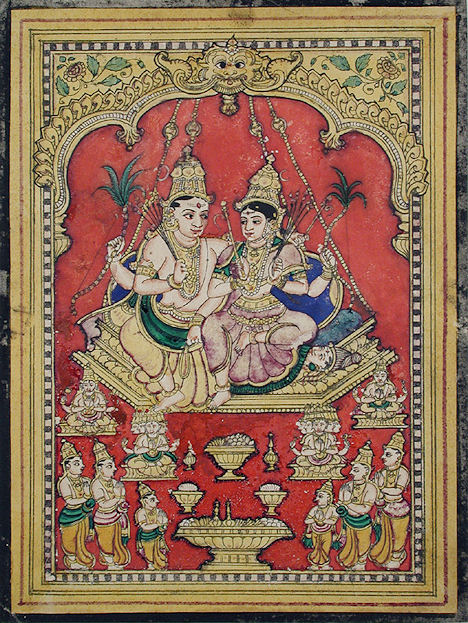
Abb.: इष्वासौ । Kāma und Rati, Lithographie, Mysore -
ಮೈಸೂರು, heute Karnataka, ca. 1845
"Bogen, eine Waffe zum Schießen von Pfeilen oder Kugeln.
Fig. 1. Einfacher Bogen.Der einfache Pfeilbogen (Fig. 1) ist ein elastischer, fester, in der Regel aus Holz oder Bambus, sehr selten aus Horn bestehender, 0,8–3 m langer Bügel, dessen beide Enden mittels einer aus tierischer Sehne, Pflanzenfaser, Rottang etc. gefertigten Sehne straff miteinander verbunden sind. Er ist der ursprünglichste und auch heute noch am weitesten verbreitete Bogen; er war die einzige in Europa gebräuchliche Form, herrschte ursprünglich, mit je einer Ausnahme, in Afrika und Ozeanien und kam auch für den bei weitem größten Teil Amerikas allein in Betracht.
Fig. 2. Andamanenbogen.In der Regel aus vollem Holze derart hergestellt, dass beide Bogenhälften von gleicher Stärke sind, gibt es in Afrika, Neuguinea, auf den Andamanen und den Neuen Hebriden Bogen, die einfach aus einem Baumzweige bestehen, so dass das obere, dünnere Ende schwächer und biegsamer ist als das andre. Der Bogen der südlichen Andamanen (Fig. 2) besitzt die Gestalt eines zweiblätterigen Ruders. Ähnliche Formen kommen bei den Oregonindianern, am Schirefluß und am Nyassasee vor. Der zusammengesetzte Bogen (Fig. 3) ist ursprünglich auf Asien beschränkt; von Vorderasien ist er dann auch nach den Mittelmeerländern und Nordafrika übertragen worden.
Fig. 3. Zusammengesetzter Bogen.Seinem Bau nach besteht er in jedem Fall aus einem Holzkern, der in der Gegend des Griffes rund, sehr dick und nahezu vollig starr ist, aber sich nach der Seite rasch abflacht und sehr dünn wird. An diesen Holzkern legen sich dann als andre, durch geeignete Manipulationen mit jenem innig verbundene Bestandteile: Sehnenfasern, Hornplatten oder -Stäbe, Holzplatten andrer Art, Bambus etc. Das Ganze wird mit Leder, bei den arktischen Völkern mit Birkenrinde umwickelt; die Japaner überziehen ihren zusammengesetzten Bogen aus drei Holzlängenstreifen, von denen der innerste hartes Holz, die beiden andern, äußern, Bambus sind, außerdem noch mit einem vortrefflichen Lacküberzug.
Fig. 4. Kugelbogen, Hinterindien.Bemerkenswert ist, dass die Größe des zusammengesetzten Bogens in Asien von Westen nach Osten zunimmt; am kleinsten ist der türkische, gleichzeitig ist er auch der wirksamste.
Der größte ist der mächtige Bogen der Chinesen. Von den einfachen Bogen hat die geringste, nur etwa 80 cm betragende Länge der Bogen der Waldvölker des zentralafrikanischen Iturigebietes; dagegen erreichen die Bogen der Indianer am Rio Negro eine Länge von 3 m. Eine Ab- oder Unterart des zusammengesetzten Bogens ist der verstärkte Bogen In der Hauptsache aus einem langen Stabe bestehend, wird er durch Anfügen von dünnen Holzleisten, durch Anwickeln von Sehnen, Ausziehen von Ringen, Umwickeln mit Sehnen etc. elastischer und kräftiger gemacht. Solche verstärkte Bogen gibt es in Alaska, in Westpolynesien, auf Neuguinea und bei den Pygmäen am Kivusee in Afrika.
Eine in Hinsicht auf das Geschoß merkwürdige Abart des Bogens ist der Kugelbogen (Fig. 4). Statt der Pfeile schleudert er taubeneigroße Tonkugeln nach dem Ziele (Vögeln und andern kleinen Tieren). Er kommt in Hinterindien und dem nordöstlichen Südamerika vor und besteht entweder aus zwei, durch Stege verbundene Einzelbogen, zwischen denen das Geschoß dann durchfliegt (Fig. 4), oder einem einfachen Bogen, dessen Enden so gebogen sind, dass die Geschoßebene seitlich zu der Handhabe vorbeiführt.
Verschieden wie die Gestalt, der Bau und das Material der Bogen ist ihre Spannweise. Meist ist sie so straff, dass beim Schuss die vorschnellende Sehne die linke Hand nicht berührt; in andern Fällen würde sie diese indes empfindlich treffen, wenn nicht Schutzmaßregeln getroffen würden. Derartige Hand- und Armschutzapparate haben die Form von Platten, Riegeln, Ringspiralen, Kissen, Binden etc. Platten aus Stein, Knochen oder gebranntem Ton sind schon aus vorgeschichtlicher Zeit bekannt; von heutigen Naturvölkern führen derartige Schutzapparate verschiedene Völker Afrikas (Warundi, Obernilvölker, Waldvölker am Ituri, die Wute in Kamerun, die Salomoninsulaner u. a.).
Fast alle alten Völker, Assyrer, Indier, Kreter, Numidier, Skythen, führten den Bogen In den Heeren der Perser und Karthager gab es viele Bogenschützen.
Bei den Griechen, die kunstvoll gearbeitete Bogen aus Antilopengehörn besaßen, waren, wie bei den Römern, die Schützen nicht besonders geachtet, sondern man überließ diese Kampfweise gern geworbenen Hilfsvölkern. Später machte Mohammed den Gebrauch des Bogens zur Religionspflicht, und Türken, Perser, Araber stellten vorzügliche Schützen; auch Hunnen und Mongolen (russisch-tscherkessische Truppen noch 1813) führten den Bogen, dagegen benutzten die Germanen ihn fast nur zur Jagd und ungern im Kriege, wo sie lieber das Wurfbeil und den Wurfspieß brauchten. Erst im Mittelalter kommt er hier mehr in Gebrauch, besonders die englischen »Bogner«, die Flanderer, Burgunder etc. (vgl. Archers) waren sehr berühmt. Der englische Bogen war 1,8, der deutsche 1,2, der italienische 1,5 m lang, erstere beiden meist von Eibenholz, letzterer von Stahl gefertigt. Zur Aufnahme der bis 1 m langen Pfeile (vgl. Pfeil und Pfeilgift) diente der an der rechten Schulter oder am Gürtel getragene Köcher (Fig. 8 u. 9, S. 139). Als Sport wird das Bogenschießen heute noch in England, Frankreich, Belgien und besonders in der Schweiz betrieben. Als höchste Schussweite werden für den Bogen angegeben aus dem Altertum 500 m, aus Sportkreisen der Neuzeit 800 m.
Vgl. Hansard, The book of archery (Lond. 1845); Longman und Walrond, Archery (das. 1894); v. Luschan, Über den antiken Bogen (Benndorf-Festschrift 1898); Derselbe, Zusammengesetzte und verstärkte Bögen (»Zeitschrift für Ethnologie«, 1899); Boeheim, Bogen und Armbrust (»Zeitschrift für historische Waffenkunde«, Bd. 1, 1898); Ratzel, Die afrikanischen Bogen, ihre Verbreitung und Verwandtschaft (»Abhandlungen der Königlich Sächsischen Gesellschaft der Wissenschaften«, Leipz. 1891); Herrm. Meyer, Bogen und Pfeil in Zentralbrasilien (das. 1895); B. Adler, Die Bogen Nordasiens (»Internationales Archiv für Ethnographie«, Bd. 15, 1902); Demmin, Die Kriegswaffen in ihrer geschichtlichen Entwickelung (Leipz. 1893); Mason, North American bows (»Reports Smithsonian Institution«, 1894); Jähns, Entwickelungsgeschichte der alten Trutzwaffen (Berl. 1899)."
[Quelle: Meyers großes Konversations-Lexikon. -- DVD-ROM-Ausg. Faksimile und Volltext der 6. Aufl. 1905-1909. -- Berlin : Directmedia Publ. --2003. -- 1 DVD-ROM. -- (Digitale Bibliothek ; 100). -- ISBN 3-89853-200-3. -- s.v.]
"The bow: This is the weapon
κατ' εξοχην for, as in the Veda, āyudha is both the general word for weapon and, without limitation, for the bow. More specific names for this weapon are the commonly used words dhanus, cāpa, śarāsana, and (from their material) kārmuka, śārṅga.The 'bowman' is often synonymous with 'charioteer,' but may be used of footmen in the field. The end of the bent bow was the place whence, as the descriptions show, the arrow was shot; and I take it this means that the bow was bent into a circle, so that the arrow head seemed to lie back of the two bow-ends.
The favorite material for making this weapon is the kṛmuka wood, and this word used alone as adjective indicates the bow. The horn-bow appears, however, to nave been the best, for it was this that Viṣṇu used. The Greeks report at an early date the use of cane bows by the Hindus, as well as of iron-tipped cane arrows. The length of the bow is several times spoken of as tāla-mātra, a 'palm' long, which, when compared with the numerical qualification employed in ṣaḍaratni, may probably be interpreted as six cubits in length. But we hear of the bow of a demon being a cubit broad and twelve cubits long, and the shooting-strifes for a wife in the Epic and in the Rāmāyaṇa alike would indicate an (unusual) use of very heavy bows : the scene in the Epic representing far-distant shooting; that in the Rāmāyaṇa, expressly a weighty bow. According to Egerton, five feet is the ordinary length of the Hindu bow (generally of bamboo). As in the Vedic age, the knight held the bow as high as possible: that is, with the shaft level to the eye, and well forward, pulling the arrow back to his ear; and he must therefore have raised the bow perpendicularly, not horizontally, and not have pulled, as did Homer's heroes, to the breast. The great bow so pulled looked like a crescent, or, in view of its terrible appearance, is likened to the weapon of Indra.
Arjuna alone is 'left-handed' (savyasācin), or, more truly, ambidexter, and uses either hand to draw the string.
The string (jyā) of the bow should be made of mūrva-grass. It is a mistake to suppose that (as the Nītip. teaches) the bow was strung with two cords at once. The cord is noosed at each end, and consists of different strands, but bound together into one string. The sound of the bow-string twanging on the hand-guard of leather is often alluded to as one of the common noises of battle.
As to the decorations of the bow, it is generally described first as being 'pure,' that is spotless, and then as 'of gold' or 'golden-backed:' by which we may understand some kind of gliding or gold ornamentation; and this is probably meant when 'gold bows' are spoken of by later works, although among metallic arms. Not only was the bow painted many colors (i. 225.8,9), but it was ornamented with all sorts of gold figures, 'drops of gold,' insects, elephants, etc., distributed (vibhaktāḥ) upon its surface; representations also of the heavenly bodies are to be found upon it; and even gems of value were set in the wood. The range of the bow (bāṇagocara ; dhanu-antara is a technical measurement) is not described as very great, but the force of the shot is represented as terrific. It is difficult to say whether the many stories of heroes slaying elephants and horses with an arrow apiece, overturning chariots, and transfixing armed knights, are all due to poetic exaggeration, or may be based upon relatively good shooting power. Reading as from the point of view of the later writers' knowledge, we should not be inclined to acknowledge any great dexterity in the use of the weapon. The knights are portrayed as wonderful in the strength and rapidity of their shots; but their shooting except for this is rather ineffectual. Their aim was apparently less good than their quickness in reshooting, although a few cases of good shots are mentioned, and the practice of amusing one's self by shooting into the foe's open wounds is largely indulged in by the heroes, and argues well for their skill. But had they really had any great expertness, they would not have wasted so many arrows before killing each other, in the single duels; for, in spite of 'all-protecting armor,' several vital points were exposed, and we often read of one knight wounding another with several successive arrows, yet doing no serious damage.
This brings us to the point of regarding the skill most praised in handling the bow. We find it is the 'quickness and lightness' that the great heroes of the bow are famous for (not sureness), and that the quickness consists in the ability to discharge several arrows at once, as the Hindu says: that is, perhaps, an apparently unintermitted discharge, owing to the quickness of stringing. Thus, for instance, the Hindu conception of the last quotation would be a simultaneous shooting of three arrows. The fiction is carried further. Five hundred arrows are sometimes shot 'in a twinkling,' or expressly 'with one movement.' Thence the common formula describing a fierce fight: 'the sky became clouded with the arrows' of two contestants. A technical term, hastavāpa, 'hand-throw,' was used to characterize this art. The weakness of the special shot was doubtless due to practicing this general discharge of arrows. Wonderful marksmanship, as we understand it, seems to belong to the accretionary legends of the Pāṇḍus, as in the tournament, the description of the svayaṃvara, the unlucky rival of DroṇA, etc. (see below, on Science of the Bow.)
The noise of the bow and twang of the string are objects of the poet's attention; and a favorite scene in the story is the motionless admiration of a whole army gazing upon two heroes engaged in a bow-duel. We notice in such duels that, though the bow is beloved and has a pet name, yet it is often rejected in mid-fight; so that we must suppose the war-car furnished with many bows. The bow itself is often chopped in two with arrows. A single arrow may be driven with force enough to go through a man's head and come out, falling to earth behind him.
The 'law' of the warrior commands that the archer shall attack only the archer. This law is a fiction. Nothing is more common than for a knight first to slay his foe's helpless charioteer and then his proper antagonist. With the fall of the driver the horses usually become unmanageable and flee. 'With arrows drawn to the ear the knight slew the charioteer,' after which the horses galloped away with the empty car."
[Quelle: Hopkins, Edward W. (Washburn) <1857 - 1932>: The social and military position of the ruling caste in ancient India; as represented by the Sanskrit epic; with an appendix on the status of woman. -- Reprint from the 13th volume of the Journal of the American Oriental Society (1888). -- New Haven, Conn. : Tuttle, 1889. -- S. 269 - 274]
|
51c./d. iṣvāso 'py atha karṇasya kālapṛṣṭhaṃ śarāsanam इष्वासो ऽप्य् अथ कर्णस्य कालपृष्ठं शरासनम् ॥५१ ख॥Der Bogen Karṇas heißt कालपृष्ठ - kālapṛṣṭha n.: schwarzrückig |
Colebrooke (1807): "The bow of Karṇa."
"KARṆA. Son of Pṛthā or Kuntī by Sūrya, the sun, before her marriage to Pāṇḍu. Karṇa was thus half-brother of the Pāṇḍavas, but this relationship was not known to them till after his death. Kuntī, on one occasion, paid such attention to the sage Durvasas, that he gave her a charm by virtue of which she might have a child by any god she preferred to invoke. She chose the sun, and the result was Karṇa, who was born equipped with arms and armour. Afraid of censure and disgrace, Kuntī exposed the child on the banks of the Yamun, where it was found by Nandana or Adhiratha, the sūta or charioteer of Dhṛta-rāṣṭra. The charioteer and his wife, Rādhā, brought him up as their own, and the child passed as such. When he grew up, Indra disguised himself as a Brahman, and cajoled him out of his divine cuirass. He gave him in return great strength and a javelin charged with certain death to whomsoever it was hurled against. Karṇa became king of Aṅga or Bengal Some authorities represent his foster-father as having been ruler of that country, but others say that Karṇa was made king of Aṅga by Duryodhana, in order to qualify him to fight in the passage of arms at the svayaṃ-vara of Draupadī. This princess haughtily rejected him, saying, "I wed not with the base-born." Karṇa knew that he was half-brother of the Pāṇḍavas, but he took the side of their cousins, the Kauravas, and he had especial rivalry and animosity against Arjuna, whom he vowed to kill. In the great battle he killed Ghaṭotkacha, the son of Bhīma, with Indra's javelin. Afterwards there was a terrific combat between him and Arjuna, in which the latter was nearly overpowered, but he killed Karṇa with a crescent-shaped arrow. After Karṇa s death his relationship to the Pāṇḍavas became known to them, and they showed their regret for his loss by great kindness to his widows, children, and dependants.
From his father, Vikarttana (the sun), Karṇa was called Vaikartta ; from his foster-parents, Vāsu-sena ; from his foster-father's profession, Ādhirathi and Sūta; and from his foster-mother, Rādheya. He was also called Aṅga-rāja, 'king of Anga' ; Champādhipa, king of Champā; and Kānīna, 'the bastard.'"
[Quelle: Dowson, John <1820-1881>: A classical dictionary of Hindu mythology and religion, geography, history, and literature. -- London, Trübner, 1879. -- s.v. ]
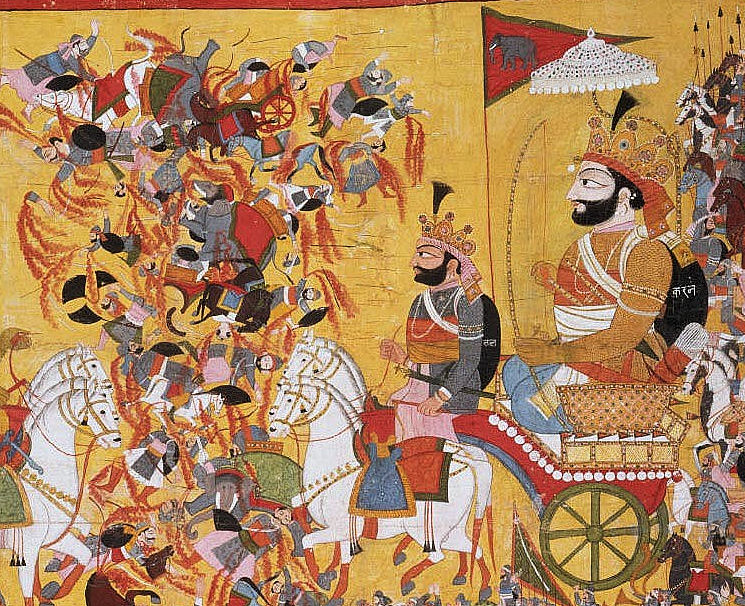
Abb.:
|
52a./b. kapidhvajasya gāṇḍīva-gāṇḍivau
puṃnapuṃsakau कपिध्वजस्य गाण्डीव-गाण्डिवौ पुंनपुंसकौ ।५२ क। Der Bogen dessen, der einen Affen in der Standarte hat (= Arjuna), heißt:
|
Colebrooke (1807): "That of Arjuna."
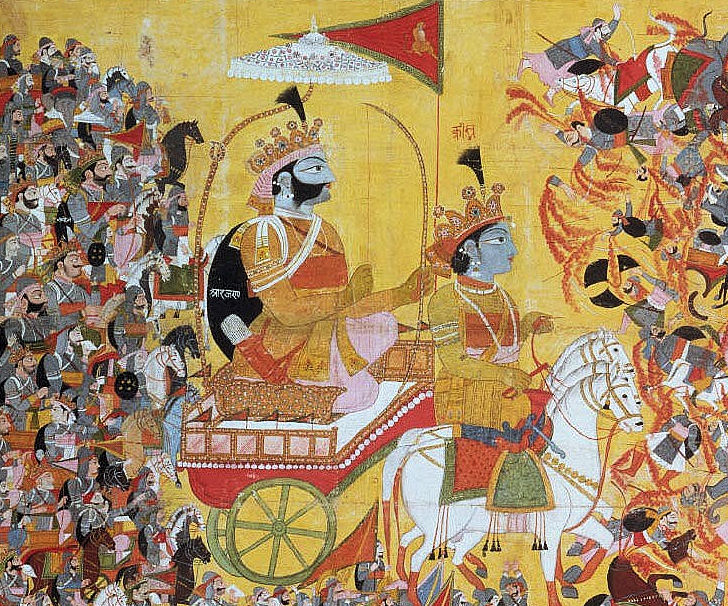
"GĀṆḌĪVA. The bow of Arjuna, said to have been given by Soma to Varuṇa, by Varuṇa to Agni, and by Agni to Arjuna."
[Quelle: Dowson, John <1820-1881>: A classical dictionary of Hindu mythology and religion, geography, history, and literature. -- London, Trübner, 1879. -- s.v. ]
|
52c./d. koṭir asyāṭanī godhā-tale jyāghātavāraṇe कोटिर् अस्याटनी गोधा-तले ज्याघातवारणे ॥५२ ख॥ Die Spitze des Bogens heißt अटनी aṭanī f.: Bogenende |
Colebrooke (1807): "Notched extremity of a bow."
अटनी aṭanī f.: Bogenende
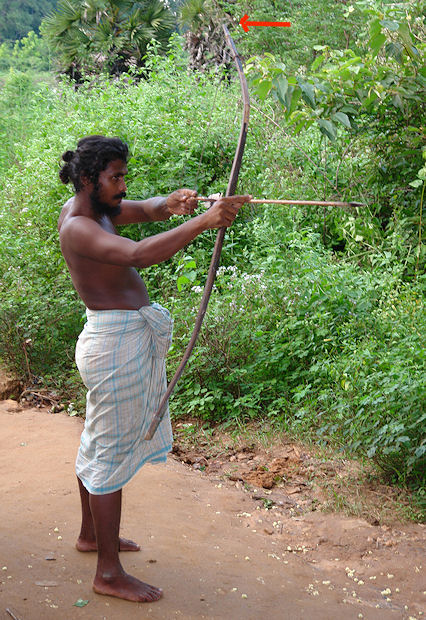
Abb.:
| 52c./d. koṭir asyāṭanī godhā-tale jyāghātavāraṇe कोटिर् अस्याटनी गोधा-तले ज्याघातवारणे ॥५२ ख॥ Bezeichnungen für den Schutz gegen den Schlag der Bogensehne:
|
Colebrooke (1807): "Leathern fence for the arm."
1 vermutlich war der Bogenschutz aus Waranleder (Varanus bengalensis Daudin, 1802 - Bengalenwaran - Bengal monitor / Common Indian monitor) gemacht. Zu indischen Waranen siehe:
Amarasiṃha <6./8. Jhdt. n. Chr.>: Nāmaliṅgānuśāsana (Amarakośa) / übersetzt von Alois Payer <1944 - >. -- 2. Dvitīyaṃ kāṇḍam. -- 9. siṃhādivargaḥ. -- 2. Vers 4c - 12b (Säugetiere II und Warane). -- URL: http://www.payer.de/amarakosa2/amara209b.htm
गोधा - godhā f.: Waran1, Bogenschutz, Bogensehne
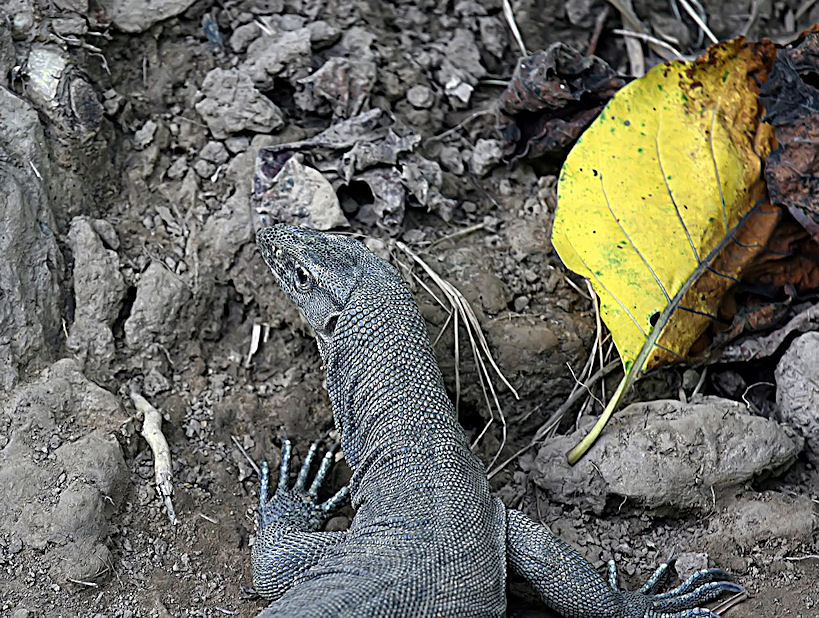
Abb.: गोधा । Varanus bengalensis Daudin, 1802 -
Bengalenwaran - Bengal monitor / Common Indian monitor, Jim Corbett National
Park (जिम कार्बेट राष्ट्रीय अभ्यारण्य), Uttarakhand
[Bildquelle: Deepak Bhatia. --
http://www.flickr.com/photos/zeepack/2913746611/. -- Zugriff am
2011-06-14. --
Creative Commons Lizenz (Namensnennung, share alike)]
"To protect the left forearm from the abrasion of the bow-string, it was in Vedic times, wrapped in folds of leather, but the sculptures do not anywhere show a trace of this gauntlet. The Egyptians used a slip of leather for the same purpose, but instead of folding it round the forearm, wore it only on the inner side, tied at the wrist and the elbow. In later times, the Indians used metal gauntlets, but I have seen no sculpture of them of an early date."
[Quelle: Mitra, Rājendralāla <1824-1891>: Indo-Aryans: contributions towards the elucidation of their ancient and mediaeval history. -- London : Stanford, 1881. -- 2 Bde. : Ill. ; 23 cm. -- Bd. 1, S. 304]
"The hand-protectors (aṅguliveṣṭaka, etc.) are of minor importance. They appear to be of constant use, and, properly, are a defense not so much against the foe as against the kinight's own weapons. For their purpose was to protect arm (godhā) and finger from the bow-string. They are called hand-guards and finger-guards, and are made of iguana-skin. All the bowmen are represented as wearing them. Signs that this armor, common as it is, is not present in all cases, and that the bow-string marks were a common feature, remain in the epithets applied to warriors, implying that their arms were scarred from the bow-string. Nevertheless, the bow-string-guard is very old. Probably, therefore, it was confined to the fingers. The noise made by this part of the armor struck by the bow-string is often brought forward."
[Quelle: Hopkins, Edward W. (Washburn) <1857 - 1932>: The social and military position of the ruling caste in ancient India; as represented by the Sanskrit epic; with an appendix on the status of woman. -- Reprint from the 13th volume of the Journal of the American Oriental Society (1888). -- New Haven, Conn. : Tuttle, 1889 -- S. 307f.]
|
53a./b. lastakas tu dhanurmadhyaṃ morvī jyā śiñjinī guṇaḥ लस्तकस् तु धनुर्मध्यं मोर्वी ज्या शिञ्जिनी गुणः ।५३ क। Das Mittelstück des Bogens heißt लस्तक - lastaka m.: Mittelstück des Bogens |
Colebrooke (1807): "Middle of the bow."
"Der Bogen selbst kann in fünf Abschnitte gegliedert werden: einem meist starren Mittelstück, das als Griff für den Bogenschützen dient, zwei daran anschließende flexible Wurfarme und den beiden abschließenden Bogenenden, an denen die Bogensehne befestigt wird." [Quelle: http://de.wikipedia.org/wiki/Bogen_%28Waffe%29. -- Zugriff am 2011-06-14]
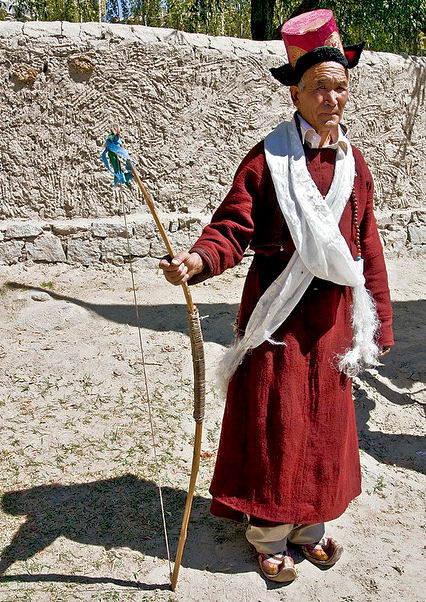
Abb.: लस्तकः । Leh -
|
53a./b. lastakas tu dhanurmadhyaṃ
maurvī jyā śiñjinī guṇaḥ लस्तकस् तु धनुर्मध्यं मौर्वी ज्या शिञ्जिनी गुणः ।५३ क। [Bezeichnungen für Bogensehne:]
|
Colebrooke (1807): "The bowstring."
मौर्वी - maurvī f.: aus mūrvā-Gras (Marsdenia tenacissima (Roxb.) W. & A. 1824) gemacht, Gürtel, Sehne
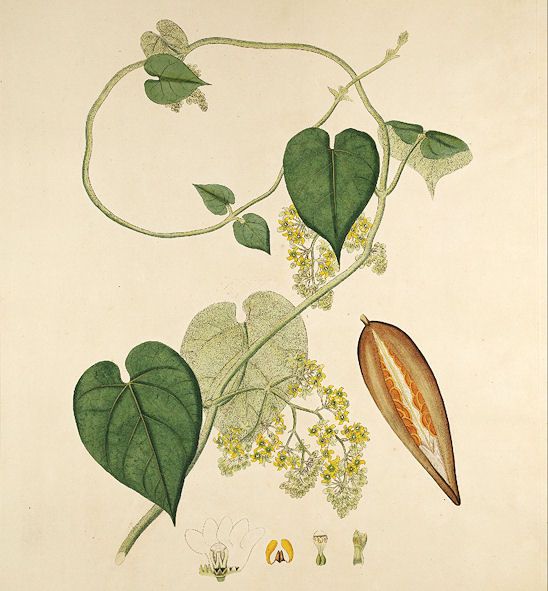
"Marsdenia tenacissima (R. W.) N. O. Asclepiaceae.
Description.—Twining; [...] flowers greenish yellow.
Fl. April.
Wight Contrib. p. 41.—Icon. t. 590.
Asclepias tenacissima, Roxb. Fl. Ind. ii. 51.—Cor. iii t. 240.
RajmahaL Chittagong. Mysore.
Economic Uses.—The bark of the young shoots yields a large portion of beautiful fine silky fibres, with which the mountaineers of Rajmahal make their bowstrings, on account of their great strength and durability. These fibres are much stronger than hemp, and even than those of the Sanseveria Zeylanica. A line of this substance broke with 248 lb. when dry, and 343 lb. when wet. Wight considers this species not to be a native of the Peninsula. The specimens in the Madras herbarium are—the one from the missionary's garden; the other (A. echinata) was sent to Klein by Heyne, but is not the plant of Roxburgh. The milk exuding from wounds made in the stem thickens into an elastic substance, acting like caoutchouc on black-lead marks.—(Roxb. Wight) Another species, the M. tinctoria, is cultivated in Northern India, being a native of Silhet and Burmah. The leaves yield more and superior indigo to the Indigofera tinctoria, on which account it has been recommended for more extensive cultivation.--Roxb. Wight."
[Quelle: Drury, Heber <1819 - 1872>: The useful plants of India : with notices of their chief value in commerce, medicine, and the arts. -- 2d ed. with additions and corrections. London : Allen, 1873. -- xvi, 512 p. ; 22 cm. -- s.v.]
ज्या - jyā f.: Sehne
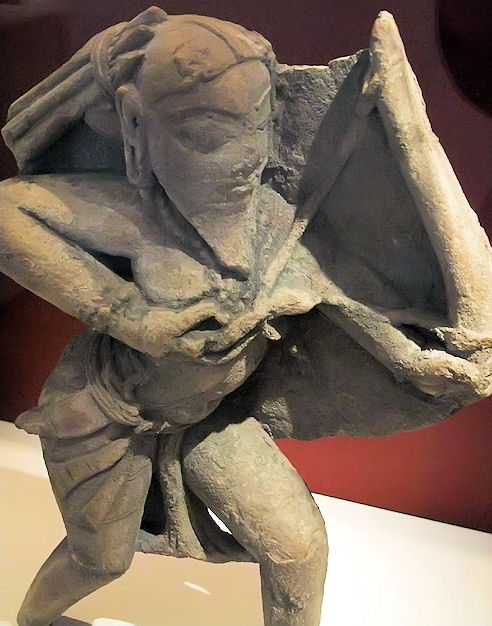
Abb.: ज्या । Schütze spannt Bogen, Madhya Pradesh, 11. Jhdt. n. Chr.
[Bildquelle: Mary Harrsch. --
http://www.flickr.com/photos/mharrsch/4470199741/. -- Zugriff am
2011-04-16. --
Creative
Commons Lizenz (Namensnennung, keine kommerzielle Nutzung, share alike)]
शिञ्जिनी - śiñjinī f.: "die Klingende", Bogensehne
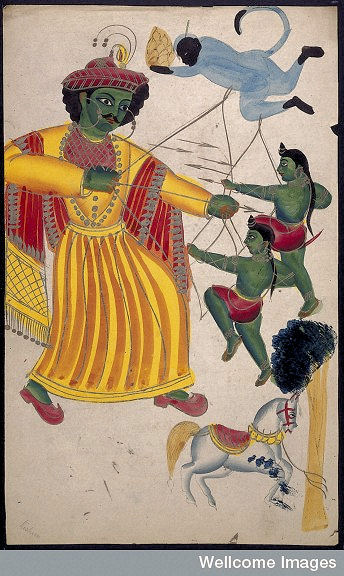
Abb.: शिञ्जिनी । Rāma kämpft
mit Hilfe Hanumāns gegen seine Zwillingssöhne Kuśa und Lava, ca. 1860
गुण - guṇa m.: Faden, Schnur, Sehne, Seite, Eigenschaft
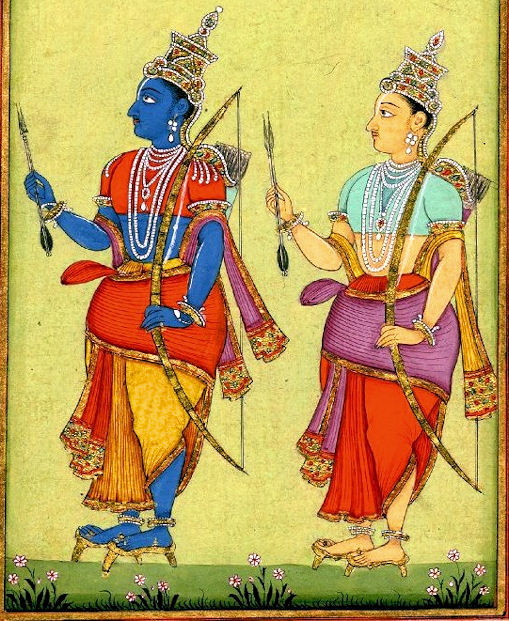
Abb.: गुणौ । Rāma und Lakṣmaṇa, 18. Jhdt.
[Bildquelle: Wikipedia. -- Public domain]
|
53c./d. syāt pratyālīḍham ālīḍham ityādi
sthānapañcakam स्यात् प्रत्यालीढम् आलीढम् इत्यादि स्थानपञ्चकम् ॥५३ ख॥ Die fünf Arten, beim Bogenschießen zu stehen sind:
|
Colebrooke (1807): "Two attitudes of shooting. Out of five, viz. 1st. with left foot advanced, and right foot retired ; 2d. With the knee advanced, but the left foot retired ; 3rd. समपदं with both feet even ; 4th. विशाखः with feet a span apart ; 5th. मंडलं with both knees bent."
"Of the different attitudes which were assumed in using the bow, the Agni Purāṇa gives the following description :
"The sampada attitude in shooting, is the standing with the feet even, the two great toes, ankles, and heels being closely opposite each other ; and the position of standing with the feet three spans apart.
Laying the centre of gravity on the toes, and keeping the knees unbent, is the vaiśākha posture.
The attitude in which both the knees appear like a flock of geese, and in which the archer stands with the feet four spans asunder, is called maṇḍala ;
and the ālīḍha posture is said to be that, in which the right thigh and knee are kept unbent, and in which the feet are placed five spans apart, assuming the shape of a plough.
The contrary of the above is called the pratyālīḍha attitude.
The jāta attitude is that in which the left leg should be kept in a crooked position, the left heel at a distance of five fingers from the ankle of the right foot, and the knees twelve fingers apart from each other.
The daṇḍāyata posture is of this description ; the left knee straight, and the right advanced or a little bent, and firmly fixed ;
but when this attitude is such that the knees are two cubits distant from each other, it is called vikaṭa.
The Sampuṭa attitude is said to be the bending the knee double, and keeping the feet raised from the ground (except the forepart), or standing with the legs straight as sticks, and the feet sixteen fingers apart from each other."
[Quelle: Mitra, Rājendralāla <1824-1891>: Indo-Aryans: contributions towards the elucidation of their ancient and mediaeval history. -- London : Stanford, 1881. -- 2 Bde. : Ill. ; 23 cm. -- Bd. 1, S. 305]
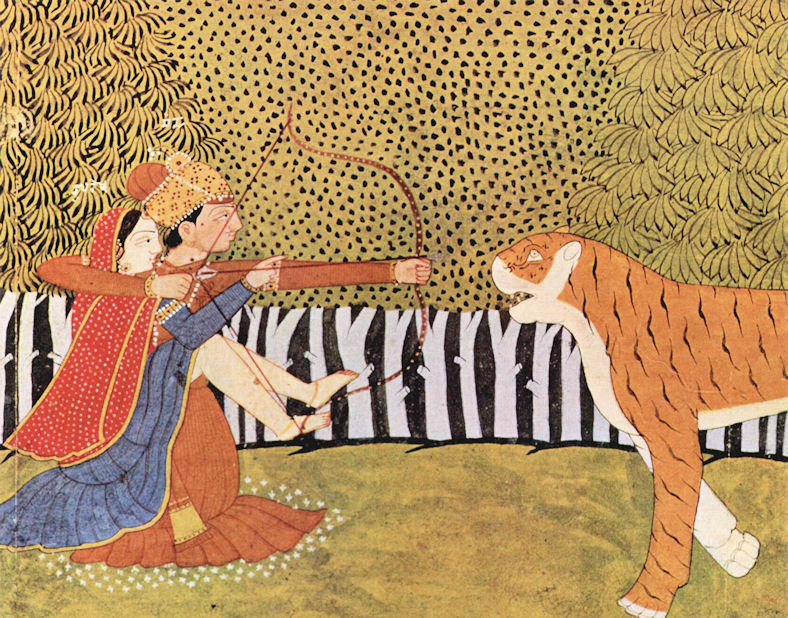
Abb.: Keine klassische Stellung des Bogenschießens: das gestörte Liebespaar,
1799
|
54a./b. lakṣyaṃ lakṣaṃ śaravyaṃ ca śarābhyāsa upāsanam लक्ष्यं लक्षं शरव्यं च शराभ्यास उपासनम् ।५४ क। [Bezeichnungen für Ziel:]
|
Colebrooke (1807): "A butt or mark."
लक्ष - lakṣa n.: Zeichen, Marke, Zielpunkt, Ziel, Wettpreis, Hunderttausend
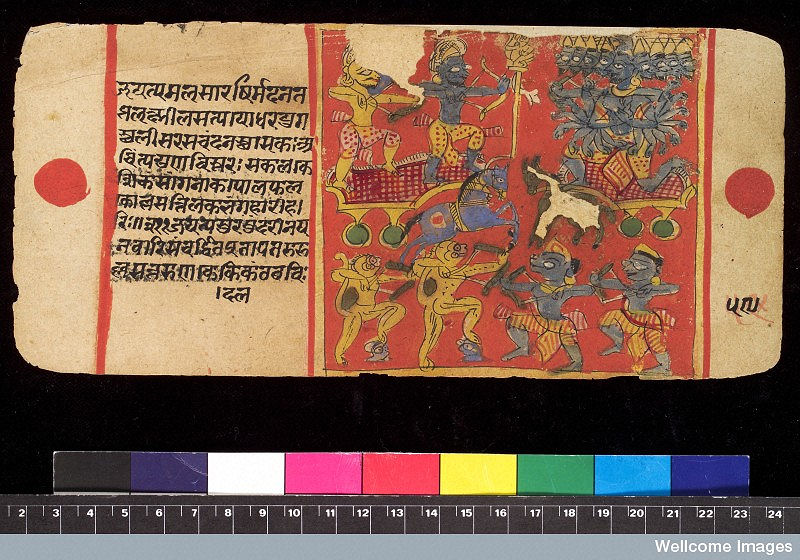
Abb.: लक्षम् । Rāma und Lakṣmaṇa zielen auf Ravaṇa, 15. Jhdt.
शरव्य - śaravya n.: Ziel (zu śara m.: Pfeil)
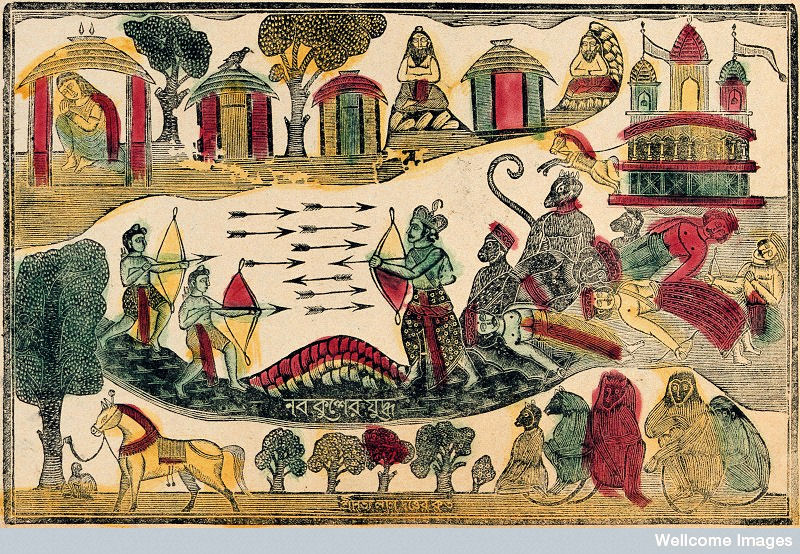
Abb.: शरव्यानि । Rāma kämpft
mit Hilfe Hanumāns gegen seine Zwillingssöhne Kuśa und Lava,
Lithographie, Bengalen
|
54a./b.
lakṣyaṃ lakṣaṃ śaravyaṃ ca śarābhyāsa
upāsanam लक्ष्यं लक्षं शरव्यं च शराभ्यास उपासनम् ।५४ क। [Bezeichnungen für Übung im Bogenschießen:]
|
Colebrooke (1807): "Archery."
|
54c./d. pṛṣatka-bāṇa-viśikhā
ajihmaga-khagāśugāḥ 55a./b. kalamba-mārgaṇa-śarāḥ patrī ropa iṣur dvayoḥ
पृषत्क-बाण-विशिखा अजिह्मग-खगाशुगाः ॥५४ ख॥ [Bezeichnungen für Pfeil:]
|
Colebrooke (1807): "An arrow."
पृषत्क - pṛṣatka m.: gesprenkelter, Pfeil
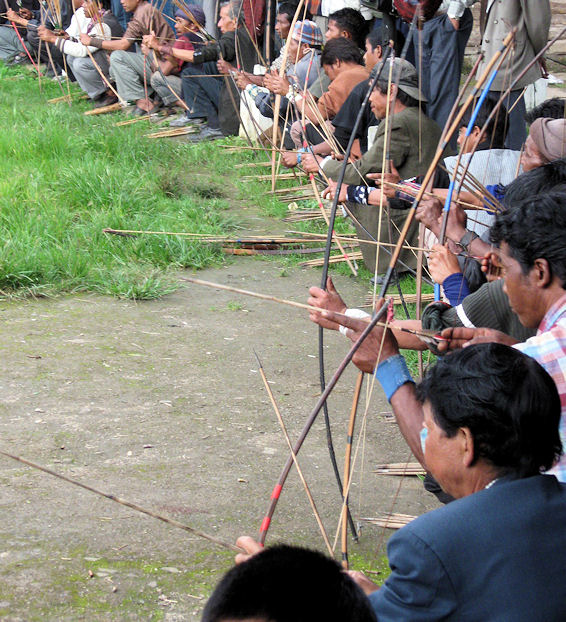
Abb.: पृषत्काः । Siat Khnam-Lotterie, Shillong, Meghalaya
[Bildquelle: Joe Coyle. --
http://www.flickr.com/photos/onbangladesh/2900835081/. -- Zugriff am
2011-06-15. --
Creative Commons Lizenz (Namensnennung, keine kommerzielle Nutzung)]
Bei der Siat Knam-Lotterie werden die Gewinnzahlen so gewonnen: Khasi-Männer schießen eine vorgegebene Zeit lang so viele Pfeile in einen Strohballen wie möglich. Dann werden die Pfeile im Strohballen gezählt. Die beiden letzten Ziffern der Anzahl der Pfeile im Strohballen sind die Gewinnzahl: z.B. 756 Pfeile = Gewinnzahl 56.
बाण - bāṇa m.: Pfeil, Ziel
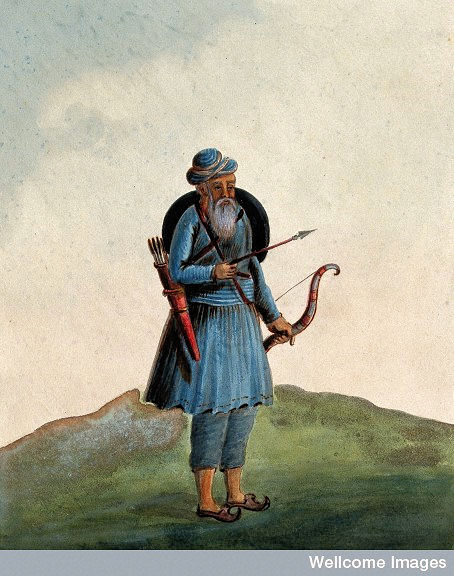
Abb.: बाणाः । Mann mit Pfeil, Bogen, Köcher und Schild, 19. Jhdt.
[Bildquelle: Wellcome Images. --
Creative Commons
Lizenz (Namensnennung, keine kommerzielle Nutzung)]
विशिख - viśikha m.: kahlköpfig, stumpfer Pfeil, unbefiederter Pfeil
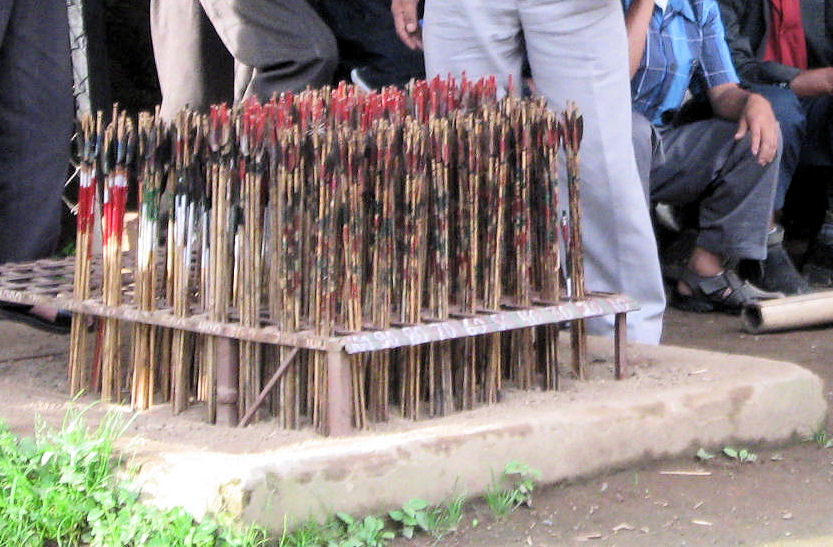
Abb.: विशिखाः । Pfeile für Siat Khnam-Lotterie, Shillong, Meghalaya
[Bildquelle: Joe Coyle. --
http://www.flickr.com/photos/onbangladesh/2900837331/. -- Zugriff am
2011-06-15. --
Creative Commons Lizenz (Namensnennung, keine kommerzielle Nutzung)]
अजिह्मग - ajihmaga m.: nicht krumm gehend, Pfeil
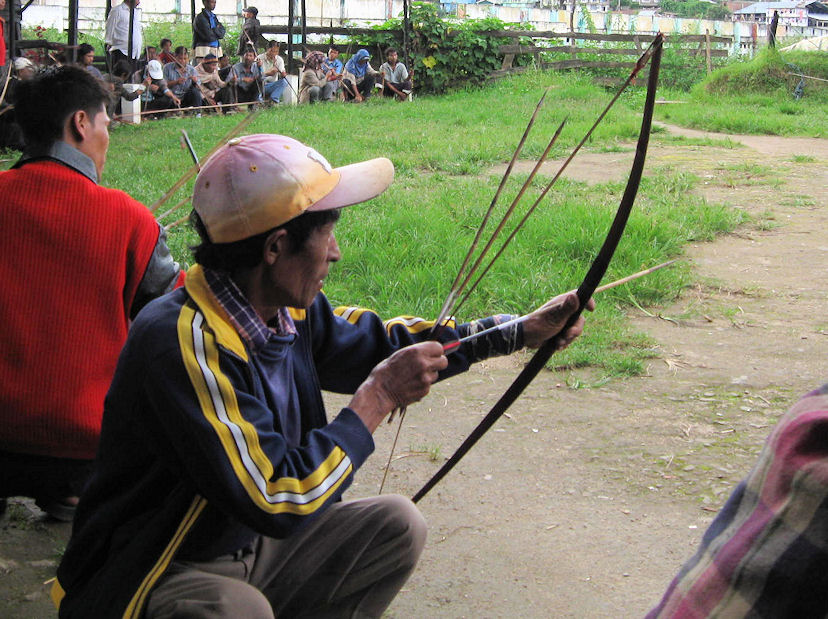
Abb.: अजिह्मगाः । Siat Khnam-Lotterie, Shillong, Meghalaya
[Bildquelle: Joe Coyle. --
http://www.flickr.com/photos/onbangladesh/2900835815/. -- Zugriff am
2011-06-15. --
Creative Commons Lizenz (Namensnennung, keine kommerzielle Nutzung)]
खग - khaga m.: in der Luft gehend, fliegend, Vogel, Pfeil
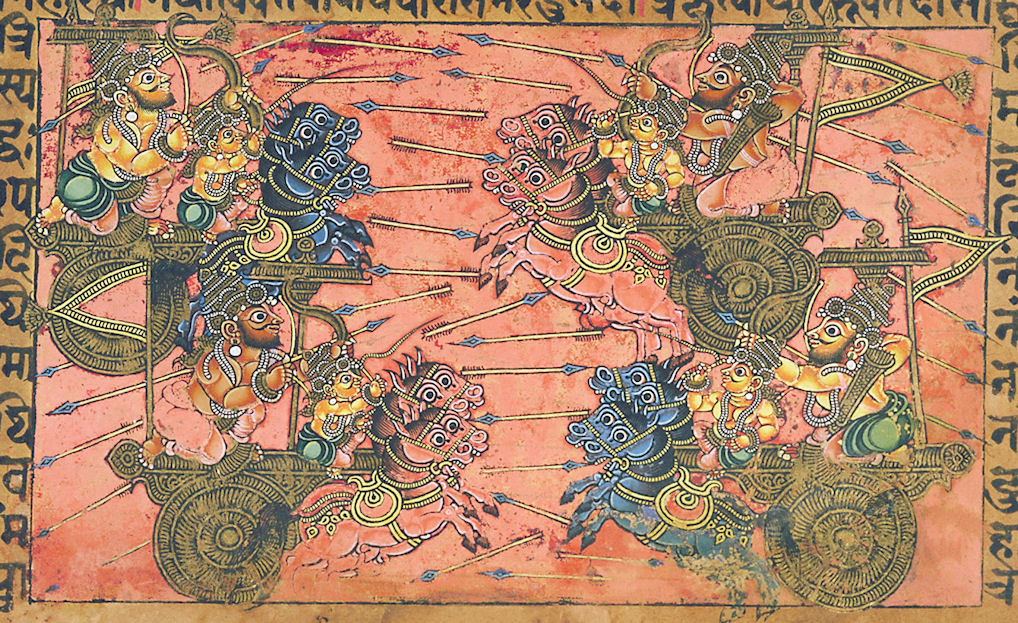
Abb.: खगाः । Kampf zwischen Kṛpa und Śikhaṇḍin, ca. 1670
[Bildquelle: Wikimedia. -- Public domain]
आशुग - āśuga m.: schnell gehend, Pfeil
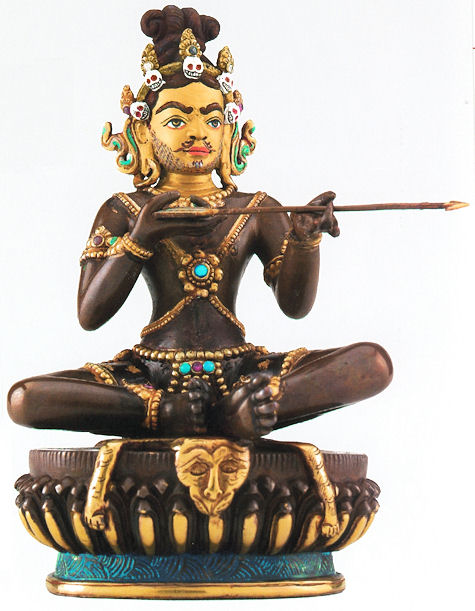
Abb.: आशुगः । Saraha, Nepal
[Bildquelle: Yaska / Wikimedia. -- GNU FDLicense]
कलम्ब - kalamba m.: Anthocephalus cadamba Miq. - Kadam-Baum, Pfeil
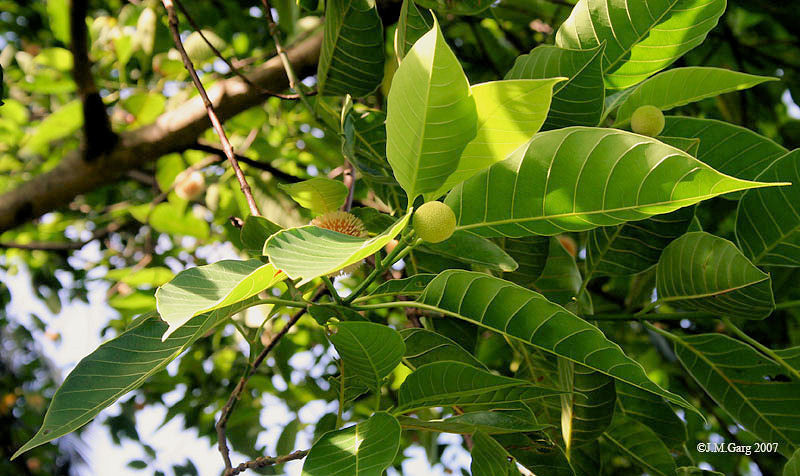
"Anthocephalus Cadamba, Rubiaceae Wild Cinchona (Eng.)
This tree is sacred to Kālī or Pārvatī, the consort of Śiva; it is the Arbor Generationis of the Maratha Kunbis, and a branch of it is brought into the house at the time of their marriage ceremonies. The tree is planted near villages and temples, and is held to be sacred. In Sanskrit it is called Kadamba or Kalamba, and has also many synonyms, such as Sisu-pāla, 'protecting children'; Hali-priya, 'dear to agriculturists,' &c. The Kadamba blossoms at the end of the hot seasons, and its night-scented flowers, form a large, globular, lemon-coloured head, from which the white clubbed stigmas project. They are compared by the Indian poets to the cheek of a maiden mantling with pleasure at the approach of her lover, and are supposed to have the power to irresistibly attracting lovers to one another. This idea is expressed in the following couplet of the Saptasatika of Hāla: -"Sweet-heart, how I am bewitched by the Kadamba blossoms, all the other flowers together have not such a power. Verily Kama wields now-a-days a bow armed with the honey balls of the Kadamba." The flowers are fabled to impregnate with honey the water, which collects in holes in the trunk of the tree. Beal, in his Catena of Buddhist scriptures from the Chinese, informs us that according to the Dirghagama Sutra, to the east of mount Sumeru rises a great king of trees called Kadamba; in girth seven yoganas, height a hundred yoganas, and in spread fifty yoganas. M. Sénart (Essai sur la légende du Buddha) says: -"L'arbre de Bouddha sort spontanément d'un noyau de Kadamba déposé dans le sol; en un moment, la terre se fend, une pousse paraît, et le géant se dresse ombrageant une circonférence de trois cents coudées. Les fruits qu'il porte troublent l'esprit des adversaires du Buddha contre lesquels les Dévas déchaînent toutes les fureurs de la tempéte." (De Gubernatis.) The fruit, which is about the size of a small orange, is eaten by the natives and is considered to be tonic and febrifuge, and its fresh juice is applied to the heads of infants when the fontanelle sinks; at the same time a small quantity mixed with cumin and sugar is given internally. In inflammation of the eyes the bark-juice with equal quantities of lime-juice, opium and alum is applied round the orbit."
[Quelle: Pharmacographia indica : a history of the principal drugs of vegetable origin met with in British India / by William Dymock [1834-1892], C. J. H. Warden and David Hooper [1858-1947]. -- Bd. 2. -- London, 1891. -- S. 169f.]
मार्गण - mārgaṇa m.: nachspürend, suchend, Pfeil
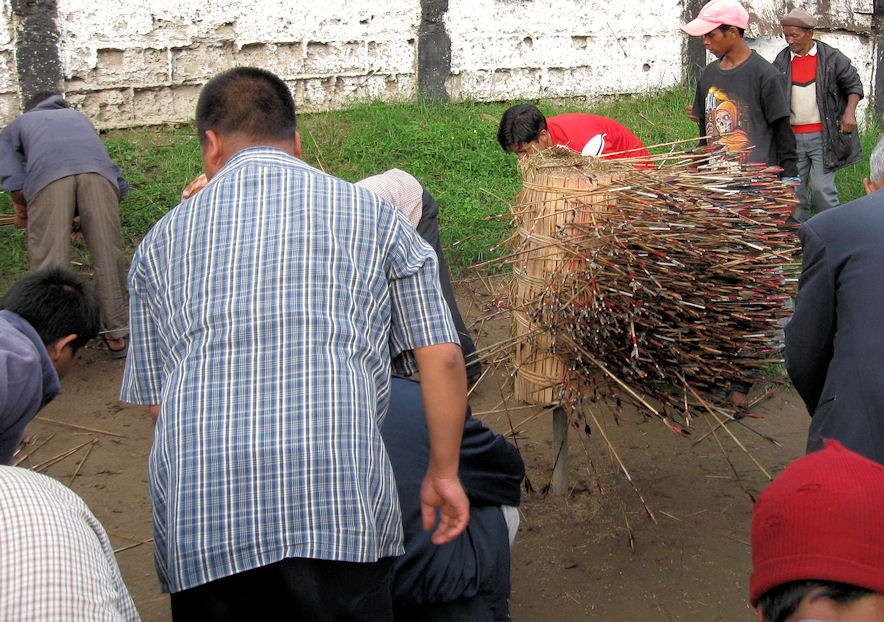
Abb.: मार्गणाः ।
शर - śara m.: Saccharum bengalense Retz. 1789 - Munja-Gras - Munj Sweetcane, Pfeilschaft, Pfeil
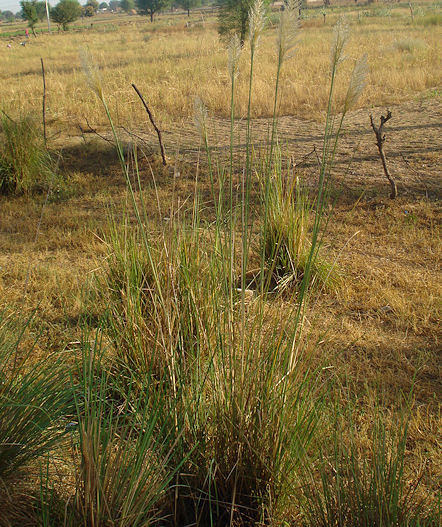
Abb.: शरः । Saccharum bengalense Retz.
1789
[Bildquelle: LRBurdak / Wikipedia. -- GNU FDLicense]
"Saccharum sara, Roxb. [...] The seed of this grass appears to be used only in famine times, or by some of the wild tribes who use the stem for making arrows."
[Quelle: Pharmacographia indica : a history of the principal drugs of vegetable origin met with in British India / by William Dymock [1834-1892], C. J. H. Warden and David Hooper [1858-1947]. -- Bd. 3. -- London, 1893. -- S. 621]
पत्रिन् - patrin m.: befiedert, Vogel, Pfeil
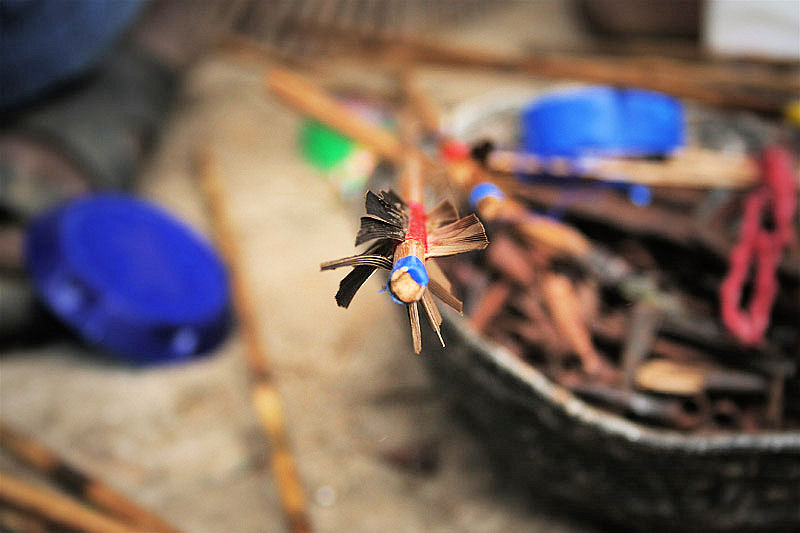
Abb.: पत्री । Siat Khnam-Lotterie, Shillong, Meghalaya
[Bildquelle: Seema K K. --
http://www.flickr.com/photos/kkseema/835390684/. -- Zugriff am
2011-06-15. --
Creative
Commons Lizenz (Namensnennung, keine kommerzielle Nutzung, share alike)]
रोप - ropa m.: "Aufsteiger", Pfeil
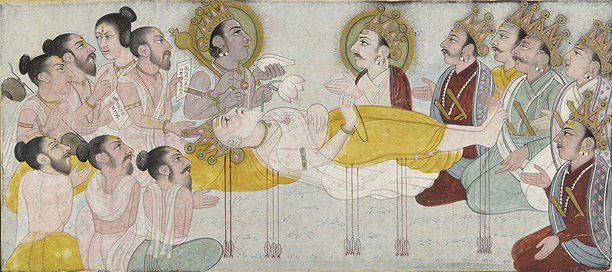
Abb.: रोपाः । Tod Bhīṣmas, Punjab hills, 18. Jhdt.
[Bildquelle: Wikimedia. -- Public domain]
इषु - iṣu m., f.: "Sender", Pfeil
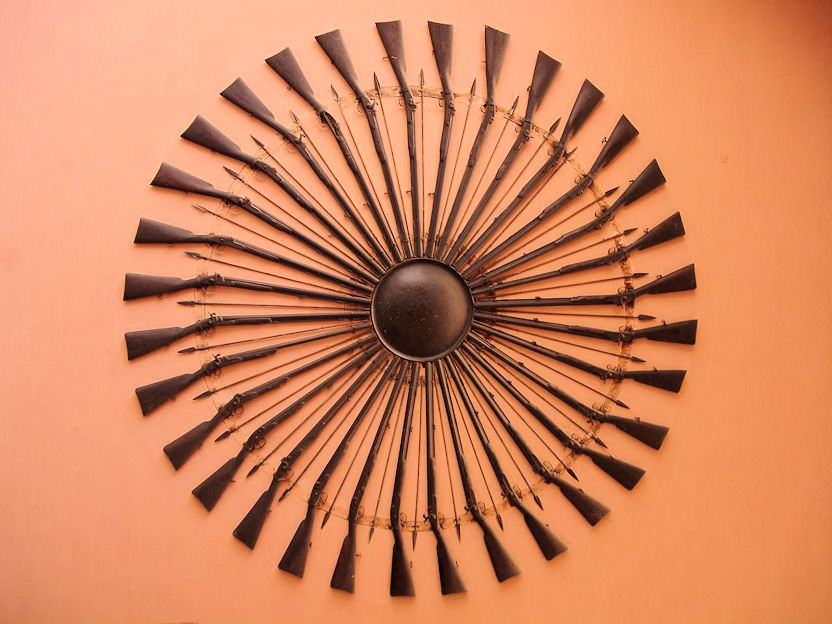
Abb.: इषवः । Pfeile und Gewehre, Jaipur - जयपुर, Rajasthan
[Bildquelle: David Hamill. --
http://www.flickr.com/photos/auldhippo/3516645869/. -- Zugriff am
2011-06-15. --
Creative Commons Lizenz (Namensnennung, keine kommerzielle Nutzung)]
"Pfeil, in seiner einfachsten Form ein vorn zugespitzter, hinten gerade abgeschnittener oder mit einer Kerbe versehener Stab, der vom Bogen als Geschoß geschleudert oder von der Hand direkt (Wurfpfeil) oder mittels einer Schleudervorrichtung geworfen wird. In dieser einfachsten Form ist der Pfeil heute nur noch bei ganz primitiven Urwaldstämmen Zentralafrikas anzutreffen; in allen übrigen Fällen ist er durch besondere Ausgestaltung der Spitze und des Schaftes weiter ausgestaltet und technisch oder durch Hinzufügen von Gift wirksamer gemacht worden. Alle auf steinzeitlicher Kulturstufe stehenden Völker haben die Holzspitze durch eine solche aus Stein, Horn oder Knochen ersetzt, in tropischen Ländern auch durch solche aus Bambus, Rochenstachel u.a. Von ihnen haben sich aus vorgeschichtlichen Zeiten lediglich die steinernen erhalten, von denen in Europa, Amerika und Asien (Japan) große Mengen gefunden worden sind. Die Feuerländer, Buschmänner, Mittel- und Nordamerikaner haben Steinpfeilspitzen zum Teil bis in die neueste Zeit gebraucht. In allen Erdteilen mit Metallkultur ist die Spitze späterhin aus Kupfer, Bronze oder Eisen gefertigt worden; in Afrika ist der eisenbewehrte Pfeil noch heute fast ganz allgemein verbreitet. Der Schaft erhielt sehr häufig ein sogen. Mittelstück, einen Einsatz von Holz oder Rohr, der in der Schafthöhlung locker sitzt und dadurch das Herausziehen der Spitze aus dem Körper der Getroffenen erschwert oder bei Anwesenheit von Widerhaken unmöglich macht. Bei den Pfeilen der Buschmänner, Kredsch und andrer afrikanischer Völker sind sogar mehrere Mittelstücke ineinandergefügt. Unten erhielt der Pfeil schaft zunächst eine Fiederung oder Einkerbung der Basis. Jene soll dem Pfeilflug eine größere Stabilität verleihen und das Überschlagen verhüten, diese ein sicheres Auflegen auf die Bogenschnur ermöglichen. Meist besteht die Flugsicherung aus einer bis vielen Federn, die radial oder tangential durch Ankleben, Anbinden, Anwickeln, Einstechen befestigt werden; in Zentralafrika und dem Kongobecken treten indessen auch Baumblattstücke, ja selbst Fell- und Lederstücke als »Fiederung« auf. Ohne eine solche Flugsicherung sind nur wenige Pfeilgebiete: in Afrika der gesamte Sudân, die Region am obern Nil und Buschmänner und Hottentotten, im Stillen Ozean sodann ganz Melanesien außer den Neuen Hebriden und Polynesien, soweit Bogen und Pfeil dort überhaupt noch gebraucht werden. Die Kerbe ist in der Regel dreieckig; nur bei den sehr starken Raphiaschäften des Kongobeckens sind sie rechtwinklig aus dem Schastende herausgeschnitten. Bei Rohrschäften dient häufig ein hölzernes Einsatzstück als Kerbenträger. Einseitige Kerben, d.h. solche, bei denen nur ein Kerbenarm stehen gelassen oder aber nur ein Stück fremden Holzes oder Rohres an den Schaft gebunden worden ist, kommen im Hinterlande von Deutsch-Togo vor; sie gehören zu Bogen mit Bambus- oder Rotangsehnen. Kerbenlos sind endlich alle Gebiete, wo relativ dünne Pfeile auf starke Sehnen (Bambus, Rotang) gesetzt werden müssen, wie im afrikanischen Urwaldgebiet und in vielen Teilen Melanesiens, außerdem aber anscheinend überall da, wo die Bogensehne von Daumen und Zeigefinger zurückgezogen wird, wobei beide gleichzeitig auch das Schaftende des Pfeiles zwischen sich halten." [Quelle: Meyers großes Konversations-Lexikon. -- DVD-ROM-Ausg. Faksimile und Volltext der 6. Aufl. 1905-1909. -- Berlin : Directmedia Publ. --2003. -- 1 DVD-ROM. -- (Digitale Bibliothek ; 100). -- ISBN 3-89853-200-3. -- s.v.]
"The arrows. The Epic describes arrows of two chief sorts, vaiṇava, 'made of reeds,' and āyasa, 'made of iron.' Bone arrows appear rarely in late parts. The oldest and commonest names are iṣu (
ιος) and śara (reed). Like the first in meaning is astra, 'missile,' united with it in iṣvastra, the bow, and in the expression kṛtāstra, which, like dhanur-dhara, denotes a fine archer, and is an honorary title of a good knight. Like the second in meaning, but of later use, is bāṇa, a reed, but employed also of iron arrows; while the very common śalya means the arrow-point, and thence the arrow as a whole. Beside these we find bhalla and pradara. the latter rare, and meaning literally a 'splitter;' the former common. The arrow of iron was usually termed nārāca. Other less common forms are discussed below.In regard to the employment of the arrows there is little to be learned, in spite of the long descriptions in the Epic. As said above, they were used to embarrass or slay the foe more by numbers than by the skilful use of one. Nothing is more common than an incredible number of arrows flying across the field between two champions; and a 'rain of arrows' or 'flood of arrows,' forming whenever two heroes contend.
The arrows generally used were, according to indefinite but frequent descriptions, large, long, heavy, sharp, strong, able to pierce armor, capable of slaying elephants, horses, etc. But we find, besides these long (reed) arrows and heavy (iron) arrows, an arrow 'one span long' made of reed, meant for fighting at close quarters, where it could be more quickly 'put to' and discharged.
The normal length of the arrow was that of the axle of the war car. Bound with sinews (snāyu), and well feathered, it has a 'terrible end,' whether made of reed and tipped with steel or wholly of metal. In the reed the epithet 'well-jointed' (suparvam) points to the joints of the reeds being well smoothed. Three joints are recommended. The feathers used were of various kinds; hawks, flamingos, and herons furnish the sorts most used, various birds being sometimes represented in the feathering of one arrow.
The sharpness of the arrow is naturally often alluded to, the point (mukha, vaktra, aqra) and edges (dhāraā being 'sharp as flame,' or 'sharp as a hair,' for they were ' whetted on stone.' The other end of the arrow in adorned with what is often called the 'golden' jpuṅkhai. When applied to a 'knife-arrow,' we find the puṅkha of silver. To drive the arrow up to this part was a special feat. The puṅkha, then, was a metal end attached to the main shaft, and was probably added for the purpose of making a securer notch (the notch itself being called kuḍmala), and opposed to śṛṅga, the sharp end (viii. 34.18-19): a hold alike for string and feathers. Oiled arrows are often referred to, and fire may have been applied to them thus oiled, as we find them spoken of independently as 'glowing;' but I am inclined to think that, if arrows really lighted had been used, more than this epithet would remain to prove it; for the 'glowing,' like the 'flame,' of an arrow is poetical for heat, and probably refers only to its sharpness and its fiery touch ; and the word is used where no fire is necessarily imaginable (as of a sword), and where none is certainly discoverable. Moreover, these 'glowing arrows' never kindle wood. From the effect, then, or lack of effect, I think it doubtful if fire was used; though the mention of 'ignited' arrows in Manu may induce some to interpret dīpta as really enkindled. The question whether poisoned arrows were used in war has been, I think, unsatisfactorily answered. Wilson says that (bamboo or wood) arrows were not poisoned except in the chase. This is one of those statements, based on a study of ideals, that must-be modified by facts. The last part is not wrong; in the chase poisoned arrows are alluded to in the pseudo-Epic quotation given above, where we read of hunting with 'poisoned arrows'; yet it is mentioned elswhere that hunting was done with 'pure' (i. e. unpoisoned) arrows, showing such sometimes to have been the case. But as to war, the law forbidding poisoned arrows, and the Epic's special statement that one 'honorable fight' took place where 'poison' was not used, show that lipta or poisoned arrows were generally employed. It is also possible that the common epithet 'resembling a snake' may refer to the poison, though perhaps better understood of the sharp bite, the whizzing sound, and the darting motion.
More than this in regard to the arrows used in the Epic must be confined to the special uses of the different sorts, though we are here chiefly driven to the interpretation of the name for the kind, and the special peculiarities of each mentioned. For, as a general thing, the arrows are alluded to in the mass, and only here and there do we find particular descriptions. The meagre accounts show us, however, many more names than we can interpret. Probably several of these are merely epithets applicable to different sorts: thus, the gokarṇa, 'cow-ear,' may be of any material, and the gold tips of the 'reed' may be equally applicable to the horn-arrow. I shall, then, only attempt to gather what I have noted of each, without believing that the individual description should be confined to the arrow described. Only important is the construction of the possible Hindu arrow, though I regret not finding more details.
Bhīma's favorite arrow was the 'crescent-head,' with which one can cut a head from a body, or divide a bow in two. This, the 'very sharp' ardhacandra, is frequently named with others, the 'broad,' añjalika, the vatsadanta, bhalla, etc. (vi. 92.33 ; 94.3 ; vii. 21. 21; 115. 27). The vatsadanta is named about as often as the ardhacandra. It is, from its name, a calf's-tooth-shaped arrow, and from the descriptions is particularly sharp. One wards off an onrushing foe with it (vii. 25.40). It is classed with the little known 'broad vipāṭha'' (iv.42.7; vii. 38.23), and its action is, perhaps, as well as anywhere, thus exhibited: 'He laid the tooth-shaped arrow on the string—swift as the wind it was—he drew it back until it touched his ear, and Sātyaki he pierced upon the belly. Right through the body's guard it cut, and through the body—the arrow with its feathers and it's metal butt—and dripping with blood it entered the earth.' (vii. 118. 49 ff.).
The kṣurapra in a knife shaped arrow: that is, with a blade- head ; and, like all these broad arrows, it cuts, if need be, a head from a body. It is spoken of as excessively sharp, and seems to have the legally forbidden 'ears,' or prongs bending back on the fish-hook plan. We have in Droṇa's leadership a list of arrows comprising nārāca, vatsadanta, bhalla, añjalika, kṣurapra, ardhacandra ; and again a 'half-nārāca' with nārācas of iron. The nārāca here mentioned is of iron, and is, according to another passage in the pseudo-Epic (xiii. 104.34), distinct from the nālīka (where we also find the karṇin or 'be-eared' arrow differentiated from the nālīka). The expression kṣudra-nārāca is here employed, literally 'small.' We find an antithesis between these again expressed in the battle-scenes, and in the Rāmāyaṇa the nālīka and (bahu-)nārāca are differentiated as if dissimilar.
The nārāca lias a gilded or silvered point, and is perhaps the special name for the bāṇā āyasāḥ, or iron shafts, mentioned above. It is generally defined as wholly of iron, but is described as 'feathered' (iv. 42.6). The nālīka, of reed nominally, may perhaps also have been of metal, as this is the name in modern literature of the iron musket. The sharpness of the nārāca, its smallness compared with the reed, its gold or silver point and gold puṅkha, are the main characteristics dwelt upon in this weapon.
Respecting the word sāyaka, although literally merely a projectile, it appears to be in most cases confined to the sense of arrow. But the same word is used of a sword, and the instrument is now and then spoken of as flung.
Out of the various lists of arrows which are mentioned as encumbering the ground with other arms, we may occasionally find descriptive epithets applied to names that are themselves nothing more than this. Thus mārgaṇa is defined as an arrow, and we may say that it is characterized as a 'sharp' arrow; but the information must simply be referred to the arrow in general; for mārgaṇa itself is only an epithet of the 'eager' arrow. Our knowledge, then, except in a few cases, is not increased by such descriptions. Names and names only are the pṛṣatka and añjalika, often mentioned as (epithet of) arrows, meaning apparently in one case that the arrow is speckled, in the other that it is barbed. Vipāṭha seems also to be a general term for arrows; but further than being broad, of iron, and yellow, i. e. gilded, the arrows thus named bear only universal characteristics. A further universal epithet of any arrow, often used as name, is ' the feathered one' (pattrin).
The same passage containing the description of vipāṭha speaks of 'boar-ear' arrows: that is, arrows forbidden by the law-books, with barbs at the heads, but often spoken of in the Epic.
I referred above to the poisoned arrows spoken of by the poet in one scene as discarded in honorable fight. But the list of dishonorable weapons here alluded to shows us many that must have been in use, though legally (perhaps later) forbidden. The 'ear arrows,' poisoned arrows, goat-horn arrows, needle-shaped arrows, arrows of monkey-bone, of cow-bone, and of elephant-bone; arrows so fractured as to break in the flesh; 'rotten' arrows; and crooked arrows; while the nālīka is also, strange to say, here spoken of with the implication of baseness in its use, which the commentator explains by defining nālīa as an arrow that enters breaking in the flesh, and cannot be withdrawn on account of its small size. The Rāmāyaṇa shows here, as it generally does in the battle-descriptions, thoroughly Epic usage.
We must suppose either that the barbed, poisoned, torturing arrow scorned in the law code of Manu and late Epic was a new invention of that period, or else that it was used from ancient times, and gradually began to be inveighed against by the popular law (Manu) and Epic, as too cruel for a more advanced age. The latter seems more reasonable."
[Quelle: Hopkins, Edward W. (Washburn) <1857 - 1932>: The social and military position of the ruling caste in ancient India; as represented by the Sanskrit epic; with an appendix on the status of woman. -- Reprint from the 13th volume of the Journal of the American Oriental Society (1888). -- New Haven, Conn. : Tuttle, 1889. -- S. 275 - 281]
|
55c./d. prakṣveḍanās tu nārācāḥ pakṣo vājas triṣūttare प्रक्ष्वेडनास् तु नाराचाः पक्षो वाजस् त्रिषूत्तरे ॥५५ ख॥ [Bezeichnungen für Eisenpfeil:]
|
Colebrooke (1807): "Iron arrows."
प्रक्ष्वेडन - prakṣveḍana m.: summend, Eisenpfeil
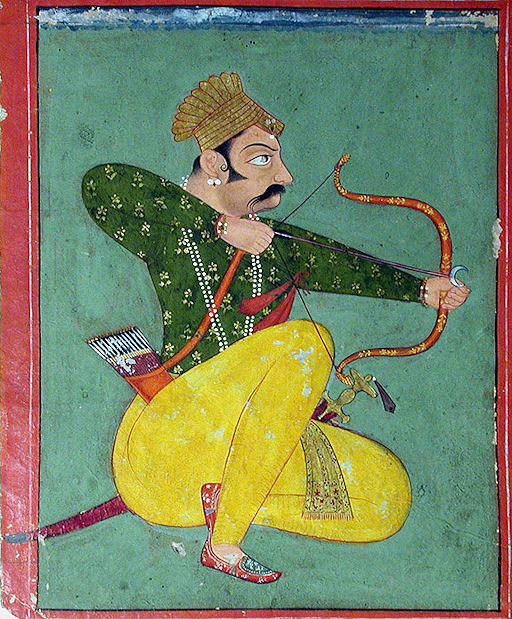
Abb.:
प्रक्ष्वेडनः
। Surajmal von Bundi (बूंदी), Rajasthan, ca. 1700
नाराच - nārāca m.: "eine Art Pfeil, angeblich ein eiserner" (PW)
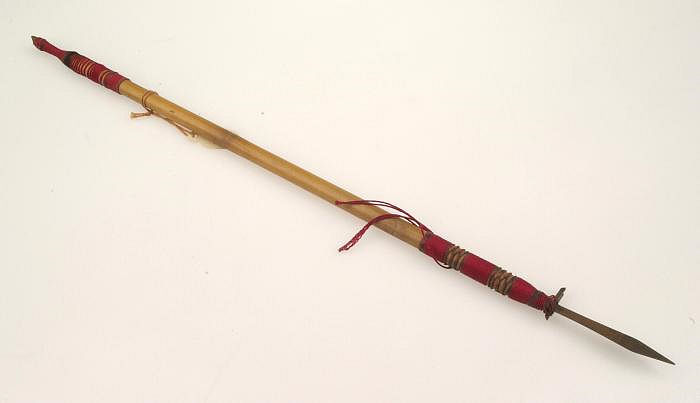
Abb.: नाराचः (?) । Bambuspfeil mit Metallspitze, Indonesien
[Bildquelle: Tropenmuseum of the Royal Tropical Institute (KIT) / Wikimedia.
-- Creative
Commons Lizenz (Namensnennung, share alike)]
|
55c./d. prakṣveḍanās tu nārācāḥ
pakṣo vājas triṣūttare प्रक्ष्वेडनास् तु नाराचाः पक्षो वाजस् त्रिषूत्तरे ॥५५ ख॥ [Bezeichnungen für Pfeilfeder:]
|
Colebrooke (1807): "Feather of an arrow."
पक्ष - pakṣa m.: Flügel, Feder, Gefieder, Befiederung

Abb.: पक्षः । Befiederung eines Pfeils
[Bildquelle: James Cram / Wikimedia. -- Public domain]
वाज - vāja m.: Raschheit, Wettlauf, Renner, Flügel, Pfeilfedern
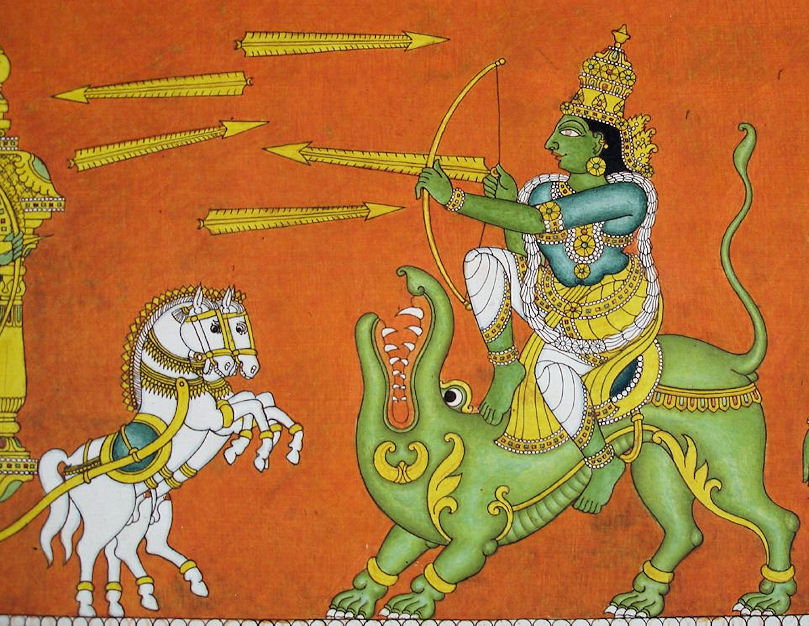
Abb.: वाजाः । Tempelgemälde, Madurai, Tamil Nadu
[Bildquelle: Ed Mitchell. --
http://www.flickr.com/photos/edmittance/434035282/. -- Zugriff am
2011-04-16. --
Creative
Commons Lizenz (Namensnennung, keine kommerzielle Nutzung, share alike)]
|
55c./d.
prakṣveḍanās tu nārācāḥ pakṣo vājas
triṣūttare प्रक्षेव्डनास् तु नाराचाः पक्षो वाजस् त्रिषूत्तरे ॥५५ ख॥ Die folgenden Wörter sind Adjektive. |
Colebrooke (1807): "The following admit the thee genders."
|
56a./b. nirastaḥ prahite bāṇe viṣākte digdha-liptakau निरस्तः प्रहिते बाणे विषाक्ते दिग्ध-लिप्तकौ ।५६ क। Zu einem abgeschossenen Pfeil sagt man निरस्त - nirasta 3: hinausgeworfen, weggeworfen, geschossen |
Colebrooke (1807): "Shot, as an arrow."
|
56a./b. nirastaḥ prahite bāṇe
viṣākte digdha-liptakau निरस्तः प्रहिते बाणे विषाक्ते दिग्ध-लिप्तकौ ।५६ क। Bezeichnungen für einen giftbeschmierten (अक्त - akta 3: gesalbt, beschmiert) [Pfeil]:
|
Colebrooke (1807): "Poisoned arrow."
"Pfeilgift, vegetabilische oder animalische Stoffe, mit denen Geschoßspitzen versehen werden, um diese schneller und sicherer tötend zu machen. Die Skythen bereiteten ein Pfeilgift aus gesamten Vipern und gefaultem Menschenblut, auch das Herakleische Pfeilgift, welches das Blut des Nessos derart vergiftete, dass es selbst nun wieder die furchtbarsten Wirkungen äußerte, konnte nur ein Fäulnisgift sein, das fermentartig wirkl. In Norwegen gebraucht man noch jetzt zur Jagd auf den Nordkaper (Balaenoptera rostrata) ein Pfeilgift, das aus Leichengift früher erlegter Tiere besteht. Odysseus vergiftete seine Pfeile mit Pflanzensäften, die er aus der Ferne holte, und Achilleus fiel offenbar durch einen Giftpfeil. Die Giftpflanze der Skythen und Dalmatiner wird im Altertum Helenium genannt. Nikander von Kolophon erwähnt ein Toxicum (von toxon, Bogen, Pfeil) genanntes Pfeilgift der perrhäischen Nomaden und der Ackerbau treibenden Völker am Euphrat, auch wurde dieser Name besonders häufig dem Pfeilgift der alten Kelten und Gallier beigelegt. Die Pflanze, aus der es bereitet wurde, hieß Xenium. Es sollte augenblicklich töten, und man beeilte sich, das Fleisch rings um den Pfeil auszuschneiden, damit das Tier vor schneller Fäulnis bewahrt bliebe. Daß das Pfeilgift im Magen nicht giftig wirkte, wußte man recht gut. Auf den Gebrauch vergifteter Pfeile bei den alten Germanen deuten manche Mythen, aber niemals scheint man sie im Kriege benutzt zu haben. 388 sollen Franken auf die Soldaten des Quintinus mit vergifteten Pfeilen geschossen haben, und das Salische Gesetz verbot nur den Gebrauch der Giftpfeile gegen Stammesgenossen, nicht gegen Fremde. Später durften Giftpfeile nur auf der Jagd angewandt werden, und dieser Gebrauch erhielt sich bei Marseille bis ins 14., in verborgenen Alpentälern bis ins 16. Jahrh. Die Älpler benutzten die Knollen der Ranunculus thora zur Bereitung von Pfeilgift mit dem zu Lobels (gest. 1616) Zeiten noch ein regelrechter Handel betrieben wurde. Nach Gesner wirkte das Thoragift in einer halben Stunde, war aber im Magen unschädlich. Das einzige Gegengift sollte Aconitum anthora liefern. Die noch jetzt in den andern Erdteilen gebräuchlichen Pfeilgifte wurden zuerst durch Raleigh 1595 und Försch 1775 bekannt. In Mittelasien wird häufig Aconitum ferox als Pfeilgift benutzt, daneben Pothos decursiva und in Hinterindien und auf den ostindischen Inseln das Upas- Antiar (Pohon-Upas), das aus dem Milchsaft des Antiar- oder Upasbaums (Antiaris toxicaria) bereitet wird. Es bildet eine schwarzbraune Latwerge, schmeckt äußerst bitter und scharf, bringt ein Gefühl von Erstarrung auf der Zunge und im Schlund, Konvulsionen, Diarrhöe und Erbrechen hervor und tötet durch Herzlähmung. Der wirksame Bestandteil ist das Antiarin. Das Upas-Tjoeté (Tieuté), Upas- Radja oder Tschettikgift ist das wässerige Extrakt der Wurzelrinde des auf Java und Borneo heimischen Strauches Strychnos Tieuté, schmeckt sehr bitter und enthält Strychnin, woraus sich die Symptome von Tetanus bei den durch dieses Gift Vergifteten erklären. Auf Malakka angewandtes Strychnosgift verursacht keine Krämpfe, sondern wirkt wie Curare. Außerdem werden in Asien noch sehr viele andre Pflanzen, wie Dioscorea hirsuta, Amorphophallus-, Lasianthus-Arten, Dieffenbachia seguina, Pangium edule, Tabernae-montana malaccensis etc., benutzt. Die Kamtschadalen sollen ihr Pfeilgift aus Anemone ranunculoides bereiten. Das Festland von Australien hat keine Pfeilgifte, auf manchen Inseln vergiftet man die Pfeile durch Einstoßen in verwesende menschliche Leichname. Das in Südamerika übliche Curare (Urari, Uiraêry, Woorari, Tikuna; vgl. Curare) wird vorzugsweise im Flußsystem des Orinoko und Amazonas, aber auch noch in Peru benutzt. Man gewinnt es aus vielen Strychnos-Arten (Loganiazeen), zum Teil wohl unter Zusatz andrer vegetabilischer Stoffe und Ameisen- und Schlangengift. Man unterscheidet Tubocurare in Bambusröhren gefüllt, Kalabassencurare in Flaschenkürbissen und Topfcurare in nicht oder schwach gebrannten Tontöpfchen. Falsche Curaregifte werden aus zwei Arten der Menispermazeengattungen (Onomospermum und Cocculus) hergestellt. Das Pfeilgift der Goajiroindianer im äußersten Norden von Südamerika ist Schlangengift; nach andern Berichten wird es auch aus zusammen verwesten Schlangen, Kröten, Eidechsen, Skorpionen, Taranteln dargestellt; die Chocoindianer in Kolumbien benutzen auch die Ausschwitzung eines Laubfrosches (Phyllobates melanorhinus). In Afrika, vom Kapland bis Ägypten, werden Pfeilgifte aus Acocanthera-Arten (Aporynazeen) bereitet. Sie enthalten als wirksamen Bestandteil Quabain (Ukambin), das als außerordentlich heftiges Herzgift wirkt und je nach der Dosis früher oder später tötet. Als Gegengift gilt Dawarinde, die sich aber in Deutschland als unwirksam erwies. Die Buschleute bereiten ihr Echujagift aus Adenium Boehmianum, einer Apocynazee, das ebenfalls als Herzgift wirkt. Die Monbuttu benutzen ein Pfeilgift aus Erythrophlaeum guineense, Palisota Barteri, Combretum grandiflorum, Strychnos Icaja und einer Tephrosia-Art. Einige nilotische Stämme verwenden Euphorbia-Arten. In Gabun, Guinea, Senegambien, Kamerun und am Nyassasee werden Gifte aus Strophantus-Arten (Apocynazeen) benutzt, die als Herzgift wirken. Hierher gehört auch das Kombigift. Sehr günstig wirkt bei diesen Pfeilgiften das Auswaschen der erweiterten Wunde mit Alkohol, noch sicherer eine Einspritzung von Diastase. Hottentotten und Buschmänner bereiten Pfeilgift aus einer (nicht giftigen) Amaryllidee (Haemanthus toxicarius) und verschiedenen Euphorbien. Dazu werden Schlangengift, die Puppe eines Käfers (Diamphidia simplex, Chrysomelide). auch eine Raupe Ngwa benutzt. Andre Stämme Westafrikas benutzen Euphorbien, Erythrophlaeum guineense, Physostigma venenosum, Calotropis procera, wohl auch Schlangen gift und pulverisierte Stacheln giftiger Fische.
Vgl. Lewin, Die Pfeilgifte (Berl. 1894); Barbosa Rodrigues, L'Uiraêry ou Curare (Brüssel 1903); auch Literatur bei Artikel »Curare«."
[Quelle: Meyers großes Konversations-Lexikon. -- DVD-ROM-Ausg. Faksimile und Volltext der 6. Aufl. 1905-1909. -- Berlin : Directmedia Publ. --2003. -- 1 DVD-ROM. -- (Digitale Bibliothek ; 100). -- ISBN 3-89853-200-3. -- s.v.]
|
56c./d. tūṇopāsaṅga-tūṇīra-niṣaṅgā iṣudhir dvayoḥ 57a./b. tūṇyāṃ khadge tu nistriṃśa-candrahāsāsi-riṣṭayaḥ
तूणोपासङ्ग-तूणीर-निषङ्गा इषुधिर् द्वयोः ॥५६ ख॥ Bezeichnungen für Köcher (तूणी - tūṇī f.: Köcher):
|
तूणी - tūṇī f., तूण - tūṇa m., तूणीर - tūṇīra m.: Köcher
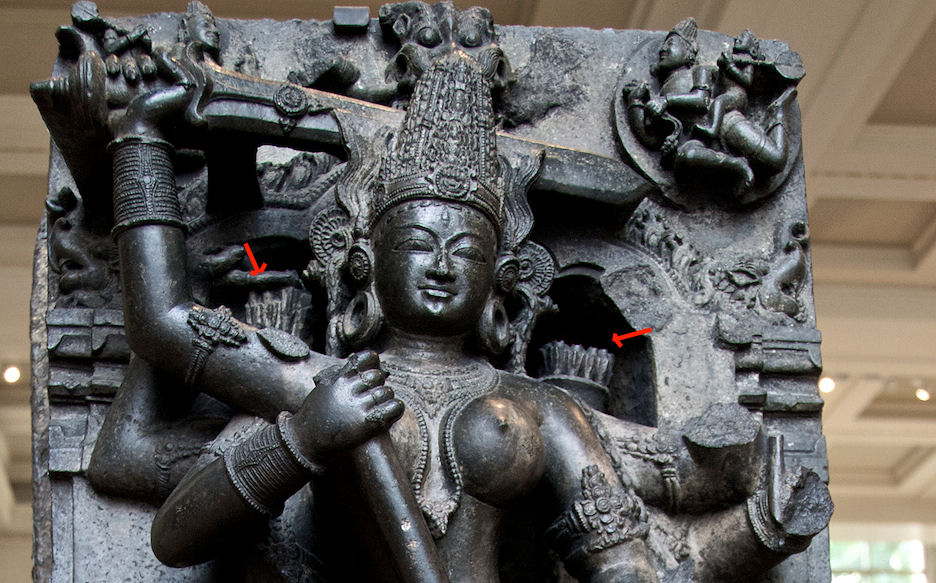
Abb.: तूण्यौ । तूणौ । तूनीरौ । Mahiṣāsuramardinī, Orissa, 13. Jhdt. n. Chr.
[Bildquelle: Peter Rivera. --
http://www.flickr.com/photos/riverap1/3731118876/. -- Zugriff am
2011-06-15. --
Creative Commons Lizenz (Namensnennung)]
उ
पासङ्ग - upāsaṅga m.: "Anhänger", Köcher
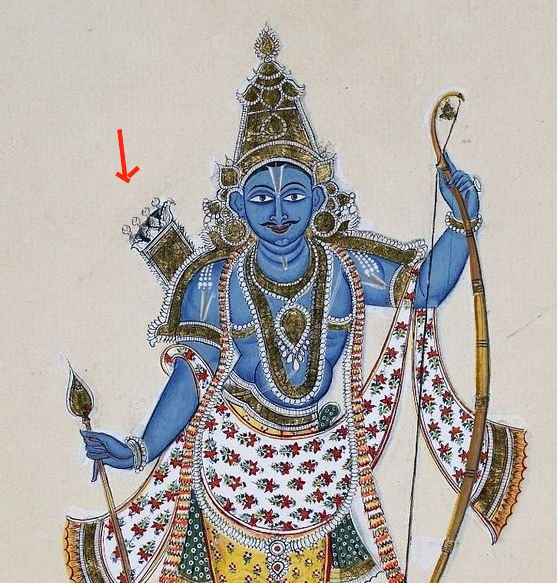
Abb.: उपासङ्गः । Rāma, Südindien, um 1816
[Bildquelle: Wikimedia. -- Public domain]
निषङ्ग - niṣaṅga m.: "Herunterhänger", Köcher, Schwert
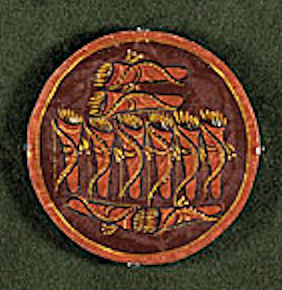
Abb.: निषङ्गाः । 10 Köcher, Spielkarte eines Daśāvatāra-Ganjiva-Sets (كنجفه)
19. Jhdt
[Bildquelle: Wikimedia. -- Public domain]
इषुधि - iṣudhi m., f.: Pfeilbehälter
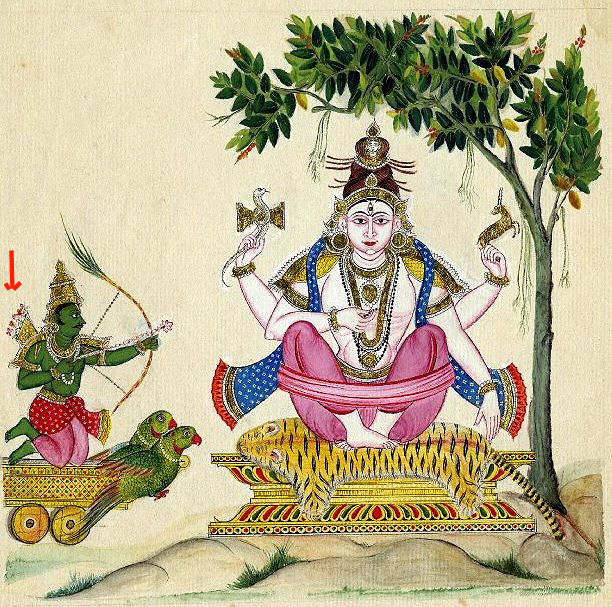
Abb.: इषुधिः । Kāma attackiert Śiva, ca. 1820
[Bildquelle: Wikimedia. -- Public domain]
|
57a./b.
tūṇyāṃ khadge tu
nistriṃśa-candrahāsāsi-riṣṭayaḥ 57c./d. kaukṣeyako maṇḍalāgraḥ karapālaḥ kṛpāṇavat
तूण्यां खद्गे तु
निस्त्रिंश-चन्द्रहासासि-रिष्टयः ।५७ क। Bezeichnungen für Schwert (खद्ग - khadga m.: Schwert, Nashorn):
|
Colebrooke (1807): "A scimitar."
Siehe auch Vers 38c/d.
खद्ग - khadga m.: Schwert, Nashorn
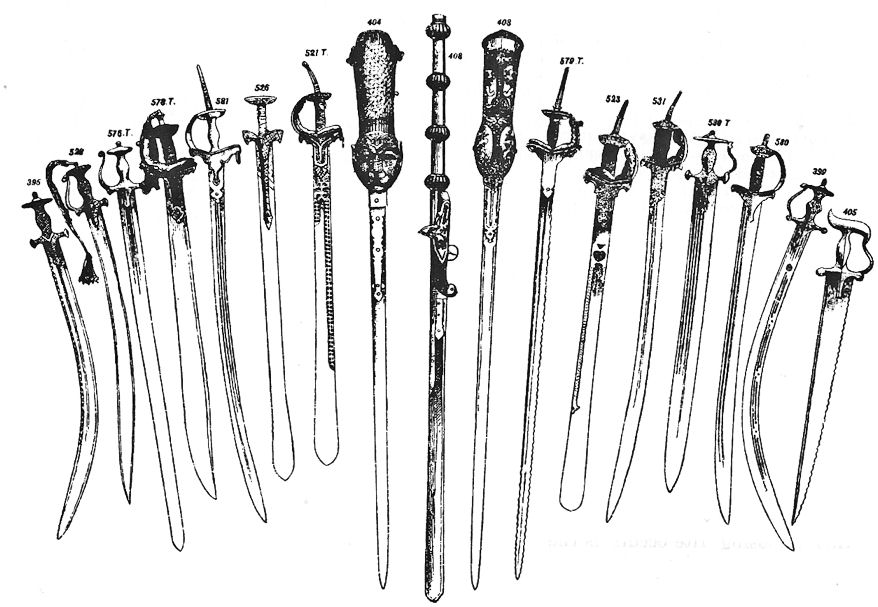
Abb.: खद्गाः । Indische Schwerter
[Bildquelle: Egerton, Wilbraham Egerton, Earl <1832-1909>: A description of
Indian and Oriental armour : illustrated from the collection formerly in the
India Office, now exhibited at South Kensington, and the author’s private
collection, with a map, twenty-three full-page plates (two coloured), and
numerous woodcuts, with an introductory sketch of the military history of
India / by the Right Hon. Lord Egerton of Tatton. -- New ed. --
London : Allen, 1896. -- Fig. 2]
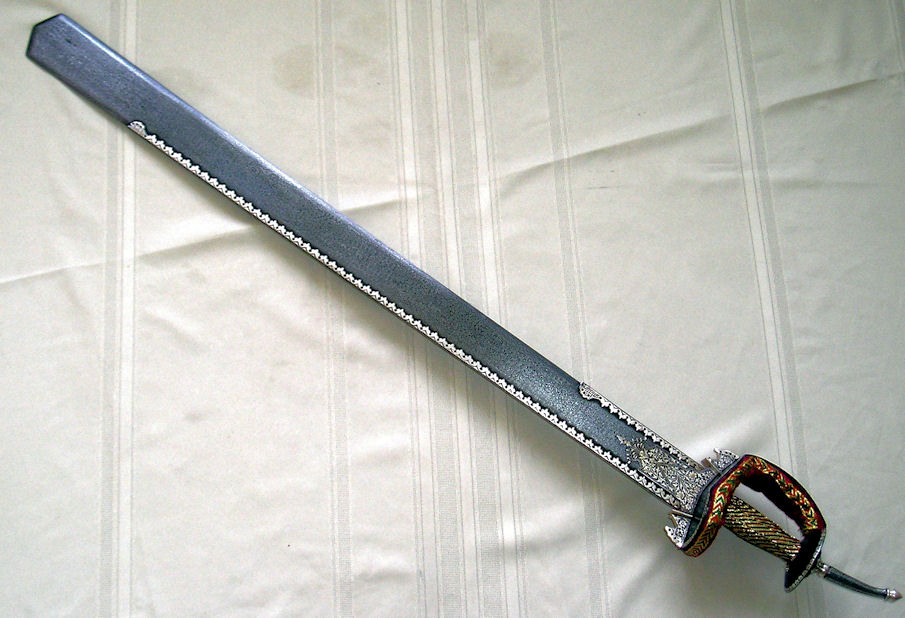
Abb.: खद्गः । Rājput-Khanda
[Bildquelle: Archit Patel / Wikipedia. -- Public domain]
निस्त्रिंश - nistriṃśa m.: mehr als 30, grausam, Schwert
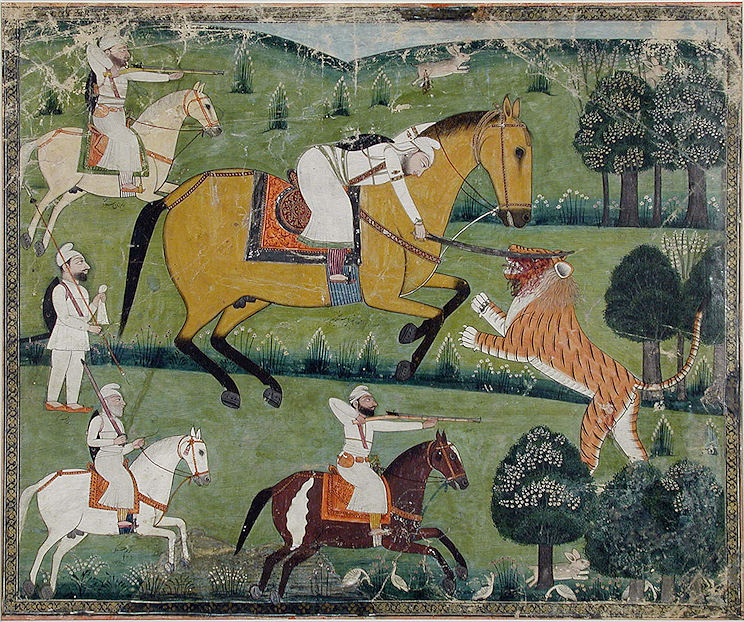
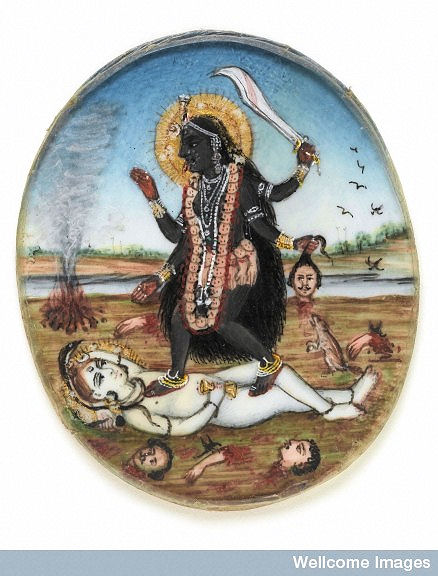
Abb.: निस्त्रिंशः । Kālī, auf Śiva tanzend, 19. Jhdt.
[Bildquelle: Wellcome Images. --
Creative Commons
Lizenz (Namensnennung, keine kommerzielle Nutzung)]
चन्द्रहास - candrahāsa m.: "Lachen des Mondes", Schwert
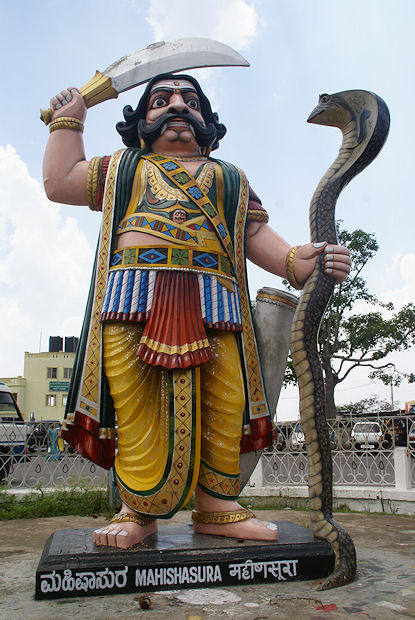
Abb.: चन्द्रहासः । Mahīṣāsura mit Schwert, Mysore -
ಮೈಸೂರು, Karnataka
[Bildquelle: Patrik M. Loeff. --
http://www.flickr.com/photos/bupia/2407358984/. -- Zugriff am
2011-04-17. --
Creative Commons Lizenz (Namensnennung, keine kommerzielle Nutzung,
keine Bearbeitung)]
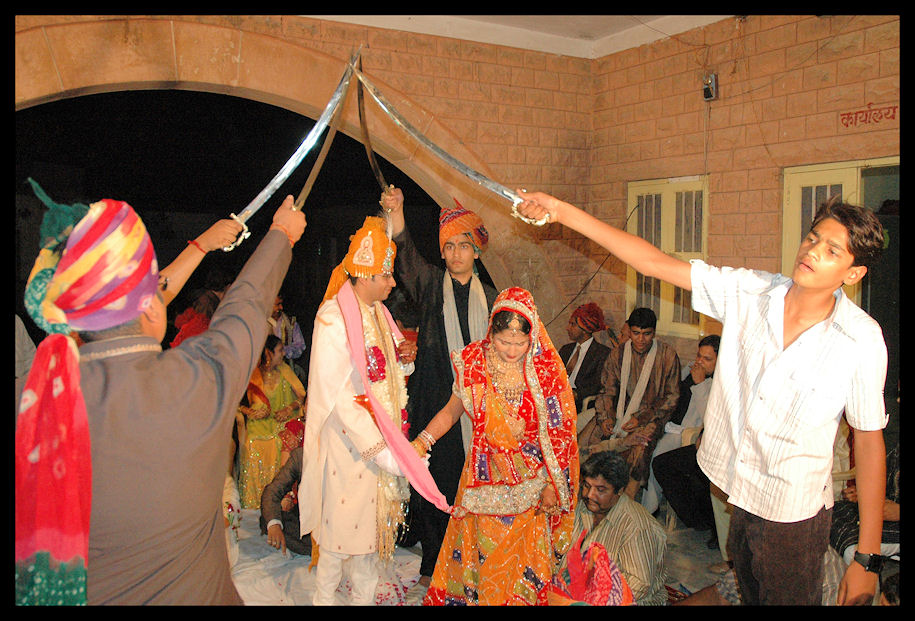
Abb.: चन्द्रहासाः । Hochzeit, Jodhpur -
जोधाणा, Rajasthan
[Bildquelle: Shreyans Bhansali. --
http://www.flickr.com/photos/thebigdurian/137668876/. -- Zugriff am
2011-06-15. --
Creative
Commons Lizenz (Namensnennung, keine kommerzielle Nutzung, share alike)]
अ
सि - asi m.: Schwert
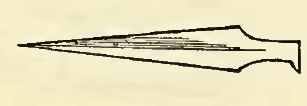
Abb.: असिः । Schwert, Kupfer, Indian Museum
[Bildquelle: Mitra, Rājendralāla <1824-1891>: Indo-Aryans: contributions
towards the elucidation of their ancient and mediaeval history. -- London :
Stanford, 1881. -- 2 Bde. : Ill. ; 23 cm. -- Bd. 1, S. 320]


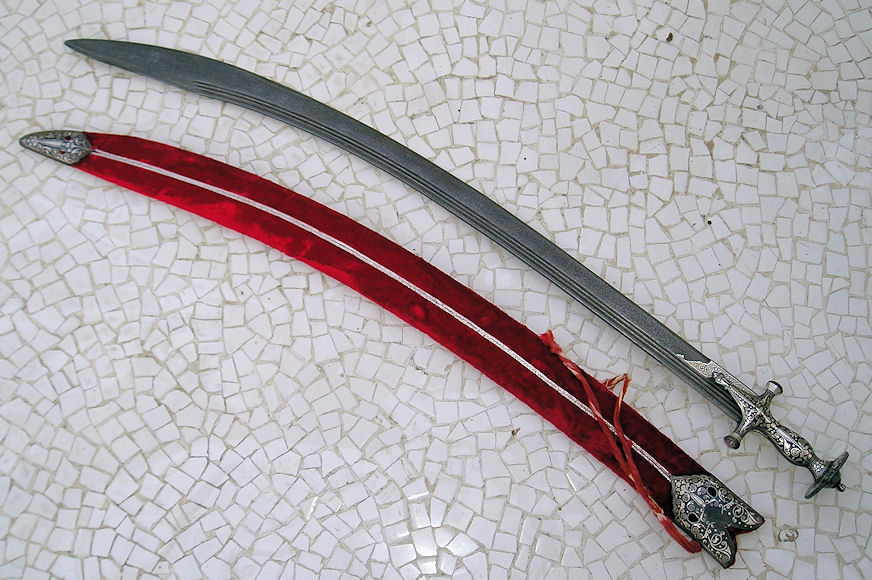
Abb.:
रिष्टि - riṣṭi m.: Schädigung, Schwert
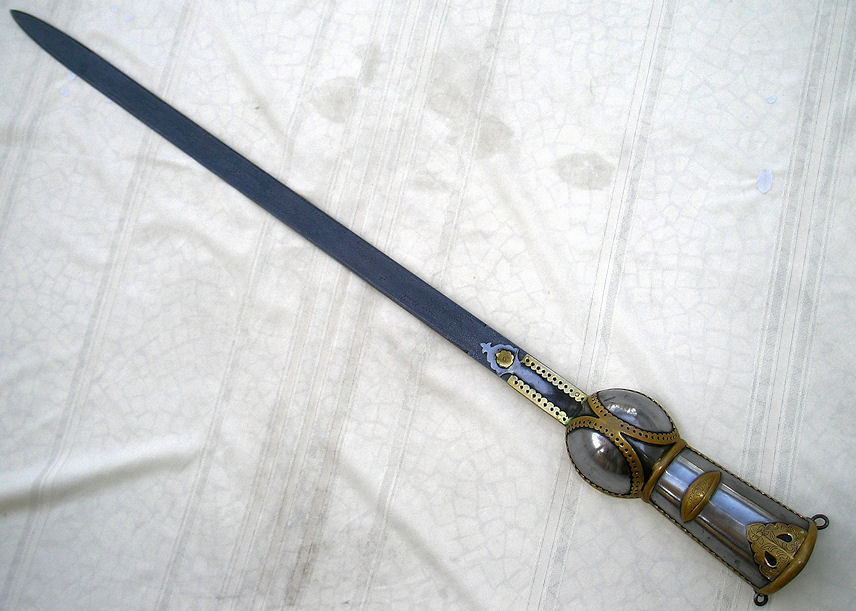
Abb.: रिष्टिः । Pata (पट)-Schwert mit 104 cm langer Klinge
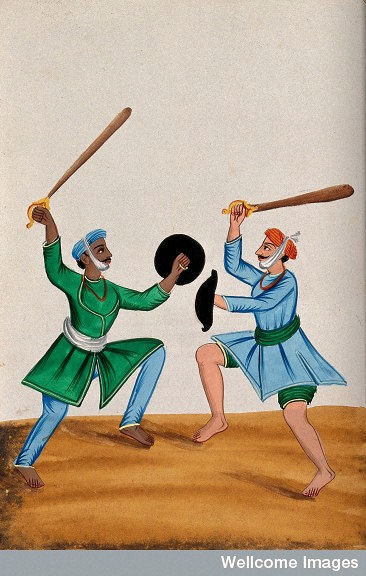
Abb.: रिष्टी । Zwei Sikhs im Kampfsport mit Holzschwertern, 19. Jhdt.
[Bildquelle: Wellcome Images. --
Creative Commons
Lizenz (Namensnennung, keine kommerzielle Nutzung)]
कौक्षेयक - kaukṣeyaka m.: "im Bauch befindlich", "in der Scheide befindlich", Schwert
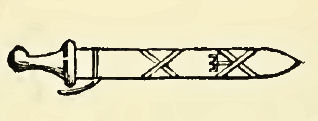
मण्डलाग्र - maṇḍalāgra m.: dessen Spitze rund ist, Säbel, Krummsäbel
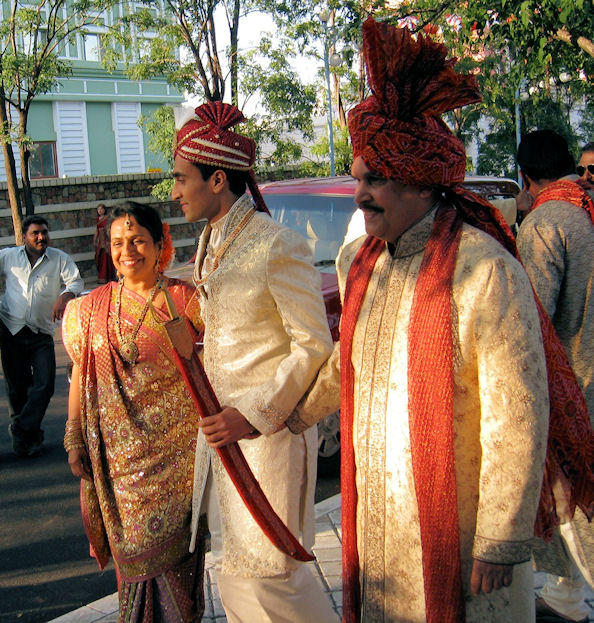
Abb.:
करपाल - karapāla m.: Handschützer, Schwert
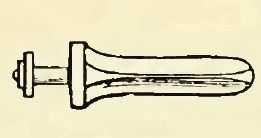
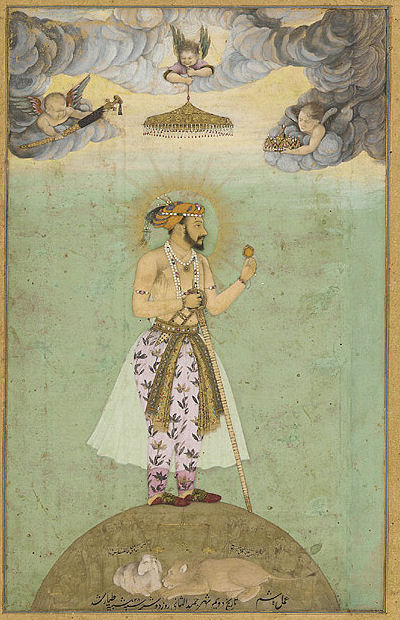
Abb.: करपालः । Shah Jahan mit Firangi (europäischem) Schwert, 17. Jhdt.
[Bildquelle: Wikipedia. -- Public domain]
कृपाण - kṛpāṇa m: Schwert, und ähnliche Wortbildungen
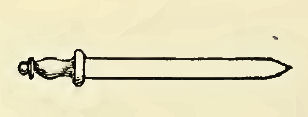
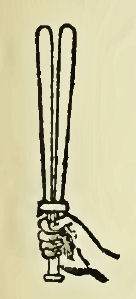
"Schwert, eine zum Hieb oder Hieb und Stich bestimmte Waffe mit gerader ein- oder zweischneidiger, spitziger oder abgestumpfter Klinge. Das Vorhandensein dieser Waffe lässt sich bei allen Völkern bis in das höchste Altertum hinein verfolgen, wie zahlreiche ägyptische, assyrische, indische und persische Denkmäler beweisen. Man unterscheidet beim Schwert den Griff, der sich wieder in Knauf, Griffholz (Hülfe) und Parierstange (Kreuzstange) gliedert, sowie die Klinge mit der zur Befestigung des Griffes dienenden Angel. Das Schwert hat zwar Vorläufer aus Holz, Schwertern vom Schwertfisch u. dgl., in der Stoßkeule, aber erst das kupferne und bronzene Messer und der Dolch gaben die Möglichkeit, aus jenem das einschneidige, aus diesem das zweischneidige Schwert zu entwickeln." [Quelle: Meyers großes Konversations-Lexikon. -- DVD-ROM-Ausg. Faksimile und Volltext der 6. Aufl. 1905-1909. -- Berlin : Directmedia Publ. --2003. -- 1 DVD-ROM. -- (Digitale Bibliothek ; 100). -- ISBN 3-89853-200-3. -- s.v.]
"The sword. The Epic age seems to represent the epoch where the bow is yielding to the sword. The latter is known earlier; it is used, but not so much, like the club, as a secondary weapon. But in the pseudo-Epic the sword has become the emblem of authority. Justice is now incorporated in the sword (asi). This weapon in the final Epic reigns supreme; the bow is an instrument more of the chase than of the battle. In like manner, in the earlier accounts of divine weapons bestowed upon man, the bow is the chief gift; in the later Epic and last interpolations, the deity's gift is a sword. Indra presents Arjuna with the bow Gāṇḍīva; Śiva presents him with the sword Pāśupata. Again, the bow is the first aggressive, the sword the defensive, or secondary aggressive weapon.
The sword, it is further worth noting, is often no more an implement of hand dexterity than a missile, to be cast like a javelin. The former use occurs often, but the latter is still more common. Thus, we have seen above that it is synonymous with sāyaka, or rather, regarded as a species of sāyaka, the general term for missile, but at the same time is ornamented with bells and set in a tiger-skin sheath. As an illustration of this use, compare the verse: 'he was then overwhelmed by (a number of weapons cast at him, namely), sharp arrows, clubs, pestle-clubs, spears, post-clubs, darts, and swords, all spotless and sharp' (iii. 204.24).
We might translate khaḍga here as scimeter, and add asi and nistriṅśa as other common names of swords, but whether there is a distinction between these is not apparent. The asi may be a sabre (often called mahāsi, dīrghāsi, ' long sword') and nistriṅśa a short sword, but I find no Epic data for establishing a difference.
The sword-belt (mekhalā) sustained the sheath (kośa), wherein the sword hung on the left side. The warrior was then one 'whose sword is fastened on,' a common epithet of the knight.
The sword can scarcely have been so weak that a dart could pierce it, and we have to understand poetic exaggeration, perhaps, when in honor of a knight we are told that he cast the dart viśikha so well that it cut a sabre in two. The Epic writers represent the sword and other offensive iron weapons as being a special product of the western countries.
We find, as observed above, that the sword is secondary to the bow and to the club. Thus, to give one instance, when Dhṛṣṭadyumna's bow and club fail, he uses his sword and shield, decorated with a hundred moons (vii. 191 25). The asipatha, or 'path of the sabre,' is often spoken of as the way cut through a crowd by a desperate fighter (compare ratha-patha). Not much can be learned of the sheath and hilt. The former was of leather, and called kośa; the latter is said to be of gold or ivory, and is called tsaru.
The sword was ornamented, like the club, with gold drops or other ornaments. The word dhārā may be applied to the sharp edge of the sword, or to the point, as in śaradhārā like asidhārā.
The dexterity with which the sword is used is extolled (vi. 90. 42), and it could not have been of very great weight, partly because it is used with great quickness (see below), and partly because it is forever breaking in the user's hand. In the following passage, describing the use as a reserve arm, the nistriṅśa is synonymous with the asi: 'then these two, being now deprived of their chariots, rushed together for a strife with the sword (asi). And they shone as they bore the good swords' (nistriṅśa : viii. 13.29-30). The description goes on to give the 'circles' and manoeuvres employed by the contestants. Similar use as a reserve-arm will be found m other passages. In all, the knight leaves the war-car 'bearing sword and shield.' Such sword-manoeuvres are not described in detail, but they are in part mentioned by name, and further explained by the commentator. In one passage twenty-one manoeuvres are accredited to one warrior, the technicality indicating lateness.
An able warrior may advantageously pit a sword against a bow. The man is usually represented as running amuck through the ranks, slashing everything he meets, even to the parte of war-cars. But sometimes a regular duel takes place between the sword-bearer and bow-bearere. Thus, in one passage, Bhīma seizes ia sword and a bull's hide shield (ārṣabhaṃ carma) decorated with gold stars and crescents, and meets his antagonist who stands 'fingering the bow-string' and at last shoots. But Bhīma cuts the arrow in two with the sword.
The sword appears to have been worn at all times, as a fully equipped knight is described as bearing a breastplate and arrows, and a sword and a bow. But while fighting in the car, the swords were very likely hung on the side. In the Rāmāyaṇa (vi.51.18), we have a war-car described wherein were thirty-two quivers, many bows and clubs, and two swords, one on each side, with hilts four hands long, themselves ten hands.
In the latest portion of our poem, the pseudo-Epic claims that the bow is the 'first' weapon and the sword 'the foremost.'"
[Quelle: Hopkins, Edward W. (Washburn) <1857 - 1932>: The social and military position of the ruling caste in ancient India; as represented by the Sanskrit epic; with an appendix on the status of woman. -- Reprint from the 13th volume of the Journal of the American Oriental Society (1888). -- New Haven, Conn. : Tuttle, 1889. -- S. 284-287]
|
58a./b. tsaruḥ khaḍgādimuṣṭau syān mekhalā tannibandhanam त्सरुः खड्गादिमुष्टौ स्यान् मेखला तन्निबन्धनम् ॥५८ ख॥ Der Faustgriff von Schwertern u. ä. heißt त्सरु - tsaru m.: "Schleicher", Stiel, Griff |
Colebrooke (1807): "A hilt or handle."
त्सरु - tsaru m.: "Schleicher", Stiel, Griff
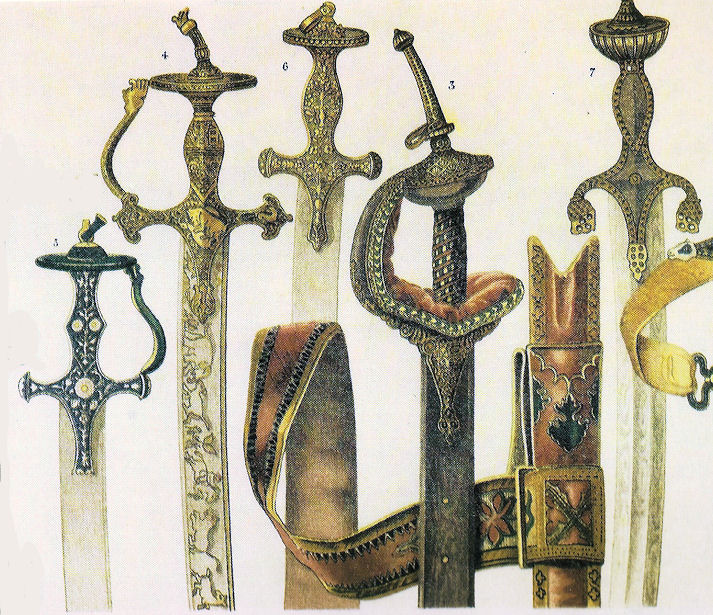
Abb.: त्सरवः । Indische Schwertgriffe
[Bildquelle: Egerton, Wilbraham Egerton, Earl <1832-1909>: A description of
Indian and Oriental armour : illustrated from the collection formerly in the
India Office, now exhibited at South Kensington, and the author’s private
collection, with a map, twenty-three full-page plates (two coloured), and
numerous woodcuts, with an introductory sketch of the military history of
India / by the Right Hon. Lord Egerton of Tatton. -- New ed. --
London : Allen, 1896.]
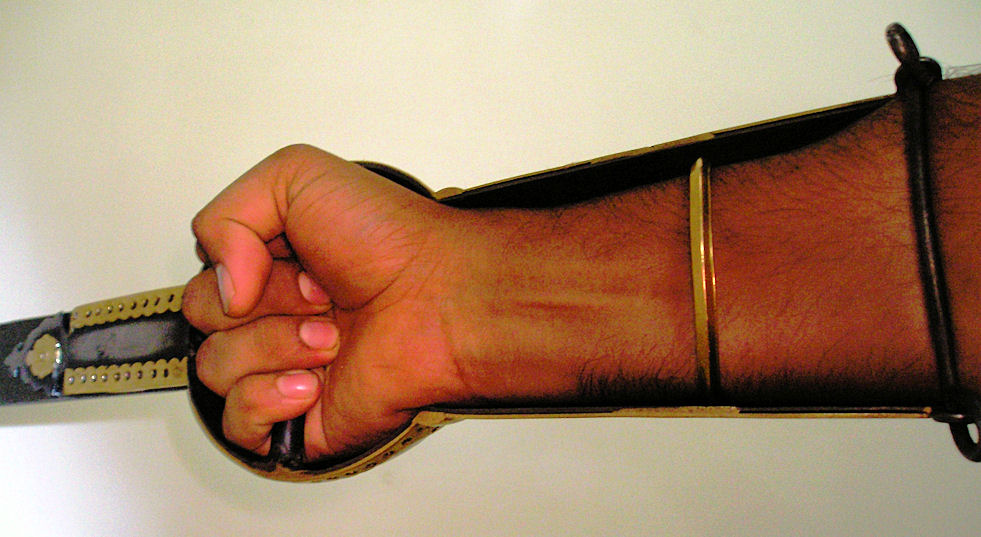
Abb.:
त्सरुः । Griff eines Pata (पट)-Schwerts
mit 104 cm langer Klinge
|
58a./b.
tsaruḥ khaḍgādimuṣṭau syān mekhalā
tannibandhanam त्सरुः खड्गादिमुष्टौ स्यान् मेखला तन्निबन्धनम् ॥५८ ख॥ Die Befestigung von Schwert u. ä. heißt मेखला - mekhalā f.: Gurt, Gürtel |
Colebrooke (1807): "A sword knot. A thong or chain passing from the hilt over the wrist, to secure the sword : some say the guard of the hilt."
मेखला - mekhalā f.: Gurt, Gürtel
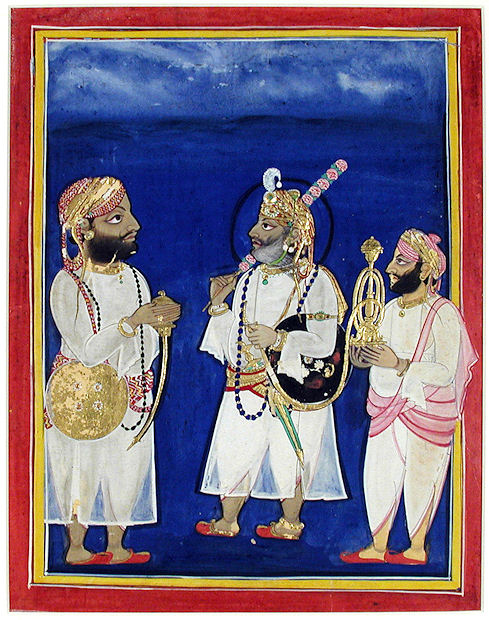
Abb.: मेखला । Maharana mit zwei Dienern, Mewar - मेवाड़, Rajasthan
[Bildquelle: Asian Curator at The San Diego Museum of
Art. --
http://www.flickr.com/photos/asianartsandiego/4838306674/. -- Zugriff am
2011-06-15. --
Creative Commons Lizenz (Namensnennung, keine kommerzielle Nutzung,
keine Bearbeitung)]
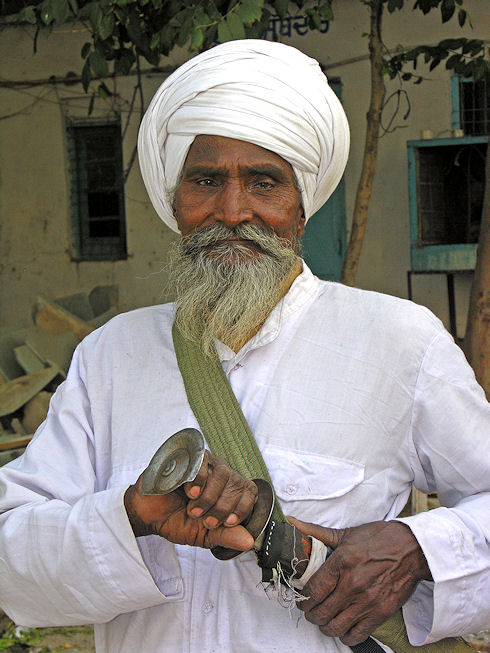
Abb.: मेखला । Delhi
[Bildquelle: Dennis Jarvis. --
http://www.flickr.com/photos/archer10/2214312137/. -- Zugriff am
2011-06-15. --
Creative
Commons Lizenz (Namensnennung, share alike)]
|
58c./d. phalako 'strī phalaṃ carma saṃgrāho muṣṭir asya yaḥ फलको ऽस्त्री फलं चर्म संग्राहो मुष्टिर् अस्य यः ॥५८ ख॥[Bezeichnungen für Schild:]
|
Colebrooke (1807): "A shield."
Siehe auch Vers 39a/b.
फलक - phalaka m., n.: Brett, Schild
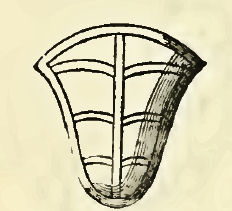
Abb.: फलकः । Schild, Sanchi - सांची, Madhya Pradesh
[Bildquelle: Mitra, Rājendralāla <1824-1891>: Indo-Aryans: contributions
towards the elucidation of their ancient and mediaeval history. -- London :
Stanford, 1881. -- 2 Bde. : Ill. ; 23 cm. -- Bd. 1, S. 326]
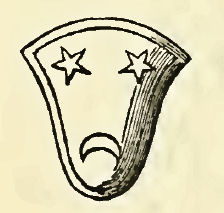
Abb.: फलकः । Schild, Sanchi - सांची, Madhya Pradesh
[Bildquelle: Mitra, Rājendralāla <1824-1891>: Indo-Aryans: contributions
towards the elucidation of their ancient and mediaeval history. -- London :
Stanford, 1881. -- 2 Bde. : Ill. ; 23 cm. -- Bd. 1, S. 326]
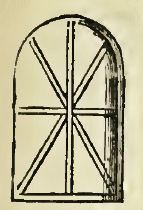
Abb.: फलकः । Schild
[Bildquelle: Mitra, Rājendralāla <1824-1891>: Indo-Aryans: contributions
towards the elucidation of their ancient and mediaeval history. -- London :
Stanford, 1881. -- 2 Bde. : Ill. ; 23 cm. -- Bd. 1, S. 327]
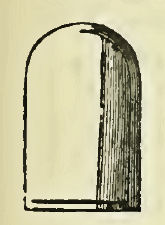
Abb.: फलकः । Schild
[Bildquelle: Mitra, Rājendralāla <1824-1891>: Indo-Aryans: contributions
towards the elucidation of their ancient and mediaeval history. -- London :
Stanford, 1881. -- 2 Bde. : Ill. ; 23 cm. -- Bd. 1, S. 327]
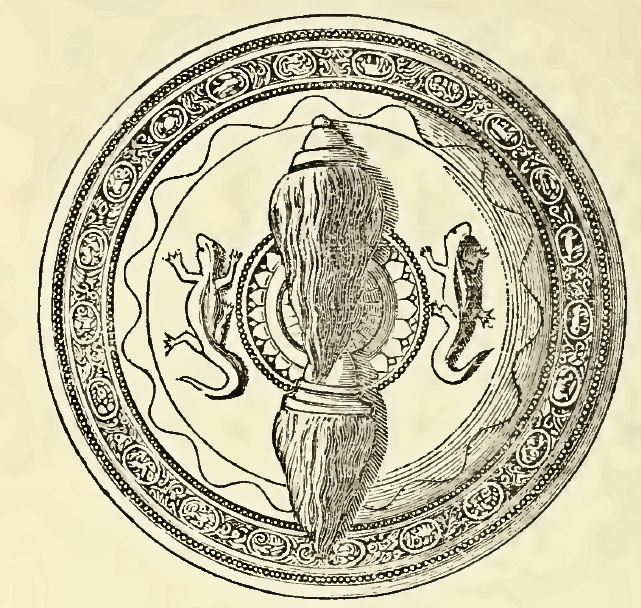
Abb.: फलकः । Schild, Konark - କୋଣାର୍କ, Orissa
[Bildquelle: Mitra, Rājendralāla <1824-1891>: Indo-Aryans: contributions
towards the elucidation of their ancient and mediaeval history. -- London :
Stanford, 1881. -- 2 Bde. : Ill. ; 23 cm. -- Bd. 1, S. 328]
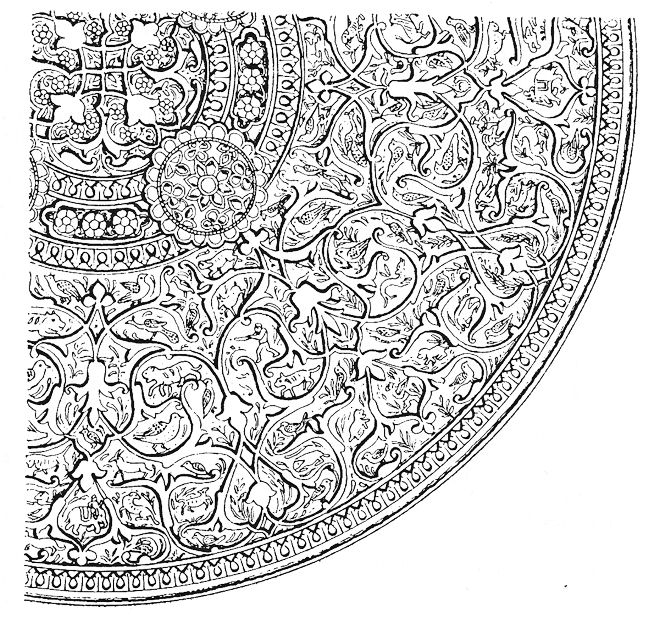
Abb.: फलकः । Teilansicht eines Schilds aus Lahore -
لاہور
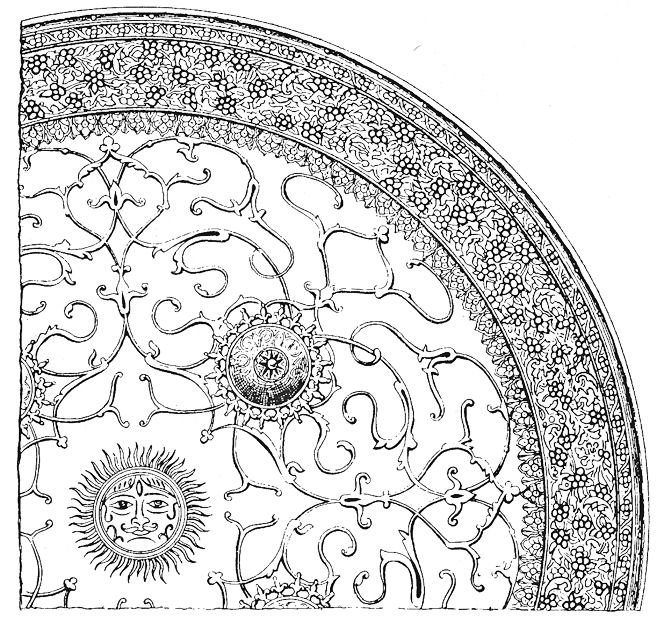
Abb.: फलकः । Teilansicht eines Schilds aus Udaipur - उदयपुर, Rajasthan
[Bildquelle: Egerton, Wilbraham Egerton, Earl <1832-1909>: A description of
Indian and Oriental armour : illustrated from the collection formerly in the
India Office, now exhibited at South Kensington, and the author’s private
collection, with a map, twenty-three full-page plates (two coloured), and
numerous woodcuts, with an introductory sketch of the military history of
India / by the Right Hon. Lord Egerton of Tatton. -- New ed. --
London : Allen, 1896. -- Fig. 7]
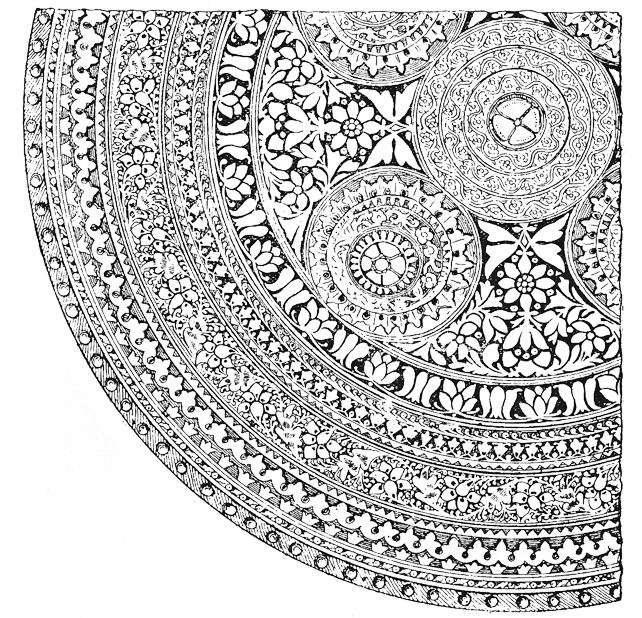
Abb.: फलकः । Teilansicht eines Schilds aus Udaipur - उदयपुर, Rajasthan
[Bildquelle: Egerton, Wilbraham Egerton, Earl <1832-1909>: A description of
Indian and Oriental armour : illustrated from the collection formerly in the
India Office, now exhibited at South Kensington, and the author’s private
collection, with a map, twenty-three full-page plates (two coloured), and
numerous woodcuts, with an introductory sketch of the military history of
India / by the Right Hon. Lord Egerton of Tatton. -- New ed. --
London : Allen, 1896. -- Fig. 8]
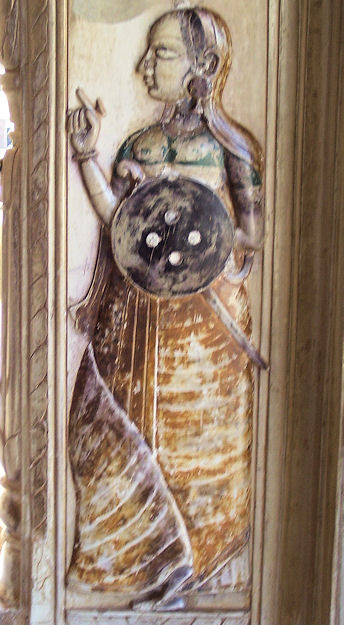
Abb.: फलकः । Frau mit Schild, Udaipur - उदयपुर, Rajasthan
[Bildquelle: Jeff Hart. --
http://www.flickr.com/photos/ipeguy/5368801649/. -- Zugriff am
2011-04-16. --
Creative
Commons Lizenz (Namensnennung)]
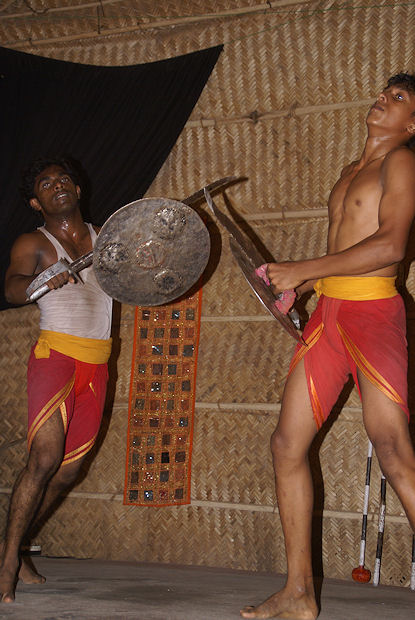
Abb.: फलकौ । Kampf mit Schwert und Schild im keralesischen Kampfsport
Kalarippayattu - കളരിപ്പയറ്റ്,
Kochi - കൊച്ചി,
Kerala
[Bildquelle: Patrik M. Loeff. --
http://www.flickr.com/photos/bupia/2403834124/. -- Zugriff am
2011-04-16. --
Creative Commons Lizenz (Namensnennung, keine kommerzielle Nutzung,
keine Bearbeitung)]
फल - phala n.: Frucht, Brett
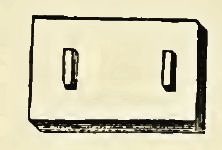
Abb.: फलम् । Schild, Indian Museum
[Bildquelle: Mitra, Rājendralāla <1824-1891>: Indo-Aryans: contributions
towards the elucidation of their ancient and mediaeval history. -- London :
Stanford, 1881. -- 2 Bde. : Ill. ; 23 cm. -- Bd. 1, S. 326]
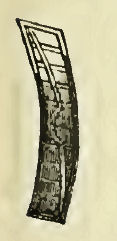
Abb.: फलम् । Schild, Museum Asiatic Society, Kolkata
[Bildquelle: Mitra, Rājendralāla <1824-1891>: Indo-Aryans: contributions
towards the elucidation of their ancient and mediaeval history. -- London :
Stanford, 1881. -- 2 Bde. : Ill. ; 23 cm. -- Bd. 1, S. 327]
चर्मन् - carman n.: Haut, Fell, Leder, Schild
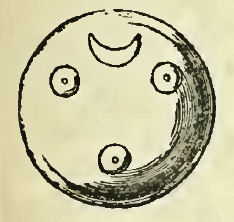
Abb.: चर्म । Schild,
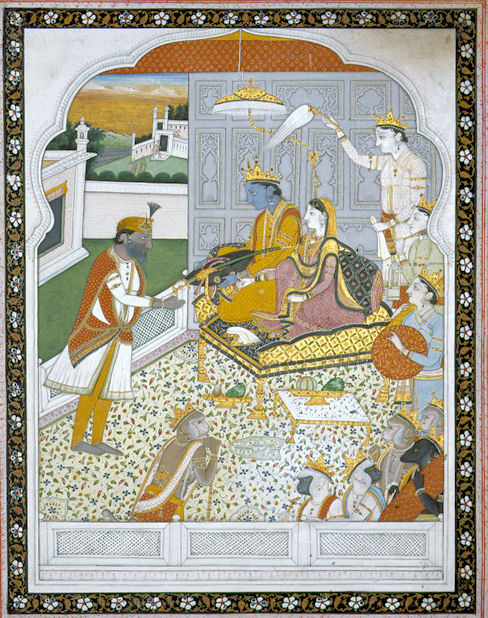
Abb.: चर्म । Mahārāja Gulab Singh erhält von Rāma Schild und Schwert, Jammu und
Kaschmir, ca. 1830
"Schild, Schutzwaffe gegen Hieb, Stich und gegen Wurfgeschosse aller Art (Pfeile, Speere, Kugeln). Der Schild ist zweifellos jünger als die ältesten Angriffswaffen; dennoch reicht er in sehr frühe Entwickelungsstufen der menschlichen Kultur zurück; auch ist er über alle Erdteile verbreitet. Lücken bestehen vorwaltend in Gebieten des Gebrauchs von Bogen und Pfeil, die ja beim Gebrauch beider Hände bedürfen und daher im allgemeinen die Verwendung des Schildes ausschließen. Lediglich die Eingebornen einiger Gebiete Indonesiens (Aruinseln) und Melanesiens (Neuguinea) verwenden beide zusammen. Wo sonst in Bogengebieten Schilde gebraucht werden, ist ein besonderer Träger nötig (Wute in Kamerun)." [Quelle: Meyers großes Konversations-Lexikon. -- DVD-ROM-Ausg. Faksimile und Volltext der 6. Aufl. 1905-1909. -- Berlin : Directmedia Publ. --2003. -- 1 DVD-ROM. -- (Digitale Bibliothek ; 100). -- ISBN 3-89853-200-3. -- s.v.]
"Next to the varman and kavaca comes the shield, called carman, which is of leather adorned with figures (vi. 54.26 if.); or a simple tiger-skin or bear-skin worn over the body besides the brazen breastplate served as a shield. The shield (that is, here a real shield, worn as a plate) might have as many as three bosses according to the pseudo-Epic, but not in earlier portions. I judge, perhaps from too slight evidence, that the shield of the chariot-knight was not worn from the beginning of battle, but rested in his car, and was grasped when it came to sword-fighting. First, it seems impossible that a knight should use a bow with even a little shield tied to his arm; and second, we find that a knight who performs the usual act of quitting the bow and the chariot is described as 'drawing his sword and seizing his shield,' which must, therefore, have lain waiting in the car. I have no passage to prove that the little bells adorning the spears are also found on the shield, though I am not sure that such shields may not be mentioned. The custom is well known to the Greeks (Aeschylus, Septem, 385)."
[Quelle: Hopkins, Edward W. (Washburn) <1857 - 1932>: The social and military position of the ruling caste in ancient India; as represented by the Sanskrit epic; with an appendix on the status of woman. -- Reprint from the 13th volume of the Journal of the American Oriental Society (1888). -- New Haven, Conn. : Tuttle, 1889 -- S. 305f.]
|
58c./d. phalako 'strī phalaṃ carma
saṃgrāho muṣṭir asya yaḥ फलको ऽस्त्री फलं चर्म संग्राहो मुष्टिर् अस्य यः ॥५८ ख॥Der Faustgriff des Schildes heißt संग्राह - saṃgrāha m.: Griff |
Colebrooke (1807): "The gripe of a shield."
संग्राह - saṃgrāha m.: Griff
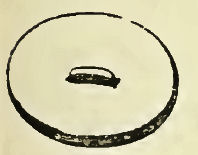
Abb.: संग्राहः । Schild,
Bhubaneswar - ଭୁବନେଶ୍ବର, Orissa
[Bildquelle: Mitra, Rājendralāla <1824-1891>: Indo-Aryans: contributions
towards the elucidation of their ancient and mediaeval history. -- London :
Stanford, 1881. -- 2 Bde. : Ill. ; 23 cm. -- Bd. 1, S. 325]
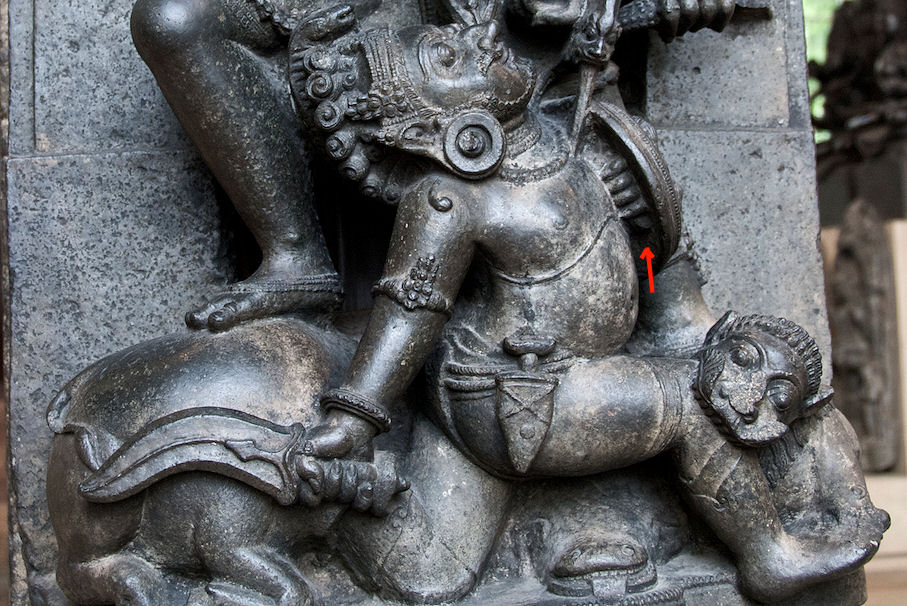
|
59a./b. drughaṇe mudgara-ghanau syād īlī karapālikā द्रुघणे मुद्गर-घनौ स्याद् ईली करपालिका ।५९ क। Bezeichnungen für Streithammer (द्रुघण - drughaṇa m.: Holz-Schläger, Hammer, Holzkeule, Keil):
|
Colebrooke (1807): "A mallet. A weapon formed like a carpenters hammer."
"The hammer, mudgara, is of iron (ayoghana), and is distinctly a missile, being cast with the laguḍa and with stones (upala). The divinities, as shown in the Indra-Vṛtra scene, employ the mudgara along with the sword and spear, etc."
[Quelle: Hopkins, Edward W. (Washburn) <1857 - 1932>: The social and military position of the ruling caste in ancient India; as represented by the Sanskrit epic; with an appendix on the status of woman. -- Reprint from the 13th volume of the Journal of the American Oriental Society (1888). -- New Haven, Conn. : Tuttle, 1889 -- S. 291]
|
59a./b.
drughaṇe mudgara-ghanau syād īlī
karapālikā द्रुघणे मुद्गर-घनौ स्याद् ईली करपालिका ।५९ क। [Bezeichnungen für Schlagstock:]
|
Colebrooke (1807): "A cudgel. Some explain it a short sword ; others, a stick shaped like a sword."
ईली - īlī f.: "eine bes. Art Waffe, ein kurzes einschneidiges Schwert" (PW), wohl eher: Schlagstock

Abb.:

Abb.:

Abb.: ईली । Schlagstock, Puri - ପୁରୀ, Orissa
[Bildquelle: Mitra, Rājendralāla <1824-1891>: Indo-Aryans: contributions
towards the elucidation of their ancient and mediaeval history. -- London :
Stanford, 1881. -- 2 Bde. : Ill. ; 23 cm. -- Bd. 1, S. 315]
करपालिका - karapālikā f.: Hand-Schützerin", "ein kurzes Schwert oder eine ähnliche Schneidewaffe", wohl eher: Schlagstock
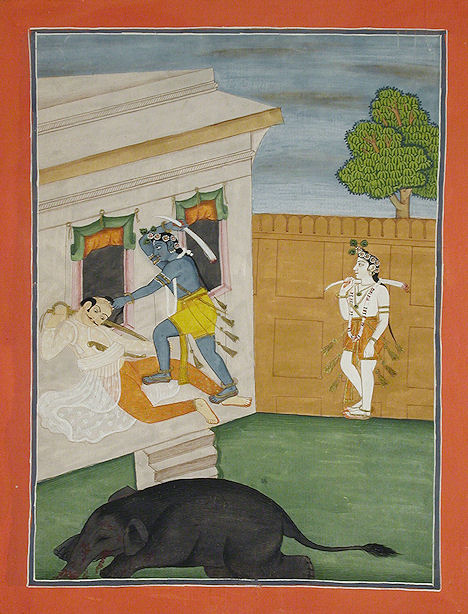
Abb.:
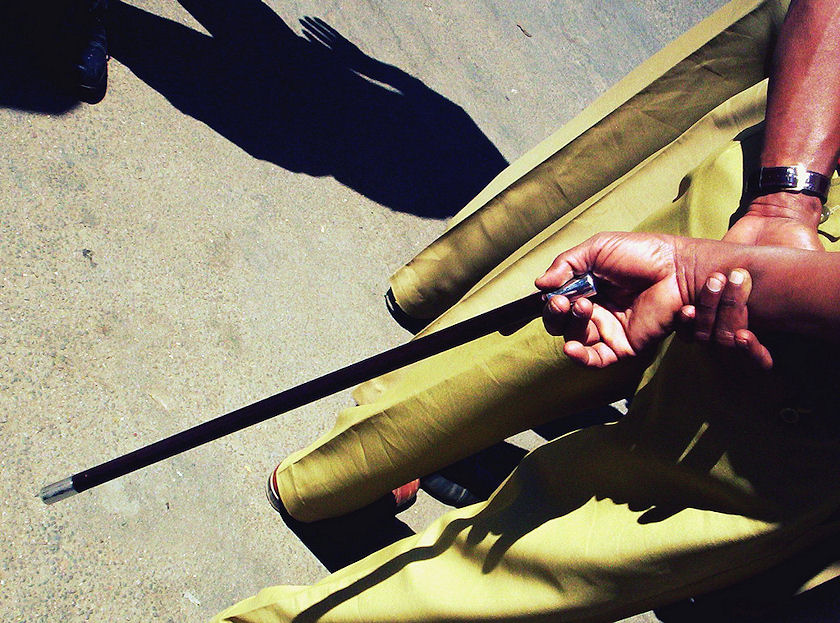
Abb.:
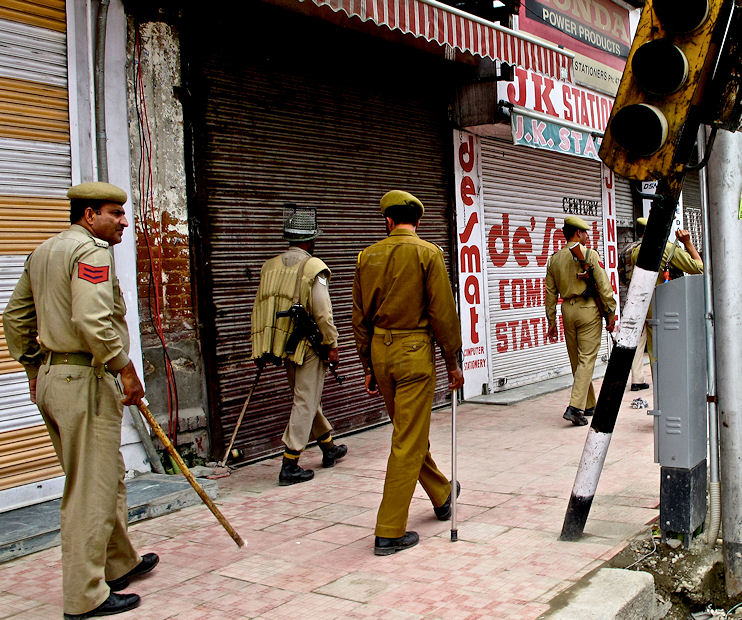
|
59c./d. bhindipālaḥ sṛgas tulyau parighaḥ parighātinaḥ भिन्दिपालः सृगस् तुल्यौ परिघः परिघातिनः ॥५९ ख॥ [Bezeichnungen für Wurfpfeil (?):]
|
Colebrooke (1807): "A short arrow. Thrown by hand ; or as others explain, shot through a tube."
|
59c./d.
bhindipālaḥ sṛgas tulyau parighaḥ
parighātanaḥ भिन्दिपालः सृगस् तुल्यौ परिघः परिघातनः ॥५९ ख॥ [Bezeichnungen für Keule:]
|
Colebrooke (1807): "A bludgeon. Or a staff mounted with iron ; shaped like a pestle:"
परिघातन - parighātana m.: Schläger, Keule
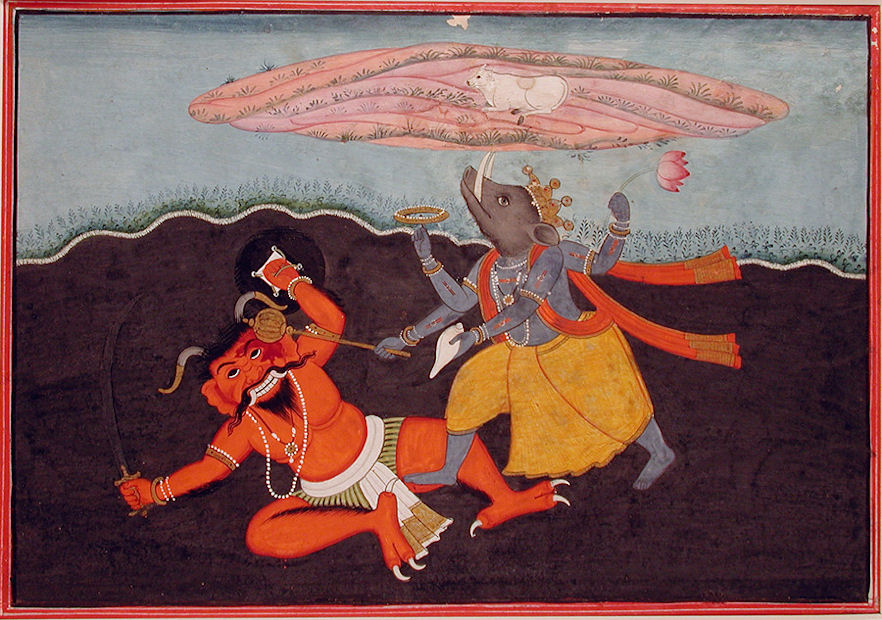
Abb.: परिघातनः । Varāha erschlägt Hiraṇyākṣa, Himachel Pradesh, ca. 1760
[Bildquelle: Asian Curator at The San Diego Museum of Art. --
http://www.flickr.com/photos/asianartsandiego/4837844771/. -- Zugriff am
2011-04-15. --
Creative Commons Lizenz (Namensnennung, keine kommerzielle Nutzung,
keine Bearbeitung)]
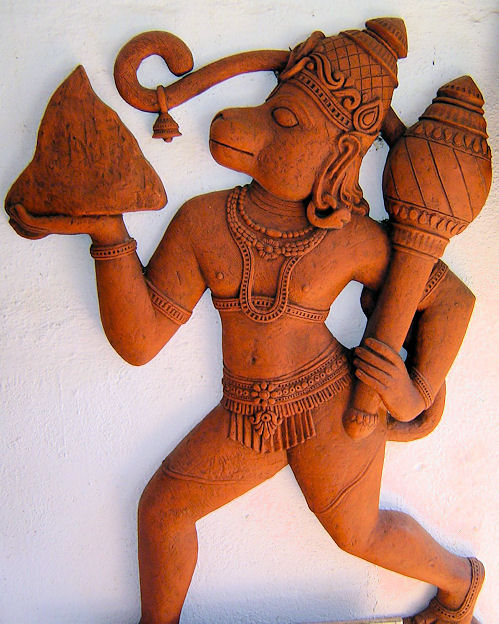
|
60a./b. dvayoḥ kuṭhāraḥ svadhitiḥ paraśuś ca
paraśvadhaḥ द्वयोः कुठारः स्वधितिः परशुश् च परश्वधः ।६० क। [Bezeichnungen für Streitaxt:]
|
Colebrooke (1807): "An axe."
Siehe auch Vers 38a/b.
कुठार - kuṭhāra m., f.: Axt
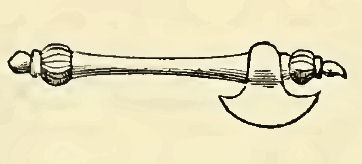
Abb.: कुठारी । Streitaxt
[Bildquelle: Mitra, Rājendralāla <1824-1891>: Indo-Aryans: contributions
towards the elucidation of their ancient and mediaeval history. -- London :
Stanford, 1881. -- 2 Bde. : Ill. ; 23 cm. -- Bd. 1, S. 316]
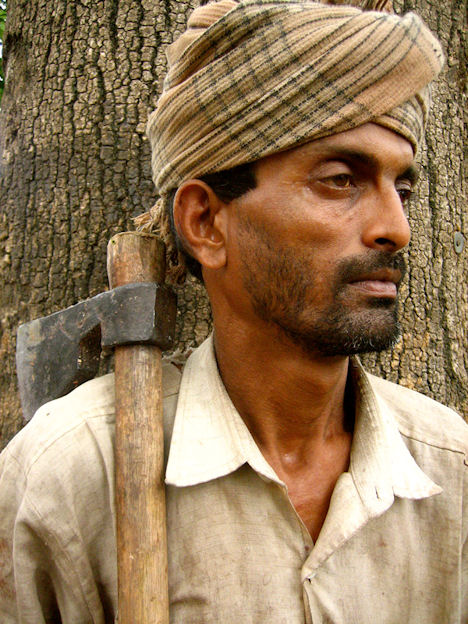
Abb.: कुठारः । Axt, Ahmedabad - અમદાવાદ,
Gujarat
[Bildquelle: Meena Kadri. --
http://www.flickr.com/photos/meanestindian/184629757/. -- Zugriff am
2011-06-16. --
Creative Commons Lizenz (Namensnennung, keine kommerzielle Nutzung,
keine Bearbeitung)]
स्वधिति - svadhiti m., f.: Axt

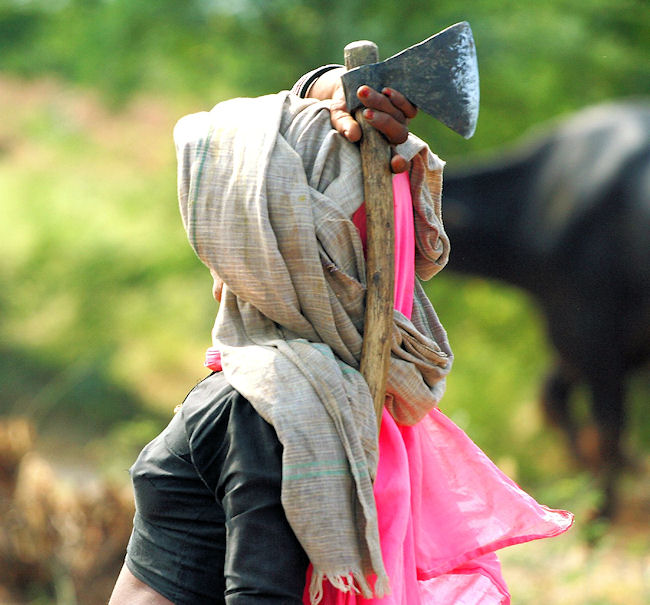
Abb.: स्वधितिः । Rajasthan
[Bildquelle: guy_incognito. --
http://www.flickr.com/photos/guy_incognito/50111440/. -- Zugriff am
2011-06-16. --
Creative
Commons Lizenz (Namensnennung, keine kommerzielle Nutzung, share alike)]
परशु - paraśu m., f.: Axt
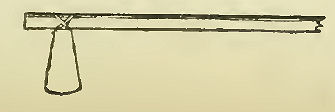
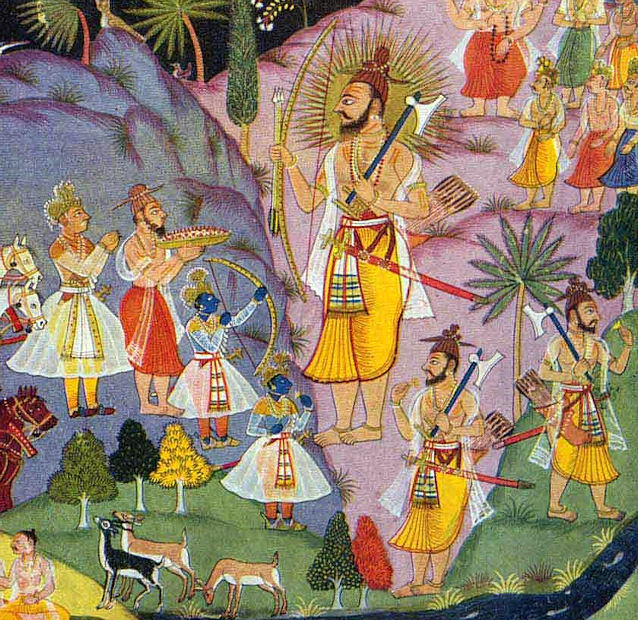
परशुः । Parśurāma, Udaipur - उदयपुर, Rajasthan, 1649
[Bildquelle: Wikipedia. -- Public domain]
परश्वध - paraśvadha m.: Axt

Abb.: परश्वधः । Streitaxt
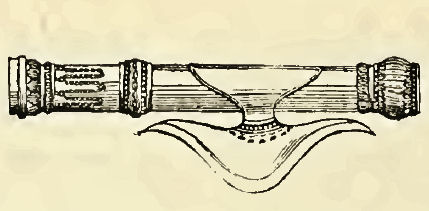
Abb.:
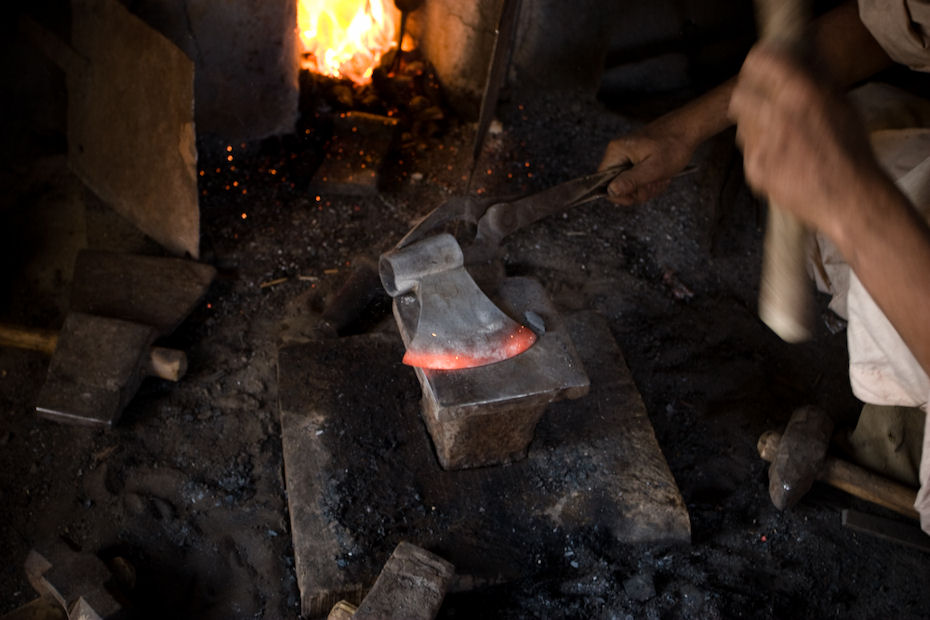
Abb.: परश्वधः । Axt-Schmiede, Bhuj - ભુજ,
Gujarat
[Bildquelle: Owen. --
http://www.flickr.com/photos/owen-pics/2332617914/in/set-72157604077106297/.
-- Zugriff am 2011-06-16. --
Creative Commons
Lizenz (Namensnennung, keine kommerzielle Nutzung, keine Bearbeitung)]
"The axe, paraśvadha, kuliśa, is often mentioned as a missile. It might be termed a royal weapon, being chiefly used by nobles. The battle-axe (kuṭhāra) is Paraśu-Rama's pet weapon. A distinction (unknown) is made between paraśu and paraśvadha." [Quelle: Hopkins, Edward W. (Washburn) <1857 - 1932>: The social and military position of the ruling caste in ancient India; as represented by the Sanskrit epic; with an appendix on the status of woman. -- Reprint from the 13th volume of the Journal of the American Oriental Society (1888). -- New Haven, Conn. : Tuttle, 1889 -- S. 291]
|
60c./d. syāc chastrī cāsiputrī ca churikā
cāsidhenukā स्याच् छस्त्री चासिपुत्री च छुरिका चासिधेनुका ॥६० ख॥ [Bezeichnungen für Messer / Dolch:]
|
Colebrooke (1807): "A knife."
शस्त्री - śastrī f.: "Schneidende", Messer, Dolch
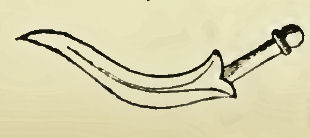
Abb.:
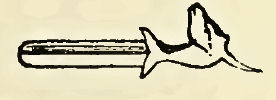
Abb.:
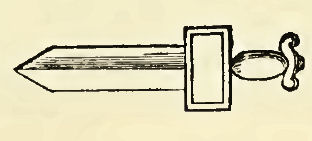
Abb.:
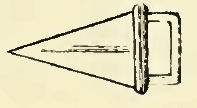
Abb.:

Abb.:

Abb.: Dreifach-Dolch
[Bildquelle: Saad Akhtar. --
http://www.flickr.com/photos/saad/24504939/. -- Zugriff am 2011-04-17.
-- Creative
Commons Lizenz (Namensnennung)]
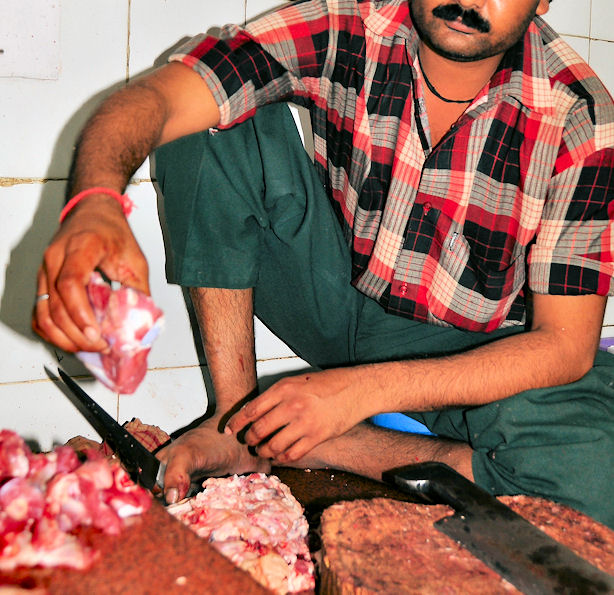
Abb.: शस्त्री । Metzger, Delhi
[Bildquelle: Russ Bowling. --
http://www.flickr.com/photos/robphoto/3064742157/. -- Zugriff am
2011-06-16. --
Creative Commons Lizenz (Namensnennung)]
असिपुत्री - asiputrī f.: Tochter des Schwerts, Messer
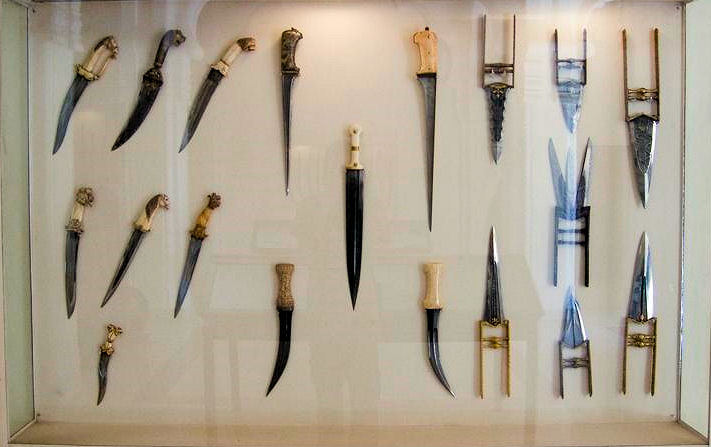
Abb.: असिपुत्र्यः । Jodhpur - जोधाणा, Rajasthan
[Bildquelle: sng. --
http://www.flickr.com/photos/luxagraf/124158195/. -- Zugriff am
2011-06-16. --
Creative
Commons Lizenz (Namensnennung, keine kommerzielle Nutzung, share alike)]
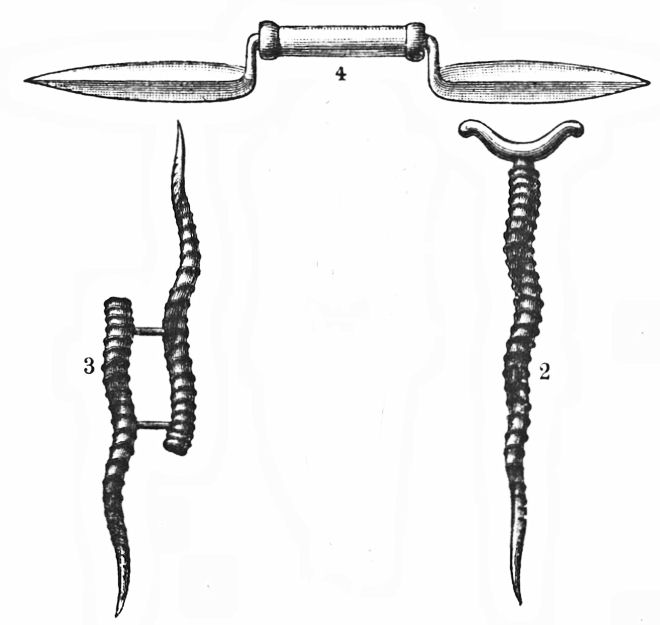
Abb.:
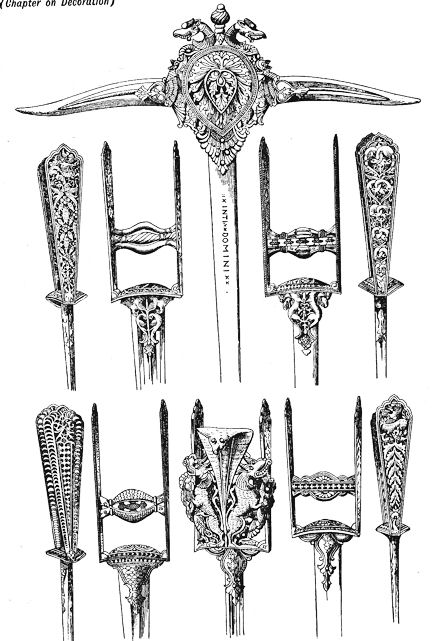
Abb.:
छुरिका - churikā f.: Messer
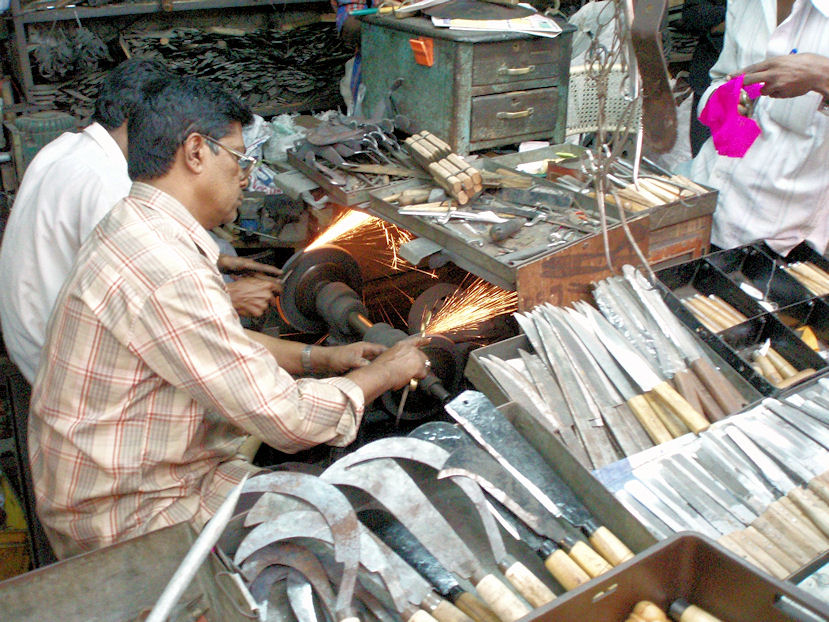
Abb.: छुरिकाः । Mysore - ಮೈಸೂರು,
Karnataka
[Bildquelle: Matthieu Aubry. --
http://www.flickr.com/photos/matthieu-aubry/264974545/. -- Zugriff am
2011-06-16. --
Creative
Commons Lizenz (Namensnennung, keine kommerzielle Nutzung, share alike)]
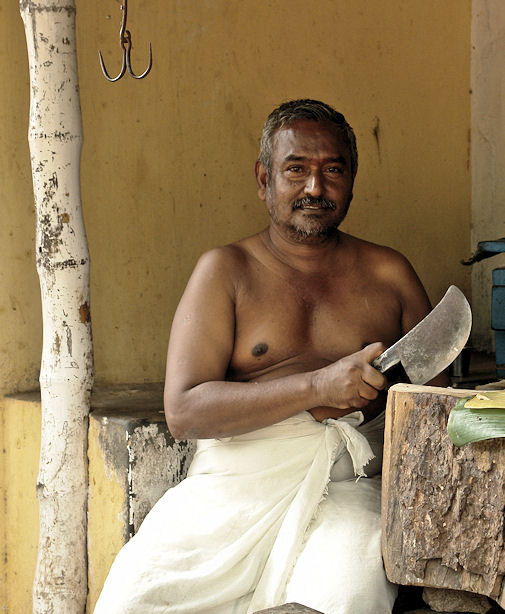
Abb.: छुरिका । Madurai - மதுரை, Tamil
Nadu
[Bildquelle: Sam Bowman. --
http://www.flickr.com/photos/kodama/1012903794/. -- Zugriff am
2011-06-16. --
Creative
Commons Lizenz (Namensnennung, keine kommerzielle Nutzung, share alike)]
असिधेनुका - asidhenukā f.: "deren Milchkuh das Schwert ist = Tochter des Schwerts", Messer
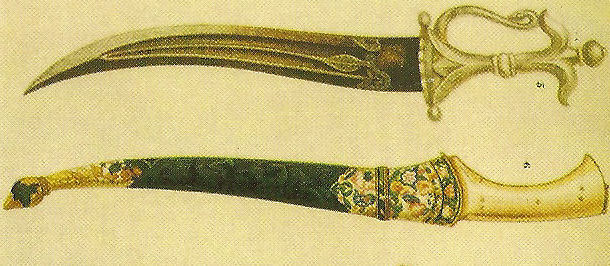
Abb.:

"Dolch (Gnippe, Diglitz, Dielitz, Telitz), kurze Stoßwaffe mit Griff, meist zwei-, auch ein- und dreischneidig." [Quelle: Meyers großes Konversations-Lexikon. -- DVD-ROM-Ausg. Faksimile und Volltext der 6. Aufl. 1905-1909. -- Berlin : Directmedia Publ. --2003. -- 1 DVD-ROM. -- (Digitale Bibliothek ; 100). -- ISBN 3-89853-200-3. -- s.v.]
|
61a./b. vā puṃsi śalyaṃ śaṅkur nā sarvalā tomaro 'striyām वा पुंसि शल्यं शङ्कुर् ना सर्वला तोमरो ऽस्त्रियाम् ।६१ क।[Bezeichnungen für Speer:]
|
Colebrooke (1807): "A javelin."
Siehe auch Vers 37c/d.
शल्य - śalya m., n.: Spitze des Pfeils und Speers, Dorn, Stachel
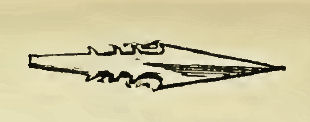
Abb.: शल्यम् । Speerspitze aus Kupfer, Indian Museum
[Bildquelle: Mitra, Rājendralāla <1824-1891>: Indo-Aryans: contributions
towards the elucidation of their ancient and mediaeval history. -- London :
Stanford, 1881. -- 2 Bde. : Ill. ; 23 cm. -- Bd. 1, S. 313]
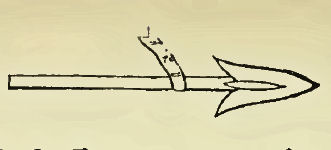
Abb.: शल्यः । Speerspitze, Sanchi - सांची, Madhya Pradesh
[Bildquelle: Mitra, Rājendralāla <1824-1891>: Indo-Aryans: contributions
towards the elucidation of their ancient and mediaeval history. -- London :
Stanford, 1881. -- 2 Bde. : Ill. ; 23 cm. -- Bd. 1, S. 313]
शङ्कु - śaṅku m.: Pflock, Pfeil, Speer
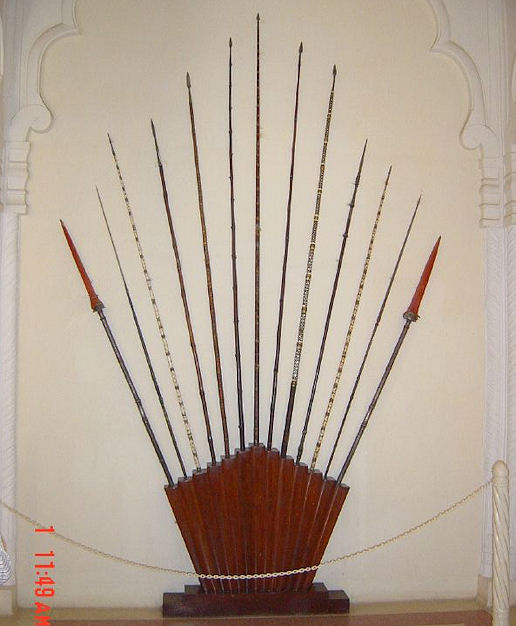
Abb.: शङ्कवः । Jodhpur - जोधाणा, Rajasthan
[Bildquelle: Brajeshwar Oinam. --
http://www.flickr.com/photos/brajeshwar/113611389/. -- Zugriff am
2011-04-14. --
Creative
Commons Lizenz (Namensnennung, keine kommerzielle Nutzung, share alike)]
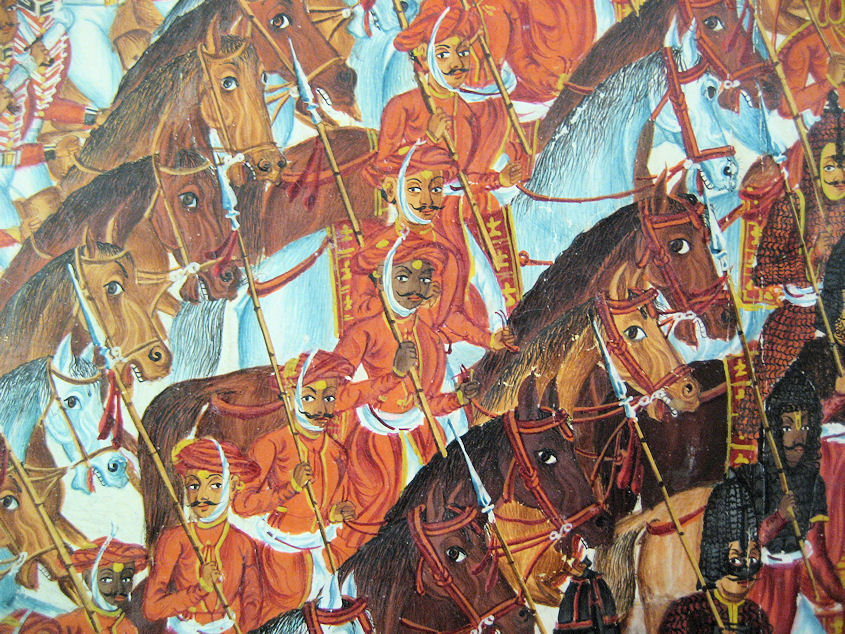
Abb.: शङ्कवः । Speere
[Bildquelle:
Jason Tester
Guerrilla Futures. --
http://www.flickr.com/photos/streamishmc/422519236/. -- Zugriff am
2011-04-17. --
Creative Commons Lizenz (Namensnennung, keine Bearbeitung)]
"Speer (Spieß, Lanze), eine der allgemeinsten Angriffswaffen der Menschheit. Die Urform aller Spieße ist der einfach zugespitzte, event. vorn im Feuer gehärtete Stab. Derartige Urformen sind noch ganz allgemein in den metalllosen Gebieten der Erde (Ozeanien, Australien, Tasmania, Amerika; s. Tafel ð »Indianische Kultur I«, Fig. 19); aber auch im metallreichen Afrika gibt es bei den Wassiba am Westufer des Victoria Nyanza noch reine Holzspieße, ebenfalls bloß aus Holz bestehende sogen. Kampfstöcke sodann bei den Konde am Nordende des Nyassa. Die Weiterbildung zum Spieß mit abnehmbarer Klinge ist in den metalllosen tropischen Erdteilen durch Aufsetzen von Bambus auf Holz (Melanesien), Hartholz auf Bambus (Neu-Irland), zugespitzter Tierknochen (Kasuar in Neuguinea, Eskimo) und geeigneter Tierhörner auf Holz (Nubien), schließlich aber und ganz allgemein durch Anfügung besonders zugespitzter Steinklingen auf den pflanzlichen Schaft erfolgt. Derartige Spieße mit Steinklingen finden sich noch heute auf den Admiralitätsinseln (Obsidian), in Australien, bei den Feuerländern, den Eskimos; sie sind ferner bis in jüngste Zeiten gebräuchlich gewesen bei den Polynesiern und andern Naturvölkern; für die Steinzeit der Vorfahren der alt- und neuweltlichen Naturvölker sind sie geradezu charakteristisch (s. ð Steinzeit). Der Spieß mit angefügter Metallspitze stellt gegenüber dem wegen der Zerbrechlichkeit des Materials doch immerhin primitiven Steinklingenspieß einen gewaltigen Fortschritt dar. Kupferklingen werden bei den Wahumavöltkern und im südlichen Kongobecken noch heute getragen. Sonst ist in Afrika und bei den Naturvölkern Südasiens und Indonesiens der Spieß mit Eisenklinge ganz allgemein, desgleichen bei den asiatischen Arktikern (s. Tafel ð »Malaiische Kultur II«, Fig. 10 u. 20). Man kann Stoßspeere und Wurfspeere (-Spieße) unterscheiden. Schwerer Metallbeschlag, wie im Kongobecken und vielen Teilen Afrikas, oder große Länge und Schwere, wie in Indonesien und Ozeanien, zwingen zum Stoß; während die entgegengesetzten Eigenschaften auch den Wurf mit bloßer Hand gestatten. Die Assagaie der Sulu ist ursprünglich Wurfspeer; erst seitdem der Sulufürst Tschaka um 1818 den Schaft verkürzen und versteifen ließ, ist er zum wirksamern Stoßspeer umgestaltet worden. In dieser Form haben ihn die meisten Völker Ostafrikas, bis mitten nach Deutsch-Ostafrika hinein, angenommen.
Zur Erhöhung der Durchschlagskraft und zur Vergrößerung der Anfangsgeschwindigkeit des Spießes haben viele Völker Schleudervorrichtungen zu Hilfe genommen, und zwar Wurfbretter (Wurfhölzer, wie in Australien, Deutsch-Neuguinea, in Teilen Mikronesiens, bei den Eskimos, auf den Aleuten, im alten und neuen Mexiko, im nördlichen Andengebiete, im Quellgebiet des Schingu in Südamerika u. a.) oder Wurfschlingen (Rollriemen; auf Neukaledonien, Neuseeland, im Hinterland von Togo [Kabre, Loso, Pama], bei den alten Griechen [ἀγκύλη] und Römern [amentum], in Nordeuropa während der Bronzezeit etc.). – Die letzten Weiterbildungen des Speers betreffen die Zahl und die raffiniertere Ausgestaltung der Klingen, die Anbringung von Widerhaken, die bei manchen Völkern (Betschuanen, oberer Nil, Engano, s. auch Tafel ð »Chinesische Kultur II«, Fig. 10) den Charakterzug der Waffe ausmacht. Auf den Gilbertinseln und der Mattyinsel bestehen die Widerhaken aus angebundenen Haifischzähnen. Vorwiegend zu Jagd- und Fischereizwecken dienen die Speere mit mehreren Spitzen (Zweizack, Dreizack). Als Fischspeer ist ein derartiger Vielzack in allen Tropenländern verbreitet. Ablösbar oder biegsam ist schließlich die Klinge beim verbesserten Pilum der Römer und die Jagdlanze von Südcelebes. Die Harpune mit frei ablösbarer Klinge ist das Endglied dieser Entwickelung."
[Quelle: Meyers großes Konversations-Lexikon. -- DVD-ROM-Ausg. Faksimile und Volltext der 6. Aufl. 1905-1909. -- Berlin : Directmedia Publ. --2003. -- 1 DVD-ROM. -- (Digitale Bibliothek ; 100). -- ISBN 3-89853-200-3. -- s.v.]
"The spear. This weapon in its various subdivisions is one of the most important in Hindu warfare, and deserves a special paragraph, although it does not belong so essentially to a knight's furnishings as do the three arms mentioned above. But if we include together the chariot-spear, the lance, the many undetermined arms that must for lack of finer distinction also be called spears, and finally the javelin, we have a species of arm constantly and very effectively used.
Rajendralāla Mitra has devoted half a page to this weapon, and attempts no distinction or definition (lnd. Ary. i. 312). I am not sure that I can add much to his nothing in the latter point; but although, from the matter drawn upon, liable to force a distinction, I should like to say in advance that the poets often use words synonymously which may strictly have been applied to different objects.
The śakti was a spear or javelin particularly used as an adjunct to the bow by the warrior in the chariot. Hence it often receives the name of ' chariot-spear.' This weapon is made of iron, and is represented as cast after the club-casting had failed. Like the ' golden' club, we find the śakti spoken of as of gold: that is, with gold plating or gilding, and with beryl adornment at the same time. The continuation of the last passage quoted tells us that, after the 'terrible firm iron spear adorned with gold and beryl and like unto the rod of Yama, had been cast, it was cut into two pieces by arrows. The same event occurs elsewhere. Besides, the spear was adorned with bells.
The spear was grasped with both hands, and flung at the opposing war-car. We see in the car-use that, as I said of the arrow, the epithet dīpta., glowing, may be used without implying fire; that the knight 'discharged the glowing war- car-spear' can only be taken poetically. In the following, we see the special use of the śakti, or chariot-spear. The knights in the war-cars 'flung the chariot-spear.' 'He seized the spear, the mighty, with gilded staff, but made of iron—and this spear of great power he flung, hurling it forth with both his arms.' 'He, standing in the war-car, seized the chariot-spear of golden shaft, of sharp point, spotless—hurling it aloft he flung it— and it entered the heart of the foe.' The spear, like other weapons, for smoothness' sake was oiled. In distinction from the weapons that killed many, the śakti is termed ' slayer of one;' for, once used, it was lost.
We thus obtain a fair idea of what the poet conceived the śakti to be. It must have been rather large and heavy, and seems more a spear than a javelin. The other members of this genus are not so explicitly explained. They are evidently not so commonly used, and have not, so to speak, so much individuality. Commonly we find them in a group of fallen weapons (with perhaps the śakti among the number), and can only describe them by saying that they, therefore, could not have been synonymous; and, being occasionally called 'sharp,' and generally represented as 'flung,' they must have been sharp and flung. This is not very satisfactory. It is, perhaps, from a vagueness in the poet's mind, that we are thus left in doubt. Chief in number appear to be among all the paṭṭiśa and ṛṣṭi, the kunta, the kaṇapa and kuṇapa.
The paṭṭiśa may also be an axe. But from the ordinary use I take it to be a spear used by the knight; while the ṛṣṭi seems to belong more to the common soldiers, and is perhaps a javelin, though the commentator takes it to be heavier than the śakti. The kunta has the special addition of iron, and may be a pike used for thrusting, against the inevitably hurled javelin. The high-born knights are represented at the opening of the war as girded with breast-plates and ariṣṭa (protective magical plants), with girdles (kakṣā), helmets, shields, swords, and paṭṭiśa. A commentator to Manu defines ṛṣṭi as a sword, not a spear. All the war-passages I have noticed, however, make the ṛṣṭi a projectile. It is associated with a quiver in one passage that I do understand. Of the kunta, 'lance,' as of kaṇapa and kuṇāpa, the passages I can offer show only an iron projectile, without nearer description. Late works make the paṭṭiśa only a battle-axe, two-bladed; the kunta a six-sided lance, six or ten cubits long (Nitip.)."
[Quelle: Hopkins, Edward W. (Washburn) <1857 - 1932>: The social and military position of the ruling caste in ancient India; as represented by the Sanskrit epic; with an appendix on the status of woman. -- Reprint from the 13th volume of the Journal of the American Oriental Society (1888). -- New Haven, Conn. : Tuttle, 1889 -- S. 287ff.]
"Not to be flung, but to be held before one, and to pierce and bore the foe's body, are the śalākā and śaṅku, said by the commentator to be identical. They are apparently sharp pointed stakes, perhaps of wood (vii. 25.50; vi. 46.34)." [Quelle: Hopkins, Edward W. (Washburn) <1857 - 1932>: The social and military position of the ruling caste in ancient India; as represented by the Sanskrit epic; with an appendix on the status of woman. -- Reprint from the 13th volume of the Journal of the American Oriental Society (1888). -- New Haven, Conn. : Tuttle, 1889 -- S. 292]
|
61a./b. vā
puṃsi śalyaṃ śaṅkur nā sarvalā tomaro 'striyām वा पुंसि शल्यं शङ्कुर् ना सर्वला तोमरो ऽस्त्रियाम् ।६१ क। [Bezeichnungen für Wurfspeer:]
|
Colebrooke (1807): "An iron crow."
|
61c./d. prāsas tu kuntaḥ koṇas tu striyaḥ pāly-aśri-koṭayaḥ प्रासस् तु कुन्तः कोणस् तु स्त्रियः पाल्य्-अश्रि-कोटयः ॥६१ ख॥ [Bezeichnungen für Langspeer:]
|
Colebrooke (1807): "A bearded dart."
कुन्त - kunta m.: Speer, Lanze, vermutlich = contus - κοντός (über 4 m langer langer Wurfspieß der Iraner)
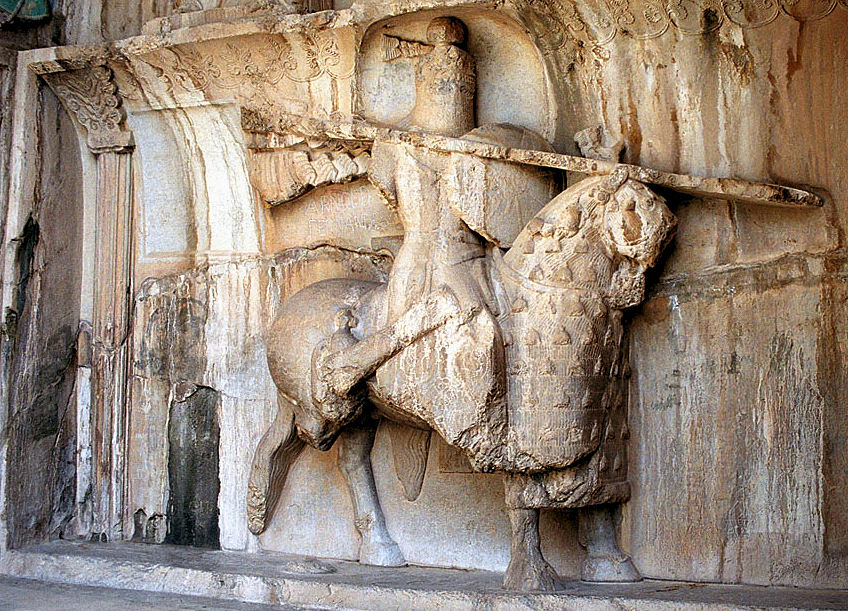
Abb.: कुन्तः । Chosrau II (خسرو)
(regierte 590 - 628) in parthischer Rüstung mit Contus (Kontos), Taq-e
Bostan - طاق بستان,
Iran
[Bildquelle: Philippe Chavin / Wikimedia. -- GNU FDLicense]
"The prāsa (prāśa), from its name a projectile, is sharp and broad, as well as spotless. Its edge is particularly spoken of (see lists above), but I see no Epic reason for claiming that the prāsa was the same as the quoit, or the trident. Wilson says it is the 'quoit, or the same as kunta.' Later works than the Epic make the prāsa the same as the discus, cakra, or a spear of seven cubits." [Quelle: Hopkins, Edward W. (Washburn) <1857 - 1932>: The social and military position of the ruling caste in ancient India; as represented by the Sanskrit epic; with an appendix on the status of woman. -- Reprint from the 13th volume of the Journal of the American Oriental Society (1888). -- New Haven, Conn. : Tuttle, 1889 -- S. 292]
|
61c./d.
prāsas tu kuntaḥ koṇas tu striyaḥ
pāly-aśri-koṭayaḥ प्रासस् तु कुन्तः कोणस् तु स्त्रियः पाल्य्-अश्रि-कोटयः ॥६१ ख॥ [Bezeichnungen für Schneide, Spitze:]
|
Colebrooke (1807): "Sharp edge of a sword. Some say its point."
पालि - pāli f.: Ecke, Rand, Kante
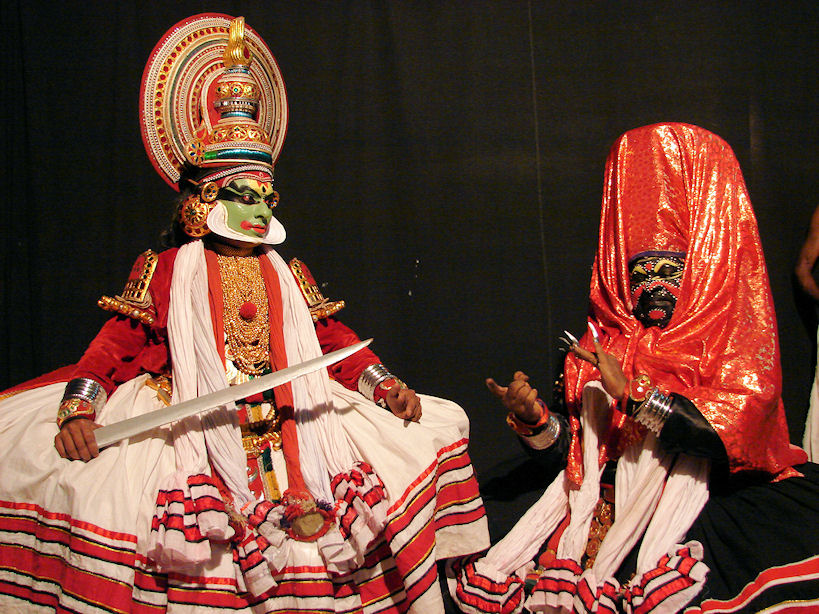
Abb.: पालिः । Kathakali (കഥകളി),
Varkala - വര്ക്കല, Kerala
[Bildquelle: Ian Evans. --
http://www.flickr.com/photos/warphed/2374568512/. -- Zugriff am
2011-06-16. --
Creative
Commons Lizenz (Namensnennung, keine kommerzielle Nutzung, share alike)]
अश्रि - aśri f.: Schneide, Kante
कोटि - koṭi f.: Spitze
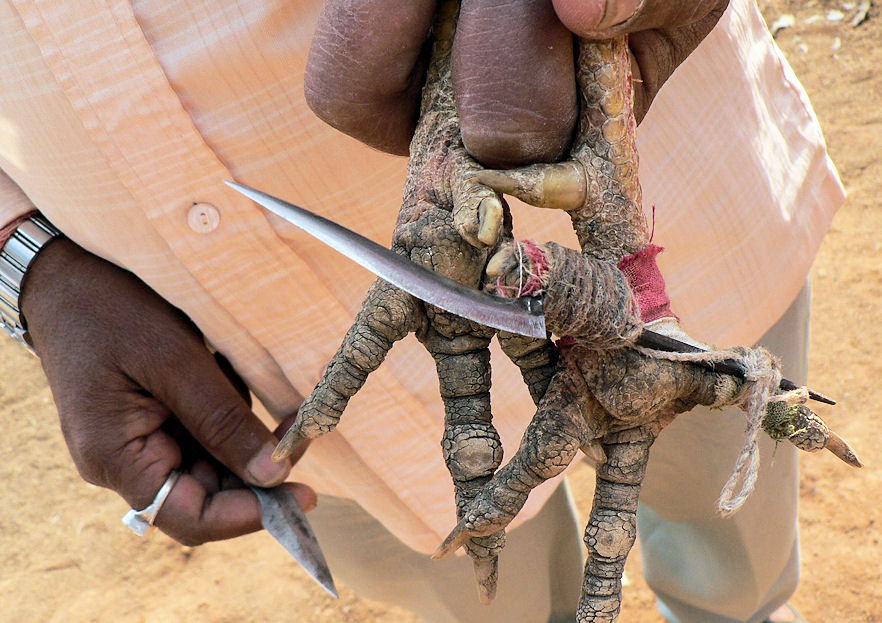
Abb.: अश्रिः कोटिश्च । Schneide an Fuß eines Hahns für Hahnenkampf, Orissa
[Bildquelle: rajkumar 1220. --
http://www.flickr.com/photos/ahinsajain/5621629988/. -- Zugriff am
2011-06-16. --
Creative Commons Lizenz (Namensnennung)]
Zu kṣatriyavarga II. -- Vers 62 - 88 (Schlacht)